

How to Write a Story Outline
Sean Glatch | November 17, 2023 | 8 Comments

The story outline is a great bridge between your story idea and a polished work of fiction. When you’re not sure how to start writing a story idea you might have, working on an outline will save you time and frustration, while also generating new ideas.
Some writers balk at the idea of using a story outline, as they think the process constrains their creativity. If you approach story outlining properly, though, it won’t limit your creativity—quite the opposite. Let’s delve into how to write a story outline, and why learning to structure a short story or novel will actually unlock its creative potential.
What is a Story Outline?
A story outline is a way for writers to organize the events of their story before they actually write it. It’s possible to do both short story writing and novel writing without a story outline, but when you’re not sure where to begin or how to continue, outlining your ideas can help you put one word in front of another.
The story outline is a sturdy bridge between your story idea and a polished work of fiction.
Story outlining isn’t something you master right away. Like fiction writing itself, writing an outline is a skill that you master over time. This article will suggest four different ways to outline your story, but these are just suggestions—the best outline will adapt to your writing style and methods.
How to Write a Good Story Outline Step-by-Step
The story outline process is intended to build your story from idea to finished product. This process will help you expand the components of the story into a workable piece of fiction. While these steps are only a guideline, they will almost certainly help you structure a short story or novel.
1. Start With Your Story Premise
A good story outline starts with your story premise . The premise is a 1-3 sentence summary of what happens in the story. Story premises mention the protagonist, the setting, and the conflict, while also highlighting what makes the story interesting.
A great story premise will introduce the central conflict with your characters, while highlighting what makes the story interesting.
Let’s take a story that most people are familiar with: Romeo and Juliet. A great story premise will introduce the central conflict with these characters, while a poor premise offers little in the way of structure and storyline. Here’s an example of a successful premise:
“Two teens, Romeo and Juliet, pursue their forbidden love with each other—to the chagrin of their rival families. When Juliet must choose between her family and her heart, both lovers must find a way to stay united, even if fate won’t allow it.”
This story premise tells us who the characters are, what their conflict is, and that their story explores—the themes of love and fate. The makings of a legendary story are written in these two sentences, ready to take the stage!
2. Flesh Out Your Characters
Once you have a story premise, start thinking about the characters in your story. What are their needs and motivations, how do they dress, what are their backstories, how will they respond to the story’s central conflict?
Most stories are character-driven in one way or another. Your characters advance the plot, explore the story’s themes, and help you reach new conclusions about life and humanity. When you don’t know what to write next in your story, thinking back to your characters’ psychology can often provide the answer. Do the work of fleshing out your characters now, and your story will develop a life and pulse of its own.
3. Build Scenes Around Your Characters
The world of your story should be just as alive as your characters. Whether your premise takes place on Earth or in a distant universe, your next step is to craft the world your characters live in.
When developing your scenes, consider the smallest details to add layers of visual and sensory description. Tell us where the action of the story is happening, then zero in on information to ground the reader. Consider details like the temperature, the color of the sky or the walls, the time of day, etc. Include unique descriptions and objects to make the reader fully present.
The world of your story should be just as alive as your characters.
Most importantly, tell us how the character feels in each scene. These emotional responses help navigate the reader through the world itself, coloring the story and driving the plot forward.
Scene writing helps you move towards structuring a short story or novel. You can order each scene based on your tentative idea for a plot, then start plotting the story itself!
4. Start Writing Your Outline
Once you’ve considered your characters, scenes, and your intent for writing the story, it’s time to start writing the actual outline. We haven’t yet explained how to write a story outline, and that’s because there are many different ways to write one!
Your outline takes all of the above information about your scenes, characters, and ideas, and it organizes that information in a coherent, linear way. The intent of an outline is to generate plot points to refer to as you write your story, but it also helps ground your story idea in a meaningful way.
Your outline will organize your scenes, characters, and ideas in a coherent, linear way.
The following four methods of story outlining are popular ways of jumping from idea to writing, but play around with your own outlines to figure out what works best.
Four Approaches to Writing a Story Outline
Good story outlines come in all shapes and sizes. If you’ve got the ingredients above, but you’re still not sure how to write a story outline that will work for you, here are four approaches you can try. Feel free to mix-and-match, and so on—these are not ironclad rules, but guidelines designed to support you.
1. The Plot-Based Approach
The most common way to outline your story is to create a bulleted or numbered list of plot points. Each bullet details the events that happen in each scene. Let’s use Romeo and Juliet as our example again; the following would be the first few bullet points in a plot-based outline:
- Members of the Montague and Capulet families are fighting in the streets.
- The Prince interrupts the fighting to warn that the next person who starts a fight will be executed.
- Later, the Capulets host a dinner to introduce their daughter, Juliet, to Paris, her arranged husband.
- Romeo, a Montague, sneaks into the party to see his current love Rosaline, but ends up falling in love with Juliet.
Each bullet point summarizes a basic plot element that will later be filled in with details. Obviously, Shakespeare’s story is filled with many more details than what the bullet provides, but this way of scaffolding a story allows you to build details around the basic plot.
2. The Scene-Based Approach
The scene-based approach adapts a plot-based outline to focus specifically on the scenes and world-building of the story. This is a great way to structure a short story—or even a novel!—if world-building and setting are central elements of your fiction. This is how you might take a scene-based approach to Romeo and Juliet:
- Verona is an independent city-state with its own Prince and monarchy.
- Verona emulates certain “Italian” traits like love and passion.
- The Capulets are a wealthy family and represent a caring, feminine household.
- The Montagues are also wealthy, but much more brash and masculine.
This approach uses world-building details to advance the story, letting Verona take charge of the tale. Of course, Verona is not the focus of Romeo and Juliet, so a scene-based approach probably wouldn’t have helped Shakespeare as much as it might help writers in fantasy, sci-fi, and magical realism.
3. The Themes-Based Approach
To write a short story or novel outline with a themes-based approach, you want to consider how the events of the story advance its ideas and themes . This approach works best if you have an idea of what you want your story to explore, though some writers need to figure it out as they write.
Consider how the events of the story advance its ideas and themes.
Here’s a themes-based approach to Romeo and Juliet:
- The story’s preface explores themes of love and fate, insinuating the story’s tragedy of a romance destined to fail.
- The tension between the Capulets and Montagues are explored, introducing the story’s masculine/feminine dichotomy.
- Romeo and Juliet complicate this dichotomy: Romeo is tender, delicate, and heartfelt, while Juliet is full of banter and says “un-ladylike” things.
This approach is certainly more conceptual and ideas focused, focusing less on the story itself and more on what the story offers. While it might not work for every story, you a themes-based approach will certainly benefit you if you know what you want to say, but not how to say it.
4. Freytag’s Pyramid
A last possible approach to take is to chart the story based on Freytag’s Pyramid . This approach will work best for writers who want a basic structure for their story, but don’t want to feel so confined that they lose their creative edge. All you need to do is write down the basic plot elements that correspond with Freytag’s pyramid, and you’re welcome to use as many or as few details as you like.
A writer can take the five basic elements of a story and craft a heart-wrenching tale of love and disaster.
The following is a simplified pyramid that corresponds to Romeo and Juliet.
- Inciting incident : Romeo and Juliet meet at the Capulet’s dinner party.
- Romeo and Juliet meet again after Juliet learns she is to marry Paris.
- Romeo and Juliet marry in secret.
- Juliet must find a way to escape Verona with Romeo before she is betrothed to Paris.
- Climax: Romeo kills Paris, and then himself, when he wrongfully believes Juliet to be dead. When Juliet finds that both men have died, she also kills herself.
- Falling Action: The two warring families agree to settle their disputes.
- Resolution: A brief exploration of the value and hardship of youth, love, and the cruelness of fate.
Freytag’s pyramid is the most summaristic of the above outlining strategies. Romeo and Juliet bears much more complexity than what this outline offers, but a writer can certainty take these basic elements and craft a heart-wrenching tale of love and disaster.
How to Write a Story Outline: Keep Experimenting!
Though you can’t completely write your short story or novel step by step using the frameworks above, you absolutely can set up a strong story by investing the time into creating an effective outline. Just like your writing, your story outlines will improve with practice, so play around with different formats and ideas! What’s important is that you explore the elements of fiction and expand upon your ideas.
Want to learn more about how to write a good story, or how to write a story outline? Take a look at our upcoming fiction courses , and let one of our award-winning instructors guide you through the novel and short story writing process. Reserve your spot in one of our courses today!
Sean Glatch
I will like to know if you offer free online beginning courses
Hi Jessie! We do not offer any free writing courses, but our Writing Tips section has tons of useful advice for beginning writers, and you’re also free to join our Facebook group for community and inspiration. Many thanks, and happy writing!
What kinds of outlines would you recommend for a poem?
I was having great difficulties on understanding what an outline is and how to make a good outline. This has really clarified me. Thank you
This helped me a lot, I was blank on outlines.
I wait to learn about it.
this was great! I have part of my story written, but not sure if its the beginning or the end of the beginning lol. This was a big help! Thank you for making it available for free! Happy Holidays
Creating the outline helped me navigate how I was going to build a story around a point I want to make (purpose of the story).
Leave a Comment Cancel Reply
Save my name, email, and website in this browser for the next time I comment.

Your Step-By-Step Guide To Writing A Story Outline
Writing a whole novel can seem like such a daunting task.
But it’s far easier to complete a novel if you break it down.
Writing a book outline is a really helpful way to break your story down into more manageable parts and to give you a clear guide on where your story is going and what to write next.
Let’s look at how to write a story outline, and we’ll give you some story outline examples to help you get started.
What Is a Story Outline?
You’ll write faster., it’s easier to write., there’s less chance of the dreaded saggy middle., an outline keeps your story on track., you can clearly see your character arcs., save time on editing., 1) start with your premise., 2) identify major plot elements., 3) get to know your characters., 4) explore your settings., 5) think about your theme., 6) choose your outlining method., 7) create your outline., 8) troubleshoot your outline., 9) starting writing, 1) snowflake method, 2) save the cat method, 3) fichtean curve method, 4) reverse outlining, final thoughts.
A novel outline is like a roadmap for your book. Just as you wouldn’t set off on a long journey to an unfamiliar destination without a map, writing a book outline can help you get from setting off from your home to reaching your destination.
Your novel outline is basically the skeleton of your story, including the structure, main plot points, and more, depending on how detailed you want to make it.
However, it’s not supposed to be a rigid, stifling, or limited document you’re not allowed to deviate from.
It’s supposed to be a helpful, loose guide that still leaves room for your imagination.
Don’t worry if you don’t already know everything about your story. You can still create a good outline and fill in the gaps as you go.
It’s also possible that however good your outline is, your characters will turn up and throw it out the window.
If that happens, go with it. It’s your characters that should drive the story. You can always tweak and adjust your outline as you get further into your story.
Things to ask yourself when you’re creating your outline:
- Who are your main characters ?
- Where are they when the story starts?
- What is your story’s setting?
- What is the inciting incident?
- How will your characters change over the story?
- What do your characters want?
- What is stopping your characters from getting what they want? The villain? Something internal? A combination?
- What are the stakes for your main characters?
- What is your theme?
It doesn’t matter whether you’re a plotter or a pantser, or somewhere in between. An outline can still help you write your story.
Plotters may want to get really detailed and plot out each individual scene and pantsers can still write a helpful outline but leave more to be decided as they write.
An outline can be anything from a simple list of handwritten plot points on a page to a whole wall of sticky notes or index cards.
Some people prefer the visual format of a mind map, some would rather use writing software, like Scrivener, and yet others work best with a typed, ordered list of scenes.
Why It’s Important to Create an Outline for a Story
It’s not compulsory to create an outline for your book.
You don’t have to if doing so doesn’t work for you, but if you can make it work, there are a lot of advantages to writing a book outline before you start writing your story:
With so many books out every month, it can be hard to stand out. One of the best ways to get attention is to use rapid release for your stories.
But one thing that tends to slow people down when writing is that they don’t know what happens next, and they have to spend time thinking about it before they can crack on with the story.
Write a novel outline, on the other hand, and you can speed away with your story because you’ve already worked out the whole thing from start to finish.
You can then release your stories more rapidly and keep your readers happy.
Not only can you write quicker, but it’s also easier to write and to ensure you don’t miss anything that needs to be there if you already have an outline of at least the story’s main points.
Hands up if you’ve ever started writing a novel and then realized that either you have no idea what happens in the middle at all or that what you’ve got just isn’t enough to keep the story flowing to the end.
That’s the saggy middle, and it’s not something you want. Use your outline to plan your middle and avoid the dreaded sag.
With a well-planned outline, you have a clear path from start to finish, and it’s easier to stay on track when you’re writing and ensure you’re still heading to the big finish you planned.
In most stories, the main characters grow and change over the course of the story. You can use your outline to map these changes out and then write your story without losing any of those changes.No more writer’s block.
Kick writer’s block into touch with a clear outline that you can easily follow to see what to write next and what comes after that.
That doesn’t mean you have to write in order if you don’t want to, but it should mean that you aren’t left staring at a blank page with no idea what to do next.
A great outline can save you a lot of time on editing. You might find that once you’ve written your story, there isn’t as much to change to make sure your story flows well and that you don’t have to edit too much in terms of the story structure.
You might also save yourself some money here because there may be less for your developmental editor to do.
9 Ways to Write a Story Outline: Your Step-by-Step Guide
At the end of this post, we’ll share some story outline examples where you’ll discover there are as many ways to outline your story as there are writers.
But that’s a very good thing. It means that if you want to outline your stories, you can find a way that works for you.
It might take some trial and error on your part, but you will come up with a way of outlining that helps you plan your novel and keep track of all the parts of your plot.
Your premise is the basic idea for your story. What happens and who does it happen to? Remember those questions we gave you in our section, What is a Story Outline? This is where you need them.
Start asking yourself about your story, who your main characters are, and what happens to them.
Look at the inciting incident that sets your main characters off on the path of following the story through. What are the obstacles along the way?
Who is the villain, and what are they up to? How will they try to stop your main characters from achieving their goal?
What is your story about? What is your theme? What tropes will you need to include to fit the genre?
Take some time to answer these questions and think things through, then write yourself a paragraph that summarizes your novel.
We’ve already mentioned the inciting incident – the event that takes place that propels your characters into taking action and doesn’t give them any choice in the matter.
In this step, think about the main elements of your story.
- What happens at the beginning when you introduce your main character? Where does your character start?
- What is the mid-point or mirror moment?
- What happens at the climax of the story?
- How does your story end?
Once you have these major points nailed, you are a good way toward having your outline done, and you have the major points to hand your scenes on.
You can’t finish your outline without knowing your characters really well. Your story should be character-driven, and action and dialogue should come about because you know what your characters would do next and how they would react to each challenge or occurrence in your story.
Use character sheets if it helps, and write down their basic information, such as physical description, any marks, scars, tattoos, eye color, hair color, and more.
If you’re very visual, try to find a photograph of an actor that would play your character in the movie of the book. That can help solidify your character in your mind and let you see and hear them.
Look at your story skeleton from step two and think about how your characters will react to these major points. You may well start coming up with scenes and dialogue at this point, which is great! Jot those down too.
Know how your characters change and grow over the course of the story. Most characters do develop and change in novels. There are very few characters that stay the same.
Get to know your settings as well as you do your characters. You want to be able to describe things in detail for your readers and bring them into the story.
In some cases, some settings may also contribute to the story and be either a part of the solution or a part of the problem.
If you’re familiar with the story of Odysseus or Jason and the Argonauts, for example, you’ll well remember the journey across the sea when they faced Scylla (clashing rocks) and Charybdis (the whirlpool), in a very narrow strait of water.
Don’t just think about what your settings look like. Add more description and help place the reader firmly in the story by thinking about what your settings feel like, smell like, and sound like.
More Related Articles
Everything You Need To Know About Abridged Vs. Unabridged Books And Audiobooks
9 Best Thesauruses For Writers
15 Copywriting Books That Should Be In Every Writer’s Library
Some writers only discover the theme of their stories as they write. If that’s you, don’t worry. You can still write an outline and then add in the theme later once you’ve discovered what it is. Just leave this bit blank for now.
If you’d rather decide on your theme before you start to write, or even better, if you already know what it is, write it down here.
It’s good to keep the themes of your story in mind both as you write your outline and as you write your story. You can then ensure that your story fits with your theme and what you want to say.
We’ve shown you some story-outlining examples above, but those are just some of the ways you could outline your story.
You could choose a specific outlining method, such as the Snowflake Method, follow the three-act structure, or you could create an outlining method that’s all your own just because that’s what works best for you.
Start to bring everything together here from the above steps. Go back to step two and start to add other major plot points, scenes, notes, and more to your list of the major plot elements.
Keep expanding your outline and adding in more details, including your character arcs, beats, and anything else you find helpful until you’re at a point where you think you’re done, and you’re ready to start writing.
While plotters may want to get into all the details in their outline, pantsers are more likely to want quite a light outline that they can then use to guide them as they discover the story as they write.
Give it a day or two, and then read back over your outline. Make sure every plot point and scene leads naturally up to the major plot elements and that the story flows.
See if there are any gaps and fill them.
Add in any other notes, scene ideas, and bits of dialogue that come up as you do this.
You’ve done it. Your outline is complete, and it’s now time to put it to use and write.
Use your outline as much or as little as you want as you write. Don’t forget that your story follows naturally from who your characters are and what they would naturally do under given circumstances.
If you find that your characters are going in a different direction or that you get better ideas as you write, then go with them. If things don’t work out, you can always look back at your original outline for help.
Story Outline Methods and Examples
Honestly, there really isn’t one best way to outline your novel. There’s only the best one that works for you. Here are just some story outline examples to show you how you could outline your story.
Try different ones to see which one you prefer, or try adapting the parts that work for you from different methods.
This method was invented by Randy Ingermanson. He was a software architect, and when it came to writing novels, he found himself using the same method he used to design software to write his novels.
He wrote this method up to share with other writers, and many writers find this a helpful way to outline.
You start by writing a single-sentence summary of your novel. This should be a compelling hook to draw your readers in. Get it right, and you can also use it in your marketing copy.
Next, you expand the sentence to a paragraph, which includes the start of the story, the major points, and the end of your story. You now have a short overview of your novel.
Next, add a one-page in-depth summary of each main character. Then go back to your paragraph summary and expand every sentence in that summary into another paragraph.
Keep expanding your novel outline until you have a full, highly-detailed outline and character sketches of your major characters.
You can read Randy’s full description of the Snowflake Method on his website .
Save the Cat was originally a method for writing screenplays by Blake Snyder, a Hollywood screenwriter. It is equally effective for writing novels.
It’s called Save the Cat because so many novels have that moment where the main character does something to make the reader feel for them and root for them, for example, like saving a cat from a tree.
With Save the Cat, you follow a beat sheet, which breaks down the three-act structure, and simply fill in a couple of sentences for each beat to describe what you’ll need to know or what happens in each beat.
This then gives you a good overview of your novel and what has to happen at each point.
You can read more and download beat sheet examples at the Save the Cat website .
This method is commonly used for thrillers where you want the reader to feel right in the middle of the action from the get-go.
The first two-thirds of a story plotted with this method are known as “Rising Action.” The next point in the story is the “Climax,” and then what follows is known as “Falling Action.” It’s easy to see how thrillers fit this method particularly well.
Most thrillers start off at break-neck speed and take the reader through fast-paced action that’s all heading in the direction of the climax of the story.
Then, once the climax is reached, the story continues into falling action where explanations are given, the bad guys get their just desserts, and any romance is wrapped up nicely.
The pattern of the Fichtean curve tends to look like this:
Crisis 1, Crisis 2, Crisis 3, Climax, Falling Action.
Think about your story and see how you can plan all the action to fit this format.
This method is exactly what it sounds like. Start at the end and then work your way back to the beginning to see how you’ll get to that ending.
This method can be particularly helpful for murder mysteries and thrillers. You can work backward from “who dunnit” and why, working out the steps they took to commit the crime.
As you go, you can also fill in how the detective or hero/heroine of the story works it out. It’s then much easier to go through and add twists to the plot and plant clues and red herrings for your readers to follow.
When it comes to outlining, there are so many different ways to approach it. Whether you’re a plotter or a pantser, an outline can make a big difference when writing your story.
It can help you keep track of everything that needs to happen and allow you to write faster.
However, when choosing the best way to outline your story, don’t think you have to follow what anyone else does. Everyone is different, so outline in the way that makes the most sense to you.
Leave a Comment Cancel reply
This site uses Akismet to reduce spam. Learn how your comment data is processed .

Ebooks, Publishing, and Everything in Between
- Downloads & Pricing
- Advertising
How to Write a Compelling Story Outline: A Step-by-Step Guide
- on Mar 13, 2023
- in Writing Tips
- Last update: October 8th, 2023
- at 12:48 pm
Every great story is like a journey, and every journey needs a map. That’s where a story outline comes in. Just as maps help travelers navigate unknown places, a story outline helps writers navigate the twists and turns of their stories. It’s the backbone of the narrative, providing a framework for the plot, characters, and themes.
Many writers agree that using outlines makes them more productive and gives them a better chance at finishing their projects. An outline can also help writers avoid common pitfalls like writer’s block and plot holes, ensuring that their story is cohesive.
So, to help you cohesive and successful story, we’ll examine in this article how to write a story outline and show you some examples by famous authors.

What Is a Story Outline?
A story outline is a structured plan that guides you as you write your manuscripts. It typically includes a summary of the major events of the plot, the main characters and their motivations, the setting, and any other main themes or ideas that the story explores. It can be as detailed or as brief as you need it to be, but it has to be clear enough to provide a framework for your novel.
A well-constructed outline can help you stay organized and focused while writing, avoid plot holes and inconsistencies, and ensure that your stories are cohesive and engaging.
Why Do Authors Need an Outline Before Writing a Novel?
While writing your novel, you’ll inevitably encounter various obstacles, and one of the ways to avoid them is to develop a comprehensive outline. Here’s how this outline can help you:
- Saves Time and Helps in Avoiding Writer’s Block
One of the main causes of writer’s block is a lack of direction or uncertainty about where the story is going. When you have a well-structured outline, you have a roadmap that provides direction and helps you stay focused on the narrative. You’d then know what needs to happen next, which can help you overcome the blank page syndrome and keep the writing process flowing smoothly.
- Prevents Dead Ends
Have you ever started writing a certain plot twist only to discover thousands of words later that you’ve reached a cul-de-sac? You then start to revise your story or create new subplots to evade the brick wall you slammed into.
By creating an outline first, you’ll be able to stay on track and avoid the pitfalls of dead-ends and inconsistencies. Moreover, having a clear understanding of the structure and flow of events allows you to quickly identify and resolve potential plot holes before they become major issues.
- Encourages Creativity
Having an outline can allow you to fully explore the creative possibilities of your story. While some writers may view it as a rigid structure that limits their creativity, the outline can actually be a helpful tool as it provides a framework that allows you to experiment with different story elements and see how they fit together.
It can also help you brainstorm new ideas for the story by identifying areas where more development is needed. Besides, having a clear idea of where the story is going can free up mental energy that might otherwise be spent worrying about the plot or structure. This can give you the confidence you need to explore new creative ideas and take risks in your writing.

How to Write a Story Outline?
Plotting a novel can be a challenging task, but with a solid outline in place, it becomes much more manageable. And now that you know all the benefits of creating one, it’s time to grab your notebook (or keyboard) and follow these simple steps to master the skill of outlining.
Step 1: Develop a Premise
Having a clear premise provides a foundation for the entire novel. The premise is the central idea or concept that the story revolves around, and it helps guide its direction. When the premise is clearly developed, it becomes easier to identify the main characters, their goals, and the conflicts they will face. This, in turn, makes it easier to create a plot that is consistent with the central idea.
A clear premise also helps in keeping the story focused and preventing it from becoming too convoluted or scattered. Without it, you might find it tempting to include too many subplots or unnecessary details, which can make your novel feel disjointed and confusing.
To create a compelling premise, consider the following questions:
- What is the essence of the story that you want to convey to your readers?
- What is the central question or conflict that will keep them engaged and turning the pages?
- What are the emotions you want to evoke in them as they read the novel?
Step 2: Create Your Character Profiles
Next, start thinking about your main characters. Creating character profiles is a critical element in crafting a well-rounded story outline. By understanding the personalities, backgrounds, motivations, and goals of the characters, you’ll be able to better craft the plot and the conflict of the events.
For example, knowing the characters’ strengths and weaknesses can help in developing plot points that challenge them and force them to grow or change. A well-crafted backstory can also add depth and richness to the character, giving a more nuanced understanding of their behavior and choices as the plot unfolds. Additionally, knowing the characters’ motivations and goals can help you establish the stakes of the story and create a clear narrative direction.
Here are some steps to follow when developing character profiles:
- Identify the main characters: Start by identifying the main characters in your novel. Typically, this includes the protagonist, antagonist, and any major supporting characters.
- Develop their physical characteristics: Describe each character’s physical appearance, including their height, weight, hair color, eye color, and any other distinguishing features.
- Outline their personality traits: Determine the personality traits of the character, including their strengths, weaknesses, quirks, and habits. This will help you come up with characters that are realistic and relatable.
- Establish their backstory: Create a backstory for each character that describes their past experiences, including any significant events that have shaped their personality or worldview.
- Determine their motivations and goals: Identify what each character wants and why. This can help you create a clear and compelling narrative arc .
- Consider the relationships between that character: Reflect on the dynamics between each character and how their relationships evolve over the course of the story.
Step 3: Create Your Plot
The plot is the sequence of events that make up the story, and it provides the structure that the outline will follow. Once you have a general idea of what your novel is about and what your characters are like, you can start developing the plot by figuring out the major events and turning points that will occur in the story. This can include things like the exposition, the climax, the resolution , as well as any other key moments that you want to include in the story.
As you develop the plot, you will start to see how the story unfolds, and you can use this information to create a rough outline. This can help you see the big picture and fill in the details as you go. You’ll then be able to ensure that the events flow smoothly and that all of the pieces fit together in a way that makes sense.
Step 4: Determine the Setting
The setting is the when and where of the events in your novel. Deciding on the setting provides a clear and concrete background for the events and actions that take place. This, in turn, can help you in ensuring that the story is consistent and believable, and that the events make sense in the context of the setting.
Additionally, the setting influences the mood and tone of the novel, as well as the behavior and motivations of the characters. By establishing the setting early on in the outlining process, you can ensure that it’s fully integrated into the story and that it enhances the overall impact of the narrative.
Step 5: Build the Scenes
Now it’s time to bring all the above elements together and start building the main scenes. When done right, this will provide a clear structure for the plot. By identifying the major events and actions that move the story forward, you’ll be able to organize your ideas and ensure that it flows logically and cohesively. Furthermore, knowing the main scenes allows you to avoid unnecessary deviations or subplots that can distract from the main storyline.
Having a clear idea of the main scenes will also facilitate developing the characters; by considering how each character responds to the key events, you’ll be able to create more dynamic and believable characters with a clear motivation for their actions.
Step 6: Fine-Tune the Outline
The last step in perfecting your outline is ensuring that all the elements of your novel fit together and that the flow of your story goes smoothly. All you need to do now is identify any areas that are redundant or have major plot holes. And don’t forget to make sure that premise of your story is reflected in the outline in a logical and meaningful way.

What Are Some Common Outline Formats?
While the steps we provided above will help you in writing a compelling outline, it is not the only way. In fact, there are many formats that writers use in crafting their outlines. The best format for a particular author will depend on their individual writing style and the specific needs of their story. But to give you a general idea of the most common ones, let’s take a look at these four examples.
- The Synopsis Outline
Usually used by authors to pitch agents, the synopsis outline gives a broad idea about the novel and how it progresses. However, many writers use it to outline their thoughts and ideas before they start the writing process.
To make the best out of this outline format, start by creating a short document, usually a page or two, that provides a broad outline of the novel’s premise and structure. You can then include a description of the characters, conflict, and narrative arc.
You can break down your synopsis into a few paragraphs:
- The first paragraph should introduce your two main characters (the protagonist “hero” and antagonist), how the story begins, and the setting of the story.
- The next few paragraphs include the plot twists faced by the hero. You may want to introduce other essential characters as well, such as sidekicks.
- In the final paragraph , you should explain how the major conflicts are settled, and give a glimpse of how the novel ends.
Here’s a downloadable example of the synopsis outline .
- The Snowflake Outline
If you prefer to focus on the big picture in your outline, then this method is ideal for you. Created by author and writing instructor Randy Ingermanson , this technique allows you to start with a basic summary and add elements from there. Just as you start drawing a snowflake with a single line, your story outline starts with a simple sentence.
Here’s how it’s done:
- Start off with a sentence summing up the novel’s premise in 15 words or less.
- Then expand it into a paragraph, adding the characters and the narrative arc.
- Proceed to create character summaries and gradually build the summaries into full character profiles.
- Create a list of the major scenes and organize them into a logical sequence. Then write a paragraph describing each scene.
You can now combine these parts into a document and expand upon it to write your story. To better understand this outline format, take a look at this one of J.K. Rowling’s novel, Harry Potter and the Philosopher’s Stone.
- The Summary Outline
This format involves estimating the number of chapters and creating a beat-sheet document, listing the sequential plot events. Each chapter is then summarized with a distinct purpose, encompassing descriptions of characters, settings, and timings.
This method allows you to focus on the big picture of the story while giving you a clear idea of what should happen in each chapter. You’ll find it most useful if you prefer a flexible approach to writing and don’t want to be too rigidly tied to a specific structure or plot.
You can also download this example of the summary outline of The Great Gatesby by F. Scott Fitzgerald.
- The Hero’s Journey
The Hero’s Journey is based on the idea of a hero’s transformation through a journey. It isn’t a format per se–rather a story structure–but it is used by many writers to create an outline and guide the development of the plot. It is particularly useful for stories that revolve around a character’s personal transformation and growth, as it offers a framework for creating a compelling narrative arc that captures the hero’s journey from a state of naivety to one of experience and wisdom.
This journey typically consists of three main sections: departure , initiation , and return . The departure stage involves the hero leaving their ordinary world, which is followed by the initiation stage, where they face various trials and tribulations. The return stage sees the hero return to their ordinary world, transformed by their experiences and equipped with new abilities and insights.
Each of these stages contains a number of steps that describes the hero’s transformation into a wiser personality by overcoming certain obstacles. To understand more about these steps, take a look at this outline example .

Tips for Creating a Story Outline
Crafting a story outline can be a daunting task, especially if you’re not sure where to begin. Fortunately, there are several tips and tricks that can help simplify the process. Here are some effective strategies for creating an outline:
- Decide on a Story Structure Before Outlining
When you first start writing your outline, it will be very tempting to jot all your thoughts down in an unorderly fashion so as not to lose any of the ideas in mind. However, having a clear understanding of the story structure will make writing the outline much easier.
This structure shows how the events are organized into a clear beginning, middle, and end. Knowing how your story unfolds will help you know where to place the scenes and events to produce a logical and coherent storyline.
- Use a Template
Using a template to outline your novel can provide a structure and guide that you can follow, which can help organize your thoughts and ideas more effectively. A template can also ensure that important elements (such as character development, plot progression, and setting details) aren’t forgotten.
Additionally, a template can save time and energy, as you won’t have to create a new outline from scratch every time you begin a new project. And if you’re stuck on the format of your outline (or simply want a jumpstart), a template is all you need. You can use any of the examples we’ve provided in the previous section as a guide to create your own outline, or click here to find more templates that fit all types of stories, novels, and other written work.
- Visualize the Story
There are many tools that authors use to visualize the outline of their stories. For example, you can use mind maps or sticky notes to plan how the story progresses.
Using mind maps is a popular way to outline novels and stories. This method can be a fun and creative way to brainstorm ideas and organize your thoughts. It allows you to see the relationship between different ideas and scenes and can help you create a cohesive and engaging story.
Other writers prefer using sticky notes with several colors to visually outline their novels. Sticky notes of the same color are used to represent the main chapters and are placed side by side. Then, using different-colored ones, notes that represent scenes in each chapter are placed below the corresponding main chapter. This can help you clearly see the flow of events and identify any plot holes the novel might have.
- Take Inspiration from Other Writers’ Outlines
Try getting a glimpse of the outlines of famous and successful authors. Seeing how they approached creating their own outlines can give you valuable insights and a fresh perspective on how to create your own. For example, take a look at J.K. Rowling’s outline for Harry Potter and the Order of the Phoenix, or Joseph Heller’s outline for Catch-22.

All in all, outlining is an essential tool that facilitates the writing of any novel. It helps you tackle numerous obstacles associated with writing such as writer’s block, redundancy, and plot holes. It also facilitates your writing process and keeps you focused. Keep in mind that each writer uses a different approach to outline their work. So always experiment and try new methods; eventually, you’ll reach the outcome you desire.
The Different Types of Editing Explained
Exploring the Different Types of Creative Writing
How to Write the Best Book Introduction (With Checklists & Examples)
Lynne Knudsen
Can this be used to create a documentary about a woman who founded an amazing village?
Absolutely! The principles of creating a story outline can be applied to various forms of storytelling, including documentaries. Start by outlining the key events, characters, and themes related to the woman who founded the amazing village. Then, organize these elements into a structured narrative that tells her story effectively.
Best of luck with your documentary project! 🙂
Leave a Reply Cancel reply
Save my name, email, and website in this browser for the next time I comment.
Currently you have JavaScript disabled. In order to post comments, please make sure JavaScript and Cookies are enabled, and reload the page. Click here for instructions on how to enable JavaScript in your browser.

Kotobee is the complete end-to-end ebook solution for you and your business. Export multiple formats. Deliver securely.
Create, publish, and sell ebooks with ease
Kotobee es la solución completa de ebooks de extremo a extremo para usted y su empresa.
Cree, publique y venda libros electrónicos con facilidad

Recent Posts
- Book Royalties: What They Are and How to Earn the Best Rates
- Game-Based Learning: What It Is, and How to Apply It
- How to Publish a Book for Free and Maximize Your Profit
- How to Become a Best-Selling Author: 5 Secrets for Success
- 12 of the Best Book Writing Software to Try in 2024 (Free and Paid)
- Entries feed
- Comments feed
- WordPress.org
Create a visual outline to keep your story on track
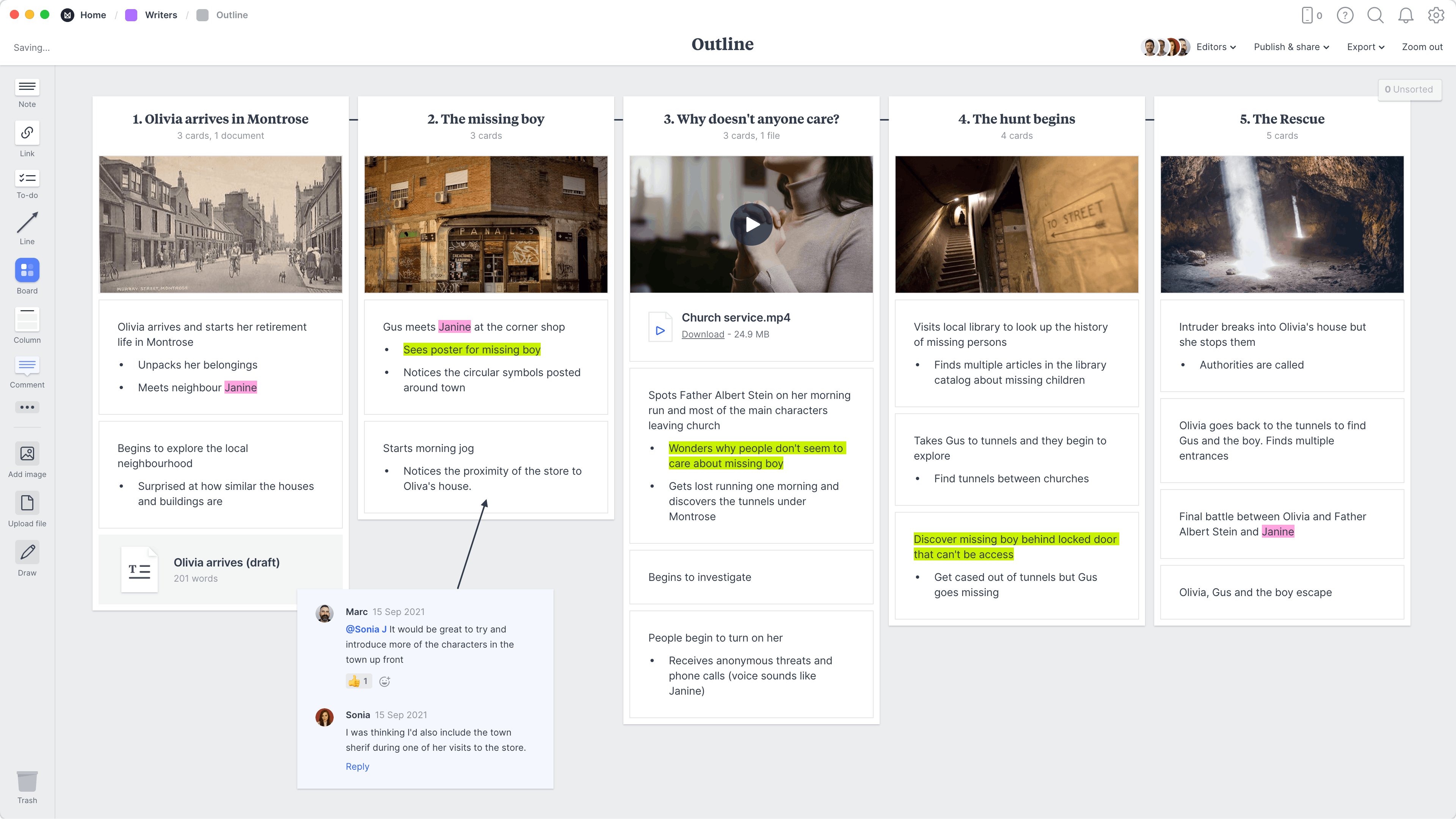
Follow this step-by-step guide to learn the modern process of outlining your story in Milanote, a free tool used by top creatives.
How to write a story outline in 6 easy steps
A novel outline is often described as a roadmap or blueprint for your story. It helps you see the big picture and plan the sequence of scenes, characters and ideas that will become your novel. It's a simple, flexible technique to help all types of writers stay organized.
There are many ways to outline your story, from the Three Act Structure to the Hero's Journey but this method is perfect for 'visual' writers—those who prefer to see the big picture as a sequence of events. Think of it as the modern, digital equivalent to the corkboard or wall of sticky notes, but much easier to manage. If you're keen to start outlining right away, grab the free Story Outline Template !
In this guide, you'll learn the modern approach to outlining a novel using Milanote. Remember, the creative process is non-linear, so you may find yourself moving back and forth between the steps as you go.
1. First, map out the key scenes
Start by laying out the major scenes or events you know so far. These might be the key turning points, locations, or plot twists. Don't worry too much about the order or details yet, just get the main parts out of your head. This is a quick flexible way to brainstorm the centerpieces of your story.
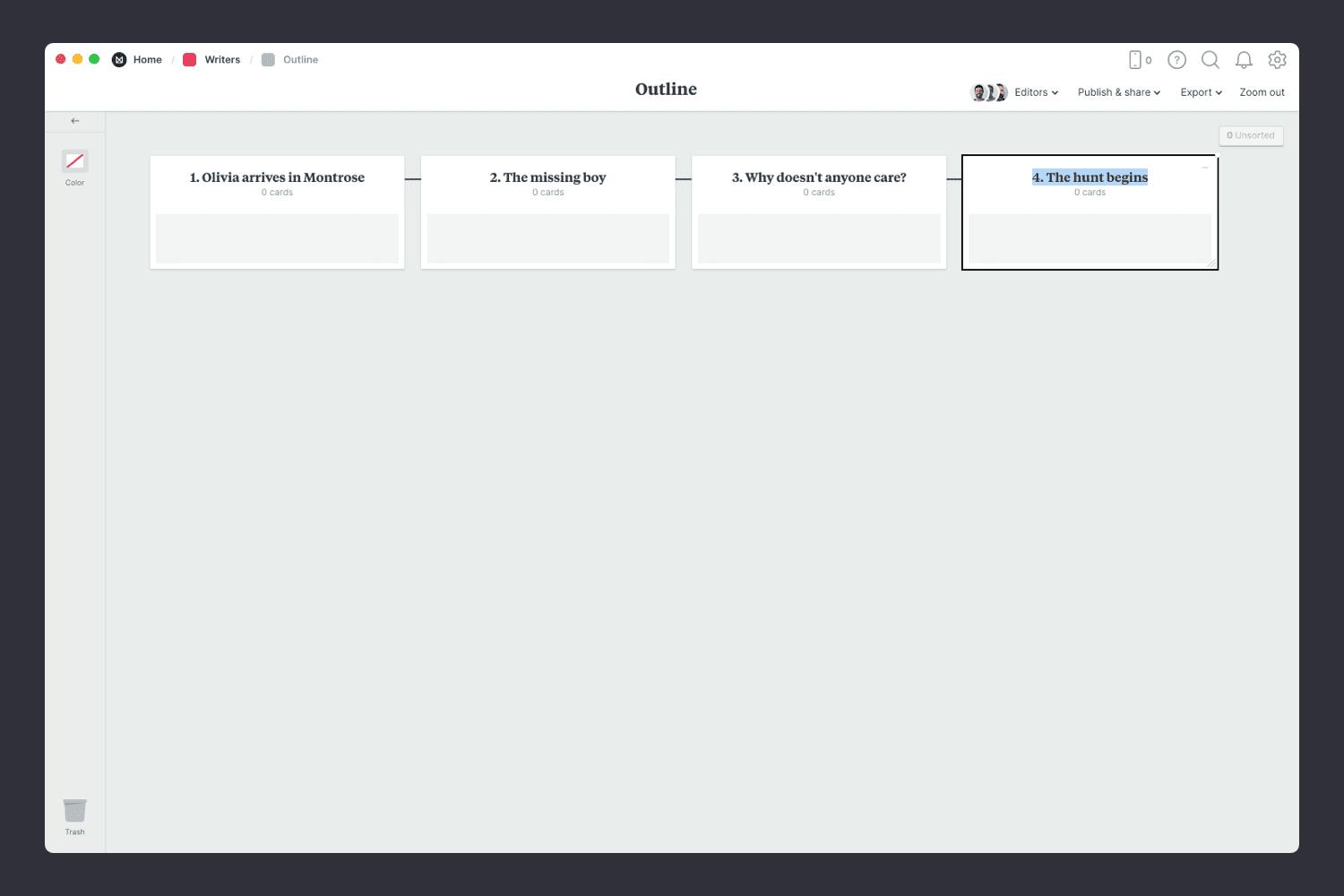
Create a new board for your outline.
Create a new board
Drag a board out from the toolbar. Give it a name, then double click to open it.
Add a Column for each key scene.
Drag a column onto your board
Name it, then drag any relevant notes or images into your column
2. Add high-level details
Next, add a sentence or a short paragraph for each scene. There are no rules for how much detail to add, do what works best for you. Think about what's being communicated in this scene, the location, and the characters involved. This will help you consider where characters are introduced and how this scene connects with the next one.
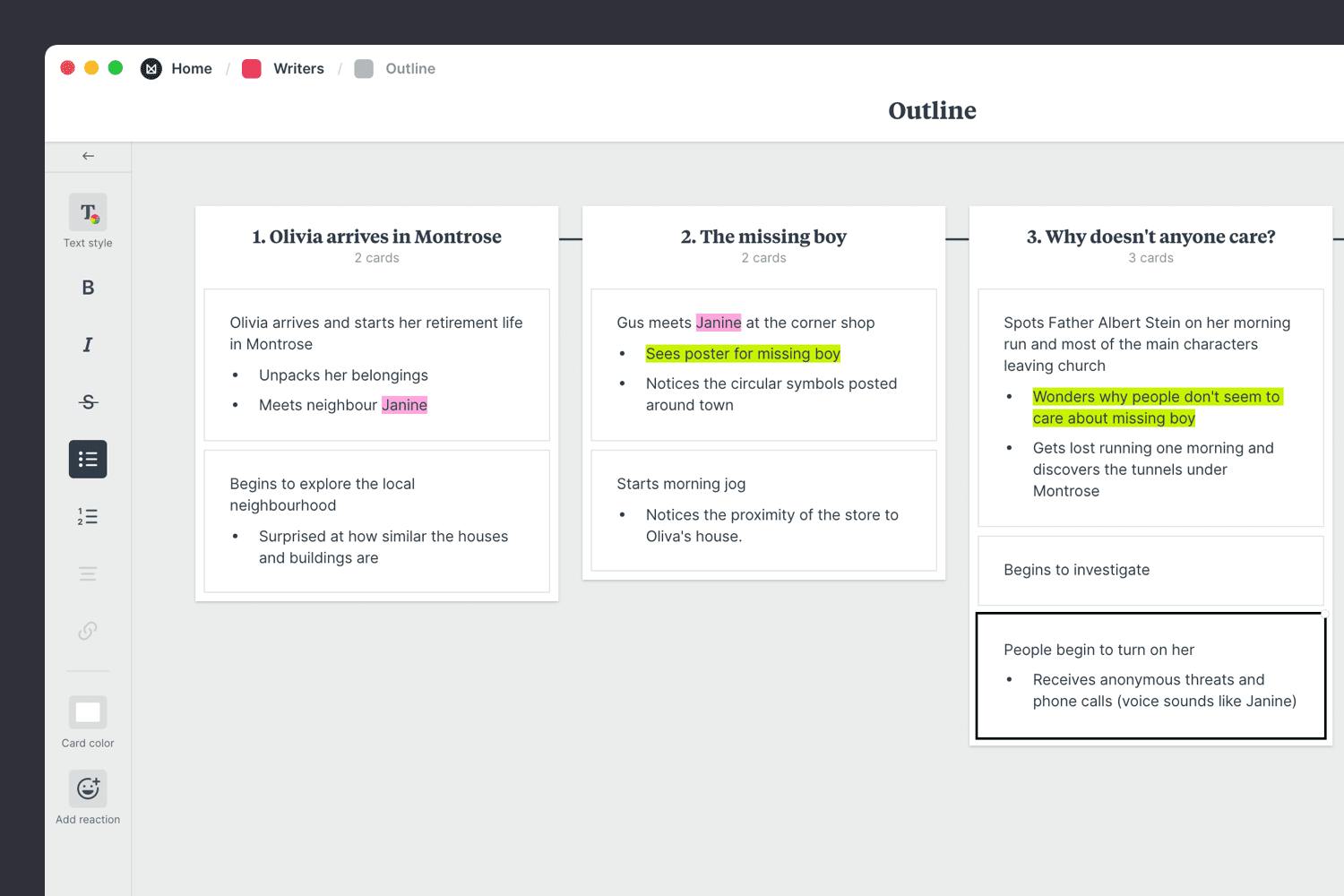
Add a note to describe the plot points.
Drag a note card onto your board
Start typing then use the formatting tools in the left-hand toolbar.
3. Get the sequence right
Seeing your story at this level lets you make connections between themes and concepts you might otherwise miss if you went straight into writing. Re-read your outline so far. Look for scenes that feel out of place. Perhaps your transitions need some tweaking or a character appears without a proper introduction. Highlight areas that need more work and move scenes or plot points around to get the sequence just right.
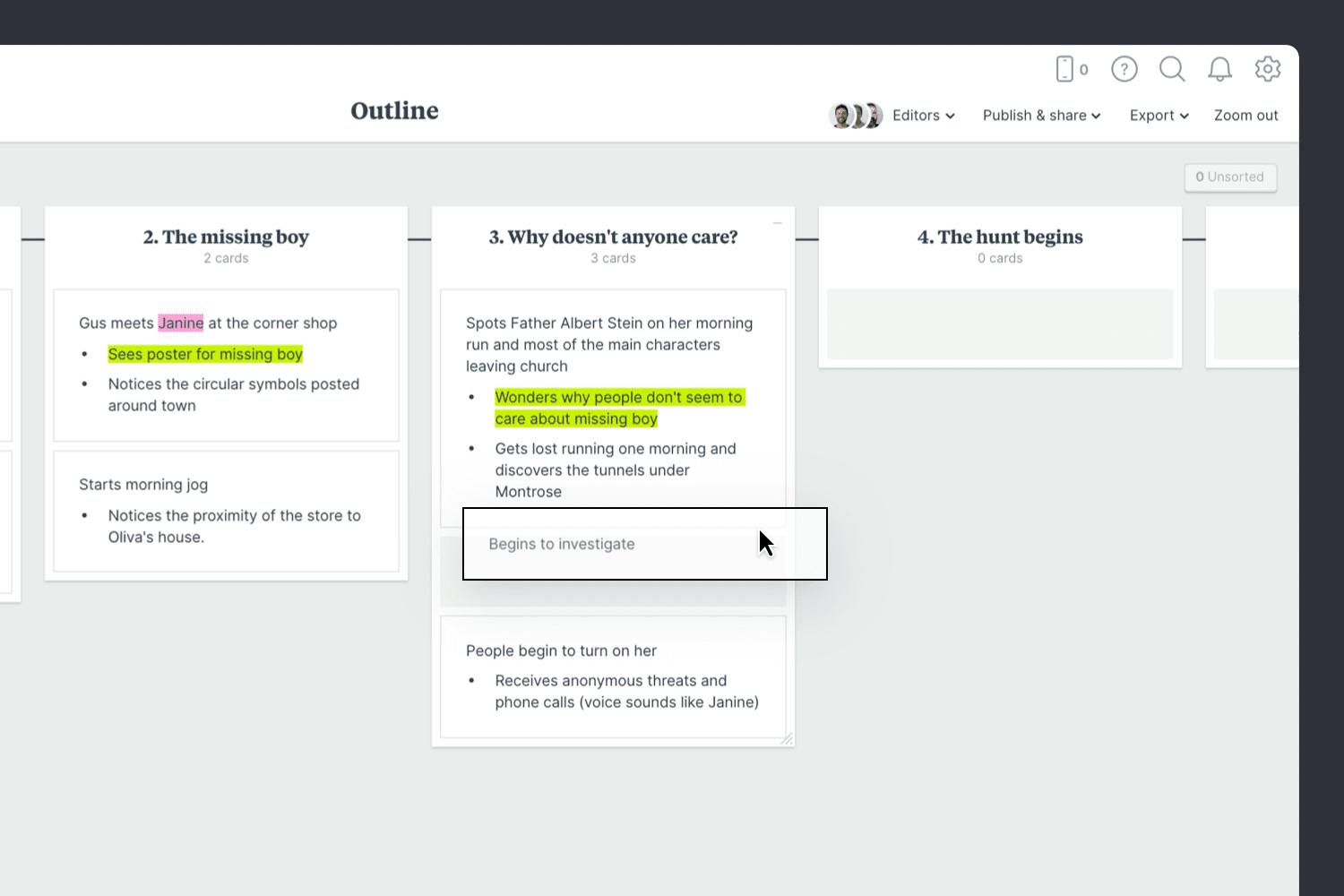
Drag plot points around to get the sequence right.
4. Add imagery or video
While imagery probably won't make an appearance in your novel, this is a great technique for kickstarting new ideas. Experiment by adding images or movie clips that relate to your scenes. If you're the type of writer who creates moodboards, now's the time to see if you've already got imagery that could help evoke the feeling you're trying to capture. Try saving images from Google Images , Pinterest , or Milanote's built-in image library.
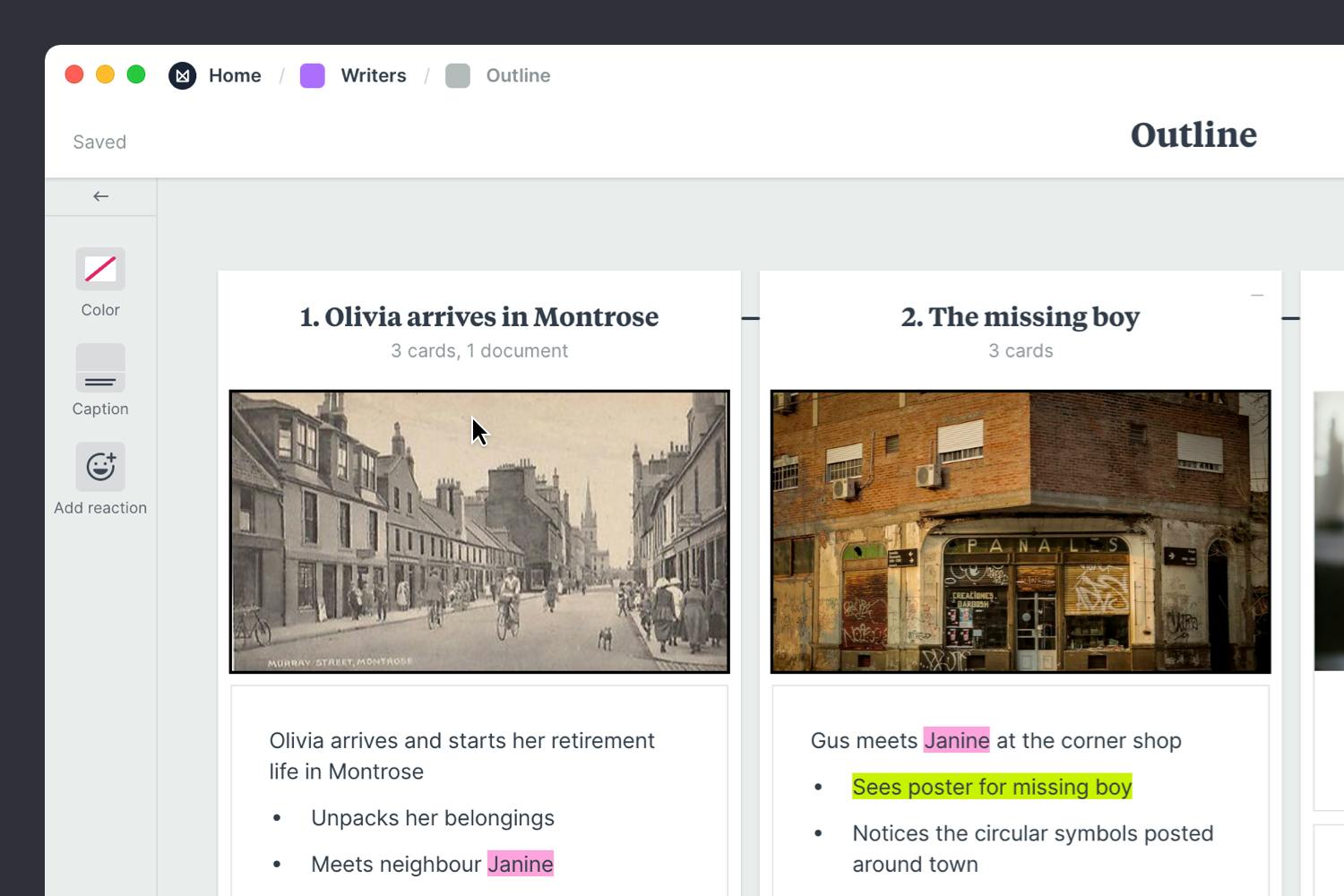
Use the built-in image library.
Use the built-in image library
Search over 500,000 beautiful photos powered by Unsplash then drag images straight onto your board.
Embed Youtube videos or audio in a board.
Embed Youtube videos or audio tracks in a board
Copy the share link from Youtube, Vimeo, Soundcloud or many other services. Drag a link card onto your board, paste your link and press enter.
5. Ask for feedback
With any creative technique or project, it’s important to be open to constructive criticism. Now that the first version of your outline is done it's time to ask for specific feedback on the sequence, plot points, and character development. Make sure you stay open to suggestions and improvements and try not to take criticism personally.
If you’re not sure how to deal with the feedback you get, writer Neil Gaiman has some insight: “Remember: when people tell you something’s wrong or doesn’t work for them, they are almost always right. When they tell you exactly what they think is wrong and how to fix it, they are almost always wrong.”
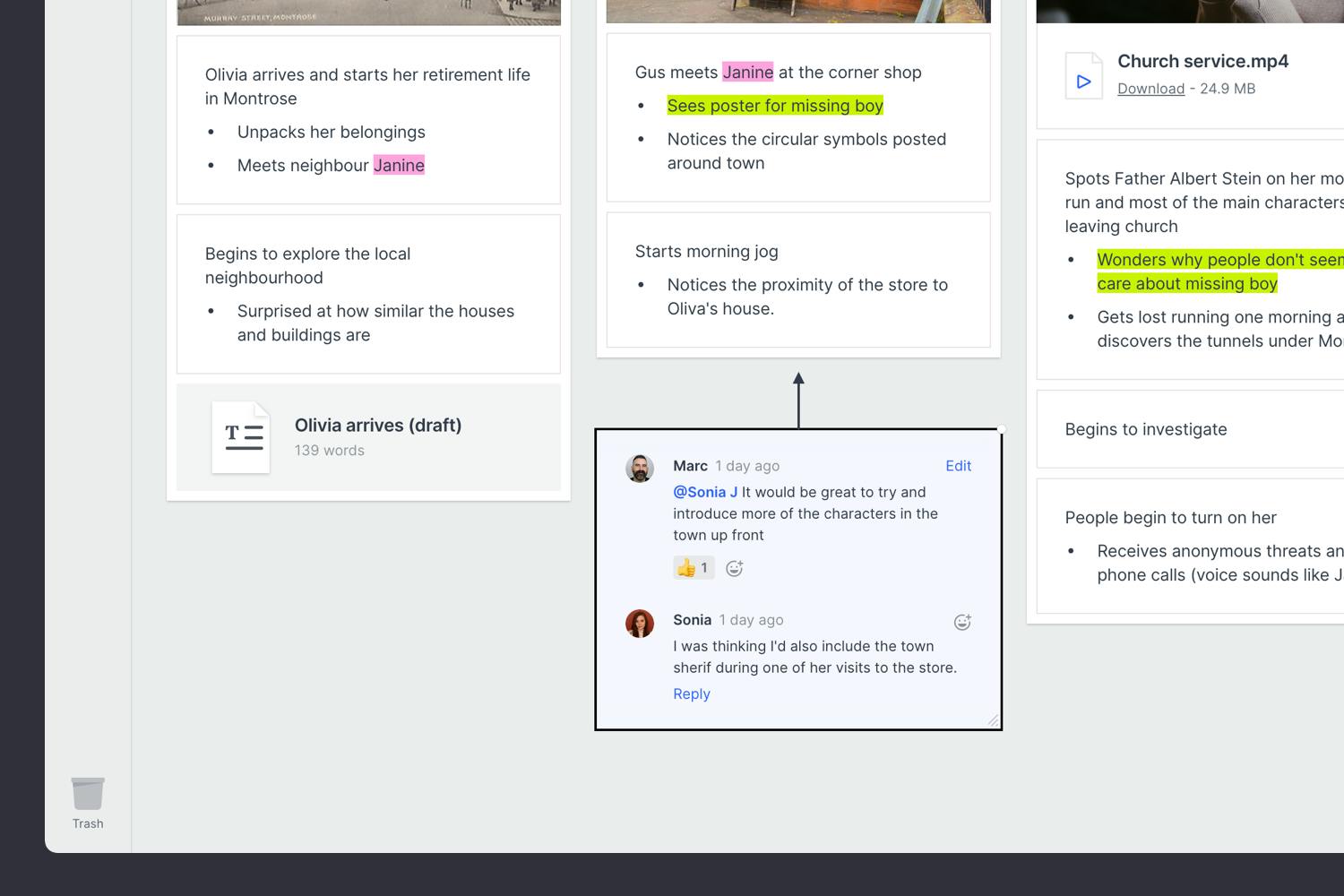
Invite a writing partner or editor to provide feedback.
Invite editors to your board
Open the "Editors" menu from the title bar of your board. Add email addresses of the people you'd like to collaborate with—they'll receive an invitation via email.
Start a comment thread.
Start a comment thread
Drag out a comment from the toolbar on the left and place it on your board. Other editors can reply to your comment.
Mention others to get their attention.
Mention teammates to get their attention
Type '@' in any text field to mention someone who has access to your board. They'll receive a notification and be able to respond to your comment.
6. Start a rough draft
Now you have a solid outline for your story and you've gathered constructive feedback, you can start sketching out the details in a draft. Your outline and your drafts are perfect companions. Jump between them as your need, switching ensures your story works at the high level and in the details.
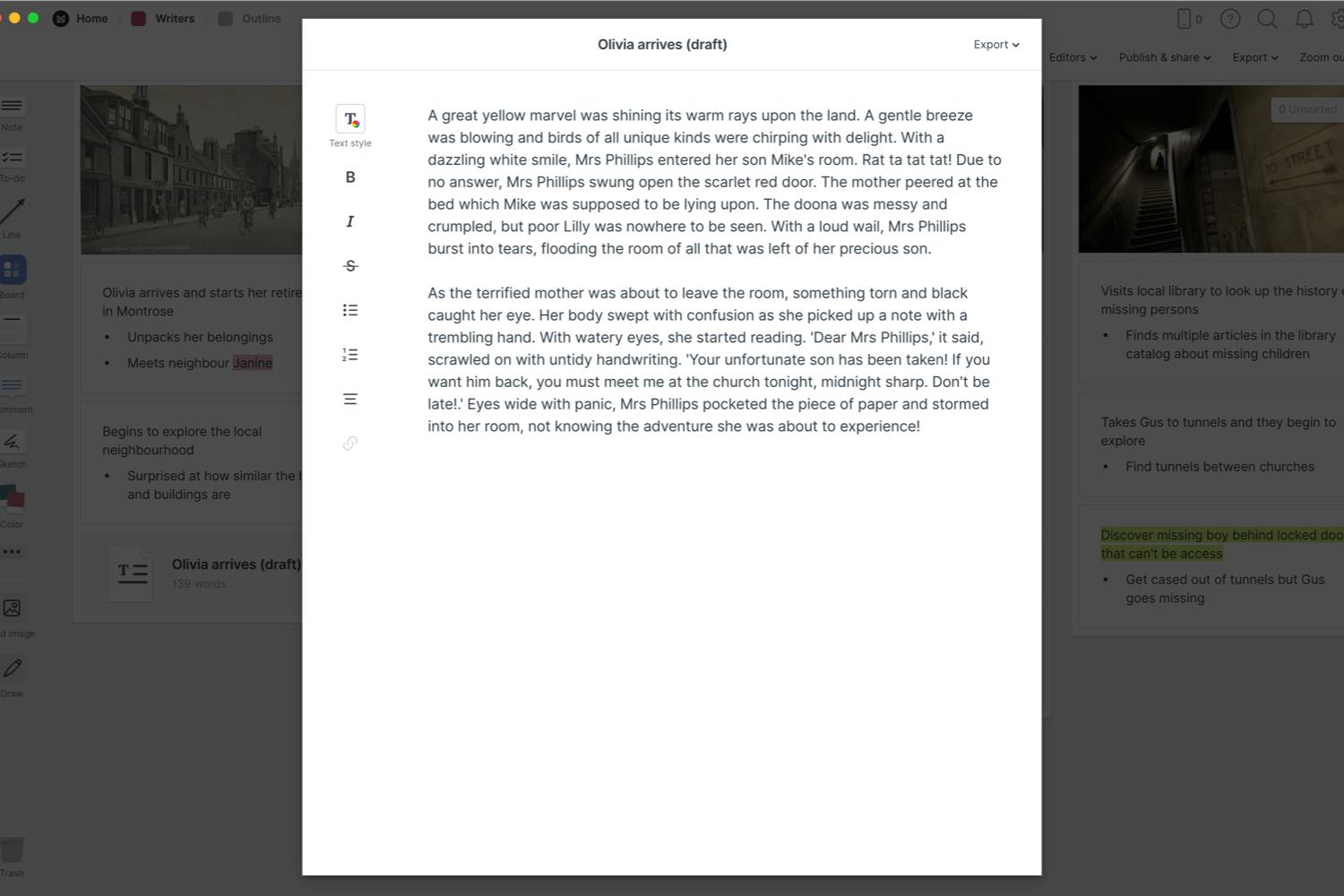
Drag a Document card onto your board and start typing
You're done!
Now that you've finished a draft outline, you can start writing, confident that your story has a strong foundation. If you're starting a new novel right now, use the free outline template below to start mapping it out or read our full guide on how to plan a novel .

Start outlining your next masterpiece
Get started for free with one of Milanote's beautiful outline templates.
Sign up for free with no time limit
Related Topics
- How to Write a Novel
- How to Write a Thriller Novel
- How to Write a Fantasy Novel
- How to Start a Novel
- How Many Chapters in a Novel?
- Mistakes to Avoid When Writing a Novel
- Novel Ideas
- How to Plan a Novel
- How to Outline a Novel
- How to Write a Romance Novel
- Novel Structure
- How to Write a Mystery Novel
- Novel vs Book
- Round Character
- Flat Character
- How to Create a Character Profile
- Author Overview
- Types of Writers
- How to Become a Writer
- How to Write a Book
- Writing a Book for the First Time
- How to Write an Autobiography
- How Long Does it Take to Write a Book?
- Do You Underline Book Titles?
- Snowflake Method
- Book Title Generator
- How to Write Nonfiction Book
- How to Write a Children's Book
- How to Write a Memoir
- Mistakes to Avoid When Writing a Book
- How to Write a Book Title
- How to Write a Book Introduction
- How to Write a Dedication in a Book
- How to Write a Book Synopsis
- Document Manager Overview
- Screenplay Writer Overview
- Technical Writer Career Path
- Technical Writer Interview Questions
- Technical Writer Salary
- Google Technical Writer Interview Questions
- How to Become a Technical Writer
- UX Writer Career Path
- Google UX Writer
- UX Writer vs Copywriter
- UX Writer Resume Examples
- UX Writer Interview Questions
- UX Writer Skills
- How to Become a UX Writer
- UX Writer Salary
- Google UX Writer Overview
- Google UX Writer Interview Questions
- Technical Writing Certifications
- Grant Writing Certifications
- UX Writing Certifications
- Proposal Writing Certifications
- Content Design Certifications
- Knowledge Management Certifications
- Medical Writing Certifications
- Grant Writing Classes
- Business Writing Courses
- Technical Writing Courses
- Content Design Overview
- Documentation Overview
- User Documentation
- Process Documentation
- Technical Documentation
- Software Documentation
- Knowledge Base Documentation
- Product Documentation
- Process Documentation Overview
- Process Documentation Templates
- Product Documentation Overview
- Software Documentation Overview
- Technical Documentation Overview
- User Documentation Overview
- Knowledge Management Overview
- Knowledge Base Overview
- Publishing on Amazon
- Amazon Authoring Page
- Self-Publishing on Amazon
- How to Publish
- How to Publish Your Own Book
- Document Management Software Overview
- Engineering Document Management Software
- Healthcare Document Management Software
- Financial Services Document Management Software
- Technical Documentation Software
- Knowledge Management Tools
- Knowledge Management Software
- HR Document Management Software
- Enterprise Document Management Software
- Knowledge Base Software
- Process Documentation Software
- Documentation Software
- Internal Knowledge Base Software
- Grammarly Premium Free Trial
- Grammarly for Word
- Scrivener Templates
- Scrivener Review
- How to Use Scrivener
- Ulysses vs Scrivener
- Character Development Templates
- Screenplay Format Templates
- Book Writing Templates
- API Writing Overview
- Business Writing Examples
- Business Writing Skills
- Types of Business Writing
- Dialogue Writing Overview
- Grant Writing Overview
- Medical Writing Overview
- Nanowrimo Overview
- How to Write 50,000 Words for Nanowrimo
- Camp Nanowrimo
- Nanowrimo YWP
- Nanowrimo Mistakes to Avoid
- Proposal Writing Overview
- Screenplay Overview
- How to Write a Screenplay
- Screenplay vs Script
- How to Structure a Screenplay
- How to Write a Screenplay Outline
- How to Format a Screenplay
- How to Write a Fight Scene
- How to Write Action Scenes
- How to Write a Monologue
- Short Story Writing Overview
- Technical Writing Overview
- UX Writing Overview
- Reddit Writing Prompts
- Romance Writing Prompts
- Flash Fiction Story Prompts
- Dialogue and Screenplay Writing Prompts
- Poetry Writing Prompts
- Tumblr Writing Prompts
- Creative Writing Prompts for Kids
- Creative Writing Prompts for Adults
- Fantasy Writing Prompts
- Horror Writing Prompts
- Book Writing Software
- Novel Writing Software
- Screenwriting Software
- ProWriting Aid
- Writing Tools
- Literature and Latte
- Hemingway App
- Final Draft
- Writing Apps
- Grammarly Premium
- Wattpad Inbox
- Microsoft OneNote
- Google Keep App
- Technical Writing Services
- Business Writing Services
- Content Writing Services
- Grant Writing Services
- SOP Writing Services
- Script Writing Services
- Proposal Writing Services
- Hire a Blog Writer
- Hire a Freelance Writer
- Hire a Proposal Writer
- Hire a Memoir Writer
- Hire a Speech Writer
- Hire a Business Plan Writer
- Hire a Script Writer
- Hire a Legal Writer
- Hire a Grant Writer
- Hire a Technical Writer
- Hire a Book Writer
- Hire a Ghost Writer
Home » Blog » How to Outline a Novel in 7 Steps [+Free Template]
How to Outline a Novel in 7 Steps [+Free Template]

TABLE OF CONTENTS
Are you intrigued by the mysterious process of writing, where authors often labor over blank pages only to discard them in frustration? The secret might lie in the art of outlining a novel.
While some writers balk at the idea of meticulous planning, outlining is a crucial step in crafting a compelling story. Whether you’re a seasoned writer or just starting, mastering the art of outlining can significantly enhance your storytelling process.
As Zadie Smith suggests, understanding your approach to planning – whether you’re a meticulous micro-planner or a laissez-faire creator – is key to shaping your narrative. So, before diving headfirst into your next writing endeavor, consider the immense value of outlining your novel. In this article, we’ll explore the steps to outline a novel.
Steps to Outline a Novel
Creating a novel outline involves jotting down main plot points, arranging them logically, and fleshing them out with details like character motivations and conflicts. Subplots can add depth, such as romantic entanglements or personal conflicts, but they should enhance rather than distract from the central story. Review and refine the outline as needed to strengthen the overall story structure, ensuring it serves as a roadmap for your writing journey.
Let’s explore the steps to create a complete and useful outline:
1. Understand Why It’s Important
A novel outline is a structure that helps you articulate ideas around the central theme of your story.
Here is an example of what the start of a novel outline looks like:
Think of something like this as a novel outline template, chapter by chapter. It summarizes your story, by significant events that will eventually make up chapters. Your story outline template is essentially the first draft you will prepare.
There may come times when you hit rock bottom and run out of ideas for your book . It could even be the almighty writer’s block .
If you know how to outline a novel, it will serve as an inspiring force to keep these situations in check. If you need a little extra help, consider using a novel writing template:
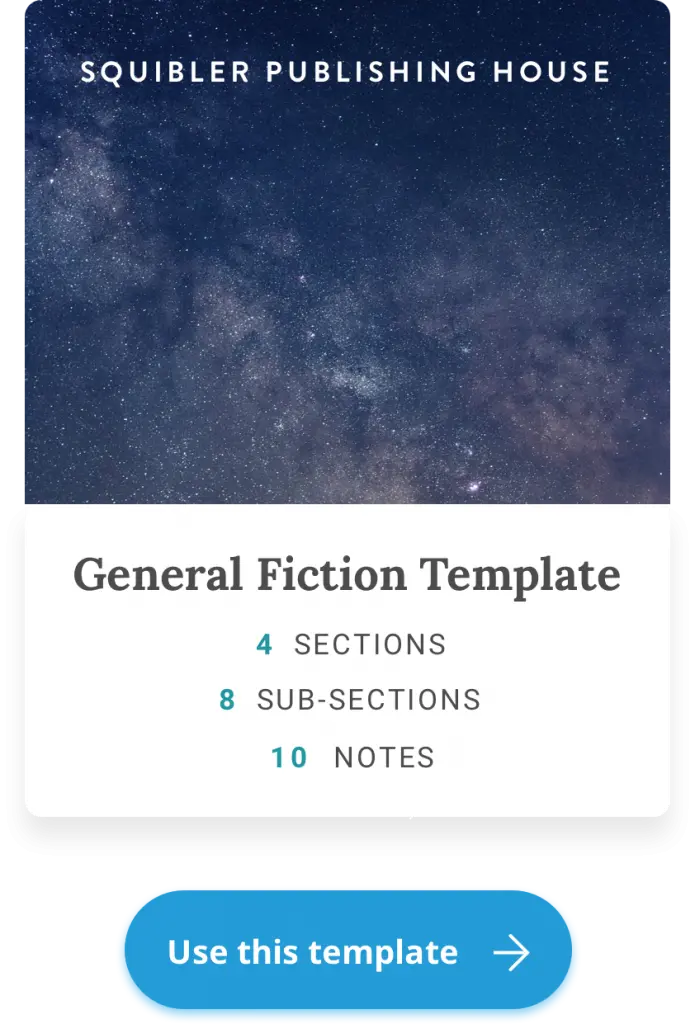
This template offered by Squibler will help you start a novel from scratch.
Squibler not only offers templates to work with, it also comes with an advanced AI writer. You input the details of your storyline into it and it generates content in a matter of seconds. In the big picture, you can think of Squibler as an AI assistant who works exactly as you command it. This way you not only stay ahead of the typical writer’s lane but also save 50% more time and energy.
A Novel Outline Template Saves You Time
When you have a structure on the ground, it will be easy to look back. You can reference a particular chapter, develop better ideas, and increase the pace of your writing.
It is always frustrating to begin writing even if you already know how to write a novel . Sometimes, you feel lost – as though the story wasn’t right to begin with.
The outline should be your companion, your go-to map to direct the storyline. Without knowing how to outline a novel, you won’t have anything to fall back on. In the end, if inspiration is lost, you might give up entirely.
This is another reason a novel outline template is a helpful place to start. With a good template, outlining a novel becomes much easier.
Squibler offers a novel outline template for many different purposes – from a basic novel outline to specific genres.
Even once you know the structure of a novel, each genre has different tropes, guidelines, and “rules” that make it work.
For example – the “happily ever after” is a staple of a true romance. Dramatic plot twists are what makes a thriller thrilling. A crime drama or mystery usually isn’t complete without at least one murder.
Following these genre rules doesn’t make your novel unoriginal. It makes it interesting, effective, and ultimately, successful.
Squibler’s novel outline templates will take you through the required elements of each genre and help you craft the perfect story.
This will save you copious amounts of time as you won’t be drowning in the novel’s plot holes and rewriting everything just to make it work.
Outlining a Novel Gives You Direction
When you write a novel with an outline in place, you know where you are headed. Without it, much of your writing will be random and unplanned. At some point, uncertainties will throw you off the path.
Your outline should be your map and your compass to navigate through the sophisticated process.
A Novel Outline Template Feeds Creativity
Some writers argue that having a fixed story outline template that guides your writing will stifle your creativity.
This is not true.
When there is an outline for your book, you know where to go if you are lost in character development or the milieu. A glance at your outline will remind you where you’re going. Staying on track will help the novel ideas flow.
The outline helps you gather your thoughts and creativity and make productive use of them. So, don’t settle for the school of thought that suggests knowing how to outline a novel is unnecessary.
2. Select a Novel Outline Type
In writing novels, there is no right or wrong method. The same thing applies to the novel outline.
There are different ways of planning your story. In the end, though, you want to be able to take your novel outline template chapter by chapter.
Scenes need to flow easily into each other and create logical, deliberate chapters. Regardless of exactly how you do it, each chapter should be covered.
If you have become frustrated with outlining a novel in the past, it could be because you didn’t take the time to find which type of outline best fits your writing style.
Below are the types of novel outlines you can use. It doesn’t matter if you’re writing fiction or nonfiction . Learning how to write an outline for a book is valuable and necessary.
A seasoned writer should know what this means, but how about first-time novelists ?
A synopsis is a brief overview of a story.
It contains holistic and detailed information about the story’s plot, major themes, characters, settings, and other elements of fictional writing.
Not sure how to create a synopsis for your novel? This guide on how to write a one-page synopsis by Amanda Patterson is sure to help you.
A typical synopsis summarizes the story in not more than three pages of a document.
Character Development
Any story centered on the role of one or two main characters requires a character-led novel outline.
Emphasis will be placed on the development of such characters and other character-centric elements like a character arc.
Here is an example of a character development template that you can use to get started.
Visual Outline
Every story is first conceived in the mind before it is brought on paper.
You can explore your mind, tap into your creative flair, and start to plan. You will be able to see the rises and falls, highs and lows, and every other thing you will need to tell the story.
Create a linking relationship between the characters, plot, setting, structure, themes, and conflicts. This will make the story cohesive and understandable.
Here is an example of what a visual outline for your novel could look like:
Here we see the inciting incident, some rising action, and major conflict. This is, of course, a very basic example. The point is, that you need to convert your mind into a map and explore its rich terrains.
You own the fictional world your characters are set in. Take what you see in your mind and replicate it on paper, even if you’re not an artist. This will help you see the story play out.
The Beat Sheet
Beat sheets are interesting structure templates to personalize novel outlines.
With a beat sheet, most likely in Excel format, you represent major plot items by point and detail them.
For example, after determining the structure your book is going to take , the next step will be to highlight the major plots and themes.
This is what a beat sheet looks like:
This is a useful, straightforward novel outline template that will help you create the perfect outline. Fill in the sections and answer the questions with your novel in mind, and everything will start coming together.
Next, you can begin to elaborate on each of the plot points one by one. Once you get some information down, scenes and chapters will start forming naturally.
Beat sheets are like thought holders. They hold ideas in concise lines and unleash creative thinking when you go back to them.
The Skeleton
As the name implies, this is a rigid but naked framework. All it comprises are major plot points.
Think of an outline as a human with mere bones. The shape is there, but there aren’t any notable or significant features. Here is an example :
When the book is eventually completed, it assumes that fuller, more attractive fleshy form.
The skeleton constitutes the pillar of your novel. It is like a road map with the major cities marked in large letters for easy navigation.
What does this mean?
With this outline, you navigate your thoughts, explore your fictional world, and bring that story together perfectly.
3. Leverage the Benefits of Using a Novel Outline
Despite your writing style and whether or not you’re an author who typically relies on a book outline template, it’s probably safe to say there are times you might wish you had one. Maybe.
I should note there are a few definitive cases for having at least a loose outline of your book. Even those who hate to outline will agree to this.
Keeps Your Plot Fresh in Mind
There are times you start a book and for some reason, you put it aside. Maybe you have another story burning to be told. Maybe you had to deal with sickness – your own or a loved one’s.
Assuming you don’t have total recall, after months—or perhaps years—do you remember your story? Is its plot and all its details? Or have you completely lost its thread? If you have an outline, it doesn’t matter what you’ve forgotten.
It Can Aid in Writing a Synopsis
Perhaps you’re intent on having your books traditionally published. If so, agents and publishers will often request a synopsis of your book.
Imagine this. The publisher you’re interested in requires a query letter, three chapters, and a synopsis. Often, you could wait for months to hear back from a given publisher, and depending on how quickly you wrote that was plenty of time to finish the book. Or at least motivate you to write faster . But you had to write your synopsis first.
That’s much easier to do if you have a detailed outline in place already.
It Can Help You Ease Into Writing in a New Genre
Templates and outlines are useful to writers new to a genre. Some genres have very specific story structures and arcs that need to be developed and followed. For example, if you’re thinking about writing a romance novel you need to meet reader expectations. An outline could help you meet them.
Let’s recap some reasons why templates or outlines may be good for some:
- Some writers, new or seasoned, are lost without one.
- If you have to leave off writing your book, you can come back to it any time.
- It’s much easier to write a synopsis when you already have an outline.
- If you’re new to a genre, an outline could be very helpful.
Outlining a Novel is a Process
A good novel outline template will be flexible enough for you to hop in at any stage and flow with ease. It should be a ladder with rungs that help you climb higher as you write more – not something that confines you to one rigid path.
A poor outline or no outline at all, just like a ladder with faulty rungs, will only make you collapse. Even if you have mastered how to write a novel, you will struggle without an outline.
We have analyzed the benefits of a novel outline. And we have discussed the various types of outlines.
Now, the question remains – “How does one begin outlining?” “Where do I start?”
These questions do have answers, though they will vary for every writer . Learning how to write an outline for a book is a different process for everyone.
4. Set the Stage
Just like in any field, poor planning will result in shaky structures that will later collapse.
If you don’t set the stage well for your characters to exist and your setting to be logical, the story won’t make sense.
A lot of time should be devoted to brainstorming.
Do you have a central idea?
Are there related and underlying themes that you need to capture in the story ?
Consider these and craft a perfect environment for them to thrive.
Another name for the central idea of your novel is ‘premise.’ It is the most basic component of your work. Without it, things will become messy.
Imagine you have learned everything on how to write a book , have finished writing that dream novel, and it is time to publish . When you take it to an editor, and they ask what your story is about, what summary will you give them?
What you respond with is the premise –the central idea of your novel.
If you can’t answer this question, you need to sit back and review the themes of your story. The answer to that question should also contain the reason for telling that story and writing that book in the way you did.
5. Develop Your Characters
The characters always make or mar a book.
How they are presented to the readers, and how their actions progress, are of concern to the literary world.
Why? Because p eople tend to have an emotional attachment to the characters in a book.
For you to come out with a great novel , perhaps a bestseller, you need to build your characters well . Know who they are, their attributes, and their features. How they function as individuals and how they view the world.
Since they are imaginary, although not totally (more on this soon), their wills are just at your fingertips, one snap and they obey. Create unique personas that are relatable, mysterious, and awesome.
Characters From Real Life
Now about characters not being entirely imaginary – most characters are built from the people we come in contact with.
That old pa in a train station, sinking into an armchair. The redhead in a movie theater with an obsession for pasta.
Characters can be sourced from many places. No doubt, they could also be solely the product of your imagination. This does happen, especially in the fantasy genre .
If you don’t know how to go about creating your characters, do some research. Just like when you don’t know how to write a book , you do research and learn all about it.
Take on a couple of character development tests and build a unique cast for your book. After creating them, test them to see if they can survive on the stage you have set.
Will their attributes allow them to function?
Will there be difficulties or flaws in their dealings?
You call the shots!
You can also store your characters in Squibler, and then invoke a scene around them by just entering a name. Squibler’s smart writer understands your character’s elements, and details and works around to generate a relatable plot. Here’s how the stored character info looks inside the Squibler:
6. Create a Structure
Now you have some of your elements ready – specifically the characters and plots.
Next, you need to give your book a structure . There are different structures that you can choose from.
It could be the three-act structure where your book is partitioned into three acts. This will have each ending flowing into the next to later ending in a resolution of the major conflicts.
If you need a headstart, check out this post on how to structure a novel. The structure will give you a clear picture of your story’s beginning, middle, and end.
This helps in summarizing the story and gives you coherence in writing; a structure helps you stay on track. There won’t be a need for unnecessary deviations that you’ll just end up removing later.
Even when new ideas come, your outline will help to articulate them and broaden the storyline. It will make them productive parts of the plot, rather than random additives.
7. Organize the Scenes
After mapping out the path that your story will trend, visually and in other formats, you should begin to break down the story into acts, sequences, and eventually chapters.
When you do this, you understand the progressive pace, and you are guided against jumping scenes and creating messy loopholes.
Scenes build on your central idea. Therefore, before creating and organizing scenes, think of how they will fit into your narration.
No reader should sense a forced organization in your book like the chapters are barely clinging to each other with no fluid transition between each one.
You can create suspense. How do you do this?
Jot different scenes in the normal, logical order of their occurrence. Then, try to reshuffle them without the story losing its distinctive beat and meaning.
Final Remarks
Once you finish with the previous steps, you will need to check the outline for leaky scenes –places that need better illustrations.
Highlight and review the outline. Be critical. Don’t be afraid to make changes and move things around.
You don’t have to get it right all at once; it’s acceptable to make mistakes. There is no right or wrong approach. Do what works for you and your story. Just remember – don’t neglect the importance of learning how to outline a novel properly.
Here is a list of questions that authors frequently ask about developing a novel outline:
Why is it important to create a novel outline?
Creating a novel outline helps you organize your thoughts and plot, providing a clear roadmap for your story. It prevents writer’s block by giving you direction and structure as you write.
How detailed should my novel outline be?
The level of detail in your outline depends on your personal preference and writing style. Some writers prefer a broad outline with just the main plot points, while others prefer a more detailed outline that includes subplots and character arcs.
Can I deviate from my outline while writing?
Absolutely! Your outline is a flexible tool, not a strict set of rules. Feel free to deviate from it if new ideas arise or if the story takes an unexpected turn. Adapt your outline as needed to accommodate these changes.
Should I create my outline before or after writing the first draft?
There’s no right or wrong answer to this question. Some writers prefer to outline before they start writing to have a roadmap to follow, while others prefer to write first and outline later to discover the story as they go. Experiment with both approaches to see which works best for you.
How do I know if my outline is effective?
Your outline is effective if it helps you stay focused, organized, and motivated throughout the writing process. If you find yourself straying from your outline too often or feeling lost, it may be a sign that you need to revisit and revise it. Trust your instincts and adjust your outline as needed to keep your story on track.
Related Posts
![how to write a story outline example How to Create a Character Profile in 12 Steps [+Free Template]](https://www.squibler.io/learn/wp-content/uploads/2021/12/How-to-Create-a-Character-Profile-in-12-Steps1.jpg)
Published in What is Novel Writing?
Join 5000+ Technical Writers
Get our #1 industry rated weekly technical writing reads newsletter.
Looking to publish? Meet your dream editor, designer and marketer on Reedsy.
Find the perfect editor for your next book
1 million authors trust the professionals on Reedsy. Come meet them.
Blog • Perfecting your Craft
Posted on Oct 12, 2018
The Snowflake Method: 6 Steps to a Powerful Story Outline
In the annals of ‘unhelpful writing tips offered to first-time novelists,’ Neil Gaiman’s oft-quoted opinion takes the cake: “You sit down at the keyboard and you put one word after another until it’s done. It's that easy, and that hard.”
If you’ve never written a novel before (and you don’t have an MFA in creative writing), it's only understandable that you’re daunted by the prospect of writing a book . This uncertainty is precisely why outlining systems, such as The Snowflake Method, are so appealing to developing writers.
If you want to find out how to use the snowflake method, feel free to skip ahead to this section . But if you have a moment, let’s first look at the basics of this popular approach.
What is the Snowflake Method?

The Snowflake Method is an approach to writing that encourages starting with the simplest premise possible. From there, you systematically expand it to include plot and character details. Developed by American author, physicist, and writing coach Randy Ingermanson , the method's end result is a comprehensive character bible and scene list with which an author can begin the first draft.
“My power flurries through the air into the ground. My soul is spiraling in frozen fractals all around” — “Let It Go” from Disney’s Frozen
Given Ingermanson’s background as a computational physicist, it should come as no surprise that his method was inspired by a mathematical principle known as a fractal. In particular, he references the Koch Snowflake to demonstrate how your story grows with each subsequent stage of the planning process .
It's probably no surprise to you to learn that every writer uses a different outline. If you're curious about the general outlining process, we dive deeper into the topic in this post on how to outline a novel. (Feel free to grab the free book outline template in there as well!) But for now, let's talk about the advantages of this particular method.
What are the benefits of the snowflake method?
Fans of Ingermanson’s method tend to enjoy how structured the process is. Not only does he lay out practical steps for outlining, but he also gives an idea of how long each step should take. For example, he suggests spending an hour on the very first step of honing a single-sentence story summary. Later on, when writing a character bible, he recommends spending a few hours on each character.

The Snowflake Method also identifies and fixes a common cause of Abandoned First Draft Syndrome: plot holes. It’s common for writers to be 20,000 words into a first draft before noticing major story issues that they need to go back and fix.
By working toward a scene list and, more importantly, synopses for every character, you can better identify plot holes before you even start chapter one. If the butler commits a murder in Chapter 20, you can make sure he isn’t imprisoned for life in Chapter 12.
With the help of the Snowflake Method, many writers have been able to follow-through and complete a draft of their novel where previously they may have failed.
How to use the Snowflake Method to write a novel (in 6 steps)
Without giving away every detail of Ingermanson’s process, here’s a quick look at how you can use the snowflake method to write a novel:
Step 1: Write a one-sentence story summary
Encapsulate what your novel is about in a single sentence. You might also call this ‘the hook’: a line that you can use in almost any situation to get anybody interested in your book .
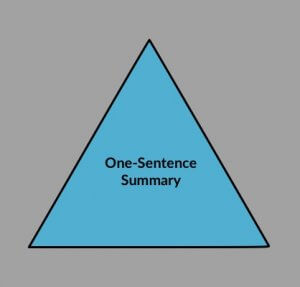
A revenge-obsessed whaler embarks on a deadly voyage to hunt the beast that took his leg.
Whisked away to a magical boarding school, an orphaned boy discovers that he’s a famous wizard.
This practice will be closely related to the theme of your novel . When constructing this single sentence, it’s important to avoid specifics. A character’s name isn’t as useful as a reference to their personal goal, for example. For this step, writers are urged to keep their sentence under 15-words long.
Step 2: Expand it to a one-paragraph summary
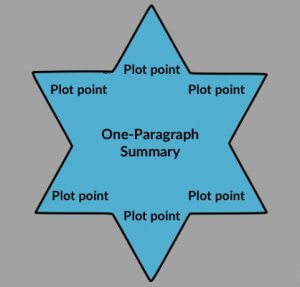
If you are imagining the snowflake metaphor , this is when the triangle turns into a star. Building off the details in your one-sentence summary, add a few elements here and there until you have retold your story in five sentences.
This is where you will introduce your major plot points. If you’re a fan of the three-act structure , you’ll want to include:
- The exposition (what is the status quo at the start of the story)
- The first plot point (what major event kicks off the story),
- The mid-point (where things take a turn for the worse), and
- Plot point two (where your character hits rock-bottom and starts turning things around)
- Climax and denouement (how the story resolves)
It’s worth putting time into getting this summary just right. You can always come back to revise it if things change, but having these plot signposts in place will help guide the next few steps.
Step 3. Start small with your characters
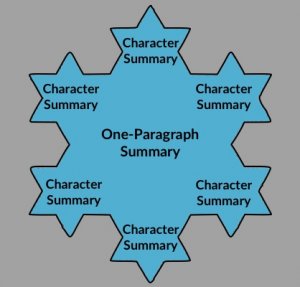
Now that you’ve started expanding your view of the plot, Ingermanson suggests shifting down a gear and painting your characters with broad brushstrokes.
This is where you identify all the major characters in your book, give them names and spend an hour identifying their:
- Motivations (what drives them in life)
- Goals (what non-abstract things do they want)
- Conflict (what prevents them from achieving their goal)
- Epiphany (how they overcome that conflict)
It’s worth bearing in mind both external and internal conflict . If a character’s goal is to get that big promotion, then their conflict might be with the bully from HR (external conflict) and their own self-confidence (internal conflict).
At the end of this stage, you’ll have an idea of the major players’ character arcs .
Step 4. Expand your one-paragraph summary into a single page
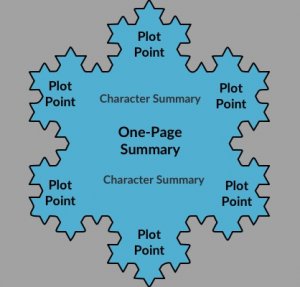
Ingermanson sees this stage as taking a few hours, as you blow out each sentence of your one-paragraph summary (step 2) into a full paragraph. To develop your story into blocks that are easy to understand and write, you can end every paragraph with what he calls a ‘disaster’ — which you might interpret as a major plot point or a cliffhanger.
Step 5. Character bibles and character synopses
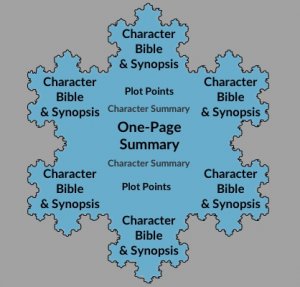
This is the first stage where you, the story designer, will roll up your sleeves and get your hands dirty. Armed with your short character summaries and your one-page plot, you will now create a one-page dossier for each major character (and a half-page for the minor ones).
If you want a bit more guidance, you can find various online guides to fleshing out characters, or download and fill out this free character profile template . By going deep into your major characters’ backstories, you’ll likely discover reasons why they might behave in a certain way during your story.
Once your character bible is complete, you then write a synopsis for each character. This involves outlining each character’s journey through the novel. This is perhaps one of the most useful parts of the snowflake method — especially when you’re writing for plot-heavy genres such as mystery or suspense. What a character knows at any given point in the book will factor heavily into whether the story ‘works’.
So let’s take stock: you have a long synopsis, character bibles, and fleshed-out story threads for each character. This leaves only one step in your preparation.
Step 6. Write a four-page synopsis and scene list
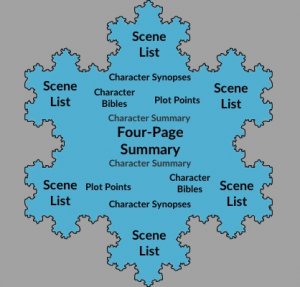
Remember how you expanded every sentence of your short synopsis into paragraphs to form your long synopsis? Here, you effectively do the same: taking every paragraph from the long synopsis and letting them breathe over a page each. Naturally, you might get the urge to write more descriptively, but resist that urge and keep every sentence just as tightly focused as before.
And then, last of all, you’ll want to draft out a scene list, where you detail exactly what will happen in every scene of your book.
Of course, there’s much more to the process than what’s been listed above. If you want to hear it straight from the horse’s mouth, you can always buy and read Ingermanson’s book on the Snowflake Method.
Things to remember
Watch out you don’t find yourself bogged down in analysis and not actually writing anything!
Going back and revising previous stages is not just okay: it's encouraged! This shows your characters are telling you more about your story. Major changes (your protagonist is no longer a lawyer encountering family troubles, but a high witch of a faraway fantastical land) might call for a start-over, but little additions and tweaks are all part of the joy of the process.
Seek intricacy, not perfection. Keep up the forward momentum and don’t worry about making every stage perfect before moving on. Every step of this method is intended to be a springboard and move you onto the next stage — not roadblocks designed to hinder you.
Many writers swear by the snowflake method — but ultimately, the only way to see if it will work for you is to try it. And even if you find yourself deviating from it at some point, at the very least it can help you get a running start by crystallizing those crucial first story elements.
Has the snowflake method worked for you before? Let us know how you find applying this to your own writing in the comments below!
5 responses
Andreas says:
13/06/2019 – 01:57
Could you give examples on the 5 sentences of part 2?
Amazing Blair Peery says:
16/06/2019 – 17:01
I second Andreas: Please show us the 5 bulleted sentences that would have been written for, say, "Gone With the Wind" or Star Wars". That would help us understand the concepts better. Thanks!
↪️ Martin Cavannagh replied:
17/06/2019 – 12:47
Martin from Reedsy here. I'm happy to take a bash using Star Wars as an example. 1. The exposition — Luke, a young farm boy on a desert planet dreams of excitement. 2. First plot point — Luke discovers a message from a princess in trouble and recruits a Jedi master and a smuggler to go save her. 3. Mid-point — Luke successfully rescues the princess but his mentor sacrifices himself so that the team can make their escape. 4. Plot point two — The villain closes in on the rebel base and as Luke prepares to defend it, Han decides to bail on him. 5. Climax and denouement — Luke discover his force powers, and Han has a change of heart — together they destroy the death star and save the day. Medals for everyone!
Rosanne says:
30/08/2019 – 15:34
I used this method to write my first novel and an abbreviated version for the 2nd and 3rd book of that trilogy.
Alicia O Williams says:
21/09/2019 – 05:47
Thank you for expanding more on this outline.
Comments are currently closed.
Continue reading
Recommended posts from the Reedsy Blog

How Many Sentences Are in a Paragraph?
From fiction to nonfiction works, the length of a paragraph varies depending on its purpose. Here's everything you need to know.

Narrative Structure: Definition, Examples, and Writing Tips
What's the difference between story structure and narrative structure? And how do you choose the right narrative structure for you novel?

What is the Proust Questionnaire? 22 Questions to Write Better Characters
Inspired by Marcel Proust, check out the questionnaire that will help your characters remember things past.

What is Pathos? Definition and Examples in Literature
Pathos is a literary device that uses language to evoke an emotional response, typically to connect readers with the characters in a story.

How to Start a Children’s Book: Coming Up with Your Big Idea
If you've ever dreamed of writing a children's book but aren't sure where to start, check out this post to learn more about how you can create the perfect story for kids.

How to Become a Travel Writer in 5 Steps: A Guide for Travel Bugs
If you want to get paid to share your adventures, learn how to become a travel writer with these five tips.
Join a community of over 1 million authors
Reedsy is more than just a blog. Become a member today to discover how we can help you publish a beautiful book.
Bring your stories to life
Our free writing app lets you set writing goals and track your progress, so you can finally write that book!

1 million authors trust the professionals on Reedsy. Come meet them.
Enter your email or get started with a social account:
When You Write
How to Outline a Short Story [Template Included]
When most people decide to write a short story, they usually assume that it’s going to be duck soup.
They just grab a pen and paper or their laptop and get straight to it.
No outline. No sketch. Nothing!
If you’re “most people,” you probably have a lot of unfinished short stories that you abandoned after getting completely stuck halfway.
Or you’re just an aspiring author who’s got no idea that an outline is like a treasure map that can lead you to that great short literary piece.
Why Should You Outline a Short Story?
Clichés, anyone? Alright, here we go!
“Failing to plan, is planning to?”
Outlining is both timesaving and enables you to have some sort of a road map—it gives you the freedom to unleash your artistic genius rather than focus on trivial crinkles of the story itself.
Although short story writing is narrower in terms of scope than a novel, it still includes many elements that wordsmiths input into a full-size novel.
It needs a multidimensional main character, a clear character arc, a comprehensive plot, and a gripping closing set of events. This somehow makes writing a short a bit laborious.
An outline can save a lot of the stress by helping you put together the jigsaw puzzle before the writing process really starts.
Outlining a short story
Key elements of a good short story outline.
As a writer’s roadmap, a short story outline is supposed to include details you can utilize to track character arcs, storylines, thematic content, and logical consistency.
Therefore, a good short story outline must address the following elements:
1. A Situation and Conflict: the state of affairs—the beginning of the story—that either changes for the better or takes a very bad turn (usually, it’s the latter). As the story progresses, it has to have a conflict. The conflict arises from the interaction between the protagonist (who has an objective) and the antagonist (who stands in the way of the protagonist and his objective).
2. The Solution to the Conflict: some creative writers like to start writing a story without knowing the ending themselves. Writing this way keeps the intrigue alive for the writer but having a predetermined solution to your story’s main conflict gives you a clear direction of the narrative.
3. Character Development: Characters are what bring the action in your story to life. When making notes for your story, make sure you define the protagonist and antagonist and give them more dimensions. Add backstories to the characters too, even though some of the backstories won’t make it to the final draft of the story—due to the limited scope of a short story.
4. Other Critical Points : The conflict and the solution that I have covered in (1) and (2) are some of the critical plot points that an outline has to cover. A story starts from an exposition; then the conflict arises; there’s rising action; then comes the climax; after that, is the falling action; and finally, the resolution concludes the tale.
The Short Story Outlining Process: Tips and Template
Now that we’ve seen some of the key elements of a short story, let’s take a look at the actual short story outlining process.
The process always starts with crafting your story’s premise and going all the way through to a full list of scenes.
One thing you ought to know about outlining methods is that there is no objectively correct or incorrect way of doing things. Most writers that I have encountered have personalized their outlining methods to a format that works for them.
If by chance this technique fails to do the job for you, you can adjust the process and find a method that works for you.
Having gotten that out of the way, let’s take a look at the outlining method that has worked for me and a couple of other writers in my writing circles, starting with tips on how you can approach the outlining process to churn out top-notch outlines.
1. Start Simplistic
To give your short story outline a good structure, you have to start from the bones.
You can utilize a technique called the Snowflake Method. Using this method of writing, a wordsmith begins with a simplistic deep theme and gradually adds meat to the story, making it more complex over time.
What you actually do is begin with an arrow-shaped idea and build on it afterwards. It’s exactly like what I said, start from the bones and add meat until the sentence becomes a matured story.
2.Create a Quasi Outline
This quasi outline is like a draft outline—a freestyled guideline for the final outline. When you write this draft, focus on the general ideas and major plotline events: the inciting action, the climax, the resolution.
You may leave holes whilst you write the quasi outline. You’ll patch them later; for now, focus on completing the panoramic view of the whole of your short fiction.
3. Use Unpredictability and Conflict to Spice Up the Plot
If a reader is able to predict—more than once—a set of events before they happen, they’re likely going to be discouraged from reading your story any further.
A good story uses unanticipated twists and conflict to sustain the much-needed tension.
This technique is effective in every genre, whether it’s romance (break someone’s heart unexpectedly) or horror (slash a baby’s throat, out of the blue).
4. Utilize the Protagonist’s Internal Monologue
One of the attributes of a good story is its ability to suck the reader into its world or settings.
One way of achieving this is the main character’s thoughts and mumblings to make the reader understand the protagonist’s mind and empathize with them.
Craft natural persona, needs, and character arc to absorb the reader slowly. Of course, this is harder to achieve with the limited scope of a short story but, that’s why the outline is indispensable.
5. Use Software to Outline Your Story
Regular word processing software—MS Word and co.—come with features that writers can utilize to outline a short story or larger types of prose.
However, there is sophisticated and dedicated software that has been designed to help you build a clean and comprehensible outline.
One such software that I would recommend is Plottr —an easy-to-use visual outlining and book planning tool. With this software, you can take your story from a simple synopsis to a book series.
Once you start “creating a book,” you can create a timeline, a list of characters and character arcs, plots and subplots, construct chapters, and put scenes inside the chapters (tuck characters and locations in the scene cards), et cetera.
Software like Plottr are time savers and make the entire outlining process smoother. Authors have been using these tools for short stories and larger texts like Novels (which—I think—is the type of prose that people mostly associate the tools with).
Story Outline Template
Once more, I would like to stress that you can write your outline whichever way you deem suitable.
But if you are not sure about it, I have made a condensed and downloadable template for you. Download it here or just study the thorough step-by-step outline method below.
Feel free to add extra elements to the ones that I have come up with.
Step 1. Create the Premise: A premise is basically the idea from which your story springs. Make sure that your premise is well defined and more than the basic idea; add condiments to the idea to make it provide a satisfying story guidance.
Your outline needs to be introduced by a condensed but creamy premise sentence that carries insights into the following things:
Step 2. Describe Setting: in this part, describe the environment within which your story takes place. Before writing a complete outline, you need to have a firm idea of where your story is taking place.
Is it happening in a mars-bound spaceship? Is the story about a kid in the projects? Perhaps the setting is an apartment complex in the Cayman Islands?
In a play or a movie, I think they call this a mises en scène. It covers things like:
ü Place/Location
ü Atmosphere/aura/mood
Step 3. Come up with the Main Character: Who is the protagonist? Come up with the persona that is going to be your main character. You can also—optionally—decide on the antagonist. Since the antagonist is antipathetic to the MCs’ objectives, they’re easy to come up with if you’ve already created the MC—a writer just needs to feed off the polarity between the personas to create the adversary.
Cover all these questions (maybe more), then condense them into one or two sentences that unwraps the core of the whole story.
Step 4. Objective, conflict, and resolution: this part is where the story is given the meat—it’s where you develop the story. There are a couple of questions that your outline needs to answer in this sections, questions like:
i. What’s the protagonist’s goal or objective?
ii. What conflict arises as a result of the MCs’ quest to attain the goal?
iii. What scenarios and effects are going to get thrown in to tense up the conflict?
iv. What and how will the story’s climax be? Will the protagonist be successful? Will he fail to attain his goal?
v. How will the conflict end? What will the resolution be?
Step 5. Character Development: lastly, give each important character in your story a life. The next step involves bringing some of the characters to life—i.e., developing the protagonist’s persona, needs, and character arc.
There are crucial details that need to be added to your characters, whether or not they appear in the story.
To do this, you need to ask yourself some questions or immerse yourself in the story and interview the characters.
What led to the character’s current situation? What events happened in their past, and how can it affect the way they resolve the conflict? What other unsolved issues could affect the protagonist’s objective and conflict resolution?
You have to dig deep, where and how is a matter of personal preference.
You may choose to use a pre-set list of questions shared by numerous published authors, or you may tweak some details and ask your protagonist a series of questions to find out the heart and soul of your character.
Step 6. Sketch the Plotline and fill it with Scenes: With the premise polished up, you can now set about to develop your ideas for this story.
Before outlining, you usually have sketchy ideas about the story. Write down all those sketchy ideas you have about your story.
What you want to do is record all the details so that you don’t forget anything. Add even the scenes that you are not sure about. Most of the time, things just fall in place—organically—once the story starts going.
This is the part of your creative process that involves a ‘no holds barred’ mentality. During this writing stage, you must focus on emptying your ideas and letting your thoughts out without sweating about any of the tenets of the Queen’s language— punctuation, grammar, or spelling. You need to keep plucking your most creative ideas and thoughts and adding depth to your story’s potential.
One thing that sets a good storyline apart from the basic ones is unpredictability. If you think a scene feels too familiar or predictable for readers, reconstruct it or throw it away altogether.
How to Start a Short Story?
Of course, I’m not going to ramble about the whole process of writing a short story, but the least I can do is to give you some insights on how to start a captivating short story.
You might be saying to yourself, “Yeah, I know how to outline a short story, right? But how do I start writing a scintillating story?”
The secret formula involves getting the reader’s attention quicker they expect and getting them settling into the story as it unfolds in its infancy.
To drive the point home, I’m going to borrow some of Anthony Ehler’s tips on how to start a short story:
Start as close to the action as possible . On this method, Ehler uses F. Scott Fitzgerald’s short story, Three Hours Between Planes, to demonstrate how the author scrapped the man’s arrival into his old town and immediately placed the man in a phone, looking up his old sweetheart’s number.
Set the tone of the story . For example, Ehler uses Ian Rankin’s spine-chilling crime story, Someone Got to Eddie , to demonstrate how a good short story starts—Rankin used a fictional character’s sequence of thoughts to instantly and crisply speak to the reader. With a well-constructed interior monologue, a good start immediately absorbs the reader into the main character’s mind.
Focus on your main character . Lastly, he uses Gina Berriault’s story, The Stone Boy , to back his point: a good story should immediately move the reader to identify with the main character. This makes the reader crave more and anticipate the story’s next event and twist—the reader plunks for the main character and is keen to see what will happen to the mc.
In Conclusion…
So, you’ve written your story, and you’re all set to start writing a future classic; always remember the golden rule of writing fiction—show, don’t tell.
The best part about outlining is that you won’t have to submit it to anyone. It’s for your own convenience.
That’s the easy part.
The hard part’s writing the story. When you start writing the story, you’ve got to put yourself in the reader’s mind and see if it sounds exciting or if it’s natural and convincing.
“If you think it’s boring, it probably is.”
Recommended Reading...
What is a premise in writing why should you write it first, how to write a good climax (narrative) – professional tips, how does the setting contribute to the story, what is a love square.
Keep in mind that we may receive commissions when you click our links and make purchases. However, this does not impact our reviews and comparisons. We try our best to keep things fair and balanced, in order to help you make the best choice for you.
As an Amazon Associate, I earn from qualifying purchases.
© 2024 When You Write
- PRO Courses Guides New Tech Help Pro Expert Videos About wikiHow Pro Upgrade Sign In
- EDIT Edit this Article
- EXPLORE Tech Help Pro About Us Random Article Quizzes Request a New Article Community Dashboard This Or That Game Popular Categories Arts and Entertainment Artwork Books Movies Computers and Electronics Computers Phone Skills Technology Hacks Health Men's Health Mental Health Women's Health Relationships Dating Love Relationship Issues Hobbies and Crafts Crafts Drawing Games Education & Communication Communication Skills Personal Development Studying Personal Care and Style Fashion Hair Care Personal Hygiene Youth Personal Care School Stuff Dating All Categories Arts and Entertainment Finance and Business Home and Garden Relationship Quizzes Cars & Other Vehicles Food and Entertaining Personal Care and Style Sports and Fitness Computers and Electronics Health Pets and Animals Travel Education & Communication Hobbies and Crafts Philosophy and Religion Work World Family Life Holidays and Traditions Relationships Youth
- Browse Articles
- Learn Something New
- Quizzes Hot
- This Or That Game New
- Train Your Brain
- Explore More
- Support wikiHow
- About wikiHow
- Log in / Sign up
- Education and Communications
- Fiction Writing
- Writing Novels

How to Write an Outline for a Story
Last Updated: October 11, 2022 Fact Checked
This article was co-authored by Lucy V. Hay . Lucy V. Hay is a Professional Writer based in London, England. With over 20 years of industry experience, Lucy is an author, script editor, and award-winning blogger who helps other writers through writing workshops, courses, and her blog Bang2Write. Lucy is the producer of two British thrillers, and Bang2Write has appeared in the Top 100 round-ups for Writer’s Digest & The Write Life and is a UK Blog Awards Finalist and Feedspot’s #1 Screenwriting blog in the UK. She received a B.A. in Scriptwriting for Film & Television from Bournemouth University. There are 10 references cited in this article, which can be found at the bottom of the page. This article has been fact-checked, ensuring the accuracy of any cited facts and confirming the authority of its sources. This article has been viewed 288,402 times.
Though some writers actively avoid plot outlines, preferring instead to let their ideas flow as they write, creating a plot outline before you dive in can help you get a better sense of your story. It can act as a roadmap for you as you write about your setting, your characters, and describe the major events in the story. A plot outline can also be useful if you hit a wall while writing your story and want to get a better sense of where to write to next.
Using a Plot Diagram

- This type of plot diagram is often used in novels to help structure the action of the story. It can be a useful way to make sure you have all the necessary elements of a story in your novel and many readers will respond positively to a text that is structured based on a plot diagram that has a rise and fall.
- You can draw your own plot diagram and write out each section or plot point directly on it. Sometimes it can be helpful to have a visual reference as a guide for your story.

- Your set up should include the setting of the story, information about your protagonist, and introduce the protagonist's conflict. It may be a few lines that address these elements or an actual scene where your protagonist is speaking to other characters and moving around in the setting.
- For example, the set up for the first book in the wildly popular Harry Potter series by J.K. Rowling, Harry Potter and the Philosopher's Stone , focuses on introducing the reader to the protagonist of the series, Harry Potter. It also introduces the reader to the world of the Muggles and the world of wizards at Hogwarts School of Witchcraft and Wizardry.

- For example, in Harry Potter and the Philosopher's Stone , the inciting incident is when Harry is visited by Hagrid the Giant and told that he is a wizard and has been accepted into Hogwarts. This information changes Harry's life and his trajectory as a character. He leaves his unhappy situation with the Dursleys in the Muggle world and journeys to Hogwarts with Hagrid. This incident then sets off a chain of events in Harry's life.

- Because the rising action section is often made of a series of events, you can outline each event in your plot diagram. Make sure the events become more suspenseful and continue to up the stakes the closer you get to the climax.
- Harry goes shopping with Hagrid for his wizardry supplies on Diagon Alley, including his magic wand.
- Harry leaves the Dursley home and takes the train to Hogwarts on the 9 ¾ platform. He then meets three main characters in the series: Ron Weasley, Hermione Granger, and Harry's nemesis, Draco Malfoy.
- Harry is given the Invisibility Cloak.
- Harry finds out about the Philosopher's stone and shares this information with Ron and Hermione.

- For example, in Harry Potter and the Philosopher's Stone , the climax of the story appears when Harry realizes there is a plot afoot to steal the Philosopher's stone. He then teams up with Ron and Hermione to try to protect it.

- Your falling action may occur over several chapters, especially if the protagonist is dealing with a big climax. The falling action can feel like a journey, albeit a fast paced one, that gets the characters to the resolution of the story.
- For example, in Harry Potter and the Philosopher's Stone , Harry has to make a series of life or death decision to save the Philosopher's Stone from falling into the wrong hands. This quest is spread out over several chapters and is paced so that Harry has to defeat several obstacles to achieve his goal.

- For example, in Harry Potter and the Philosopher's Stone , the resolution occurs when Harry confronts Professor Quirrell in the final room that contains the Philosopher's Stone. Quirrell is soon revealed to be possessed by Lord Voldemort and Harry struggles with Voldemort for the Stone. Harry passes out during the struggle and wakes up in the school hospital, surrounded by his friends. Dumbledore tells Harry he survived because of the power of the love of his mother. The Stone is then destroyed, Voldemort goes back underground, and Harry returns to the Dursley's for summer break.

Using the Snowflake Method

- Keep the summary short and sweet, using non-specific descriptions and terms with no names. Try to use 15 words or less and focus on tying a larger theme with character actions.
- For example, your one line summary might read: “A seemingly perfect marriage is disrupted when the wife disappears.”

- Your paragraph will be made up of five sentences. One sentence should describe the story set up. There should be one sentence for each of the three disasters. Then, one final sentence that describes the ending.
- Your paragraph may read: “Nick and Amy have a seemingly perfect marriage and appear happy to those who know them. But one night Amy disappears under mysterious circumstances and foul play is suspected. Nick is soon accused of her murder and must defend himself in court. Nick discovers that Amy faked her own murder and is still alive, but determined to put him in prison. Nick confronts Amy and they argue, but ultimately, Amy blackmails Nick into staying in the marriage.”

- Your character synopses do not need to be perfect or polished. You will likely go back and tweak them later or deviate from them when you start writing scenes of the novel. But at least the synopses will help you get a better sense of your characters and where they fit within your story.
- An example character synopsis might be: “Nick is a thirty five year old reporter who is laid off from his job after ten years in the business. He has been married to Amy for ten years and views her as his golden bride, his ideal wife and partner. He struggles with his lack of employment, especially because Amy comes from a wealthy family and has recently inherited a large sum of money. He believes he needs to be the provider in the marriage and is threatened by Amy's financial independence and success in her career. When Amy disappears, he is conflicted by his need to find her and his unhappiness in his marriage to her. He eventually realizes that Amy has set him up and is trying to frame him for her disappearance.”

- Use a spreadsheet program to organize the scenes, as this will make it easy to write out each scene in order. Depending on how long your story is, you may have 50 scenes or over 100 scenes. Create two columns in the spreadsheet, one for the POV character in the scene and another column to explain briefly what happens in the scene. Then, list the scenes one by one, using your summary as a guide.
- For example, one entry might read: “Nick discovers Amy is missing. POV character: Nick. What happens: Nick comes home for a long night working at the bar and finds the front door has been kicked open. He also finds a pool of blood in the hallway and signs of a struggle in the living room, with turned over chairs and scratches on the walls. He searches the rest of the house but finds no sign of Amy.”
- Continue to do this, creating scenes that correspond to your plot summary. You should then have an outline of your plot and a list of scenes that correspond to your plot. This should make it easier to then put the scenes together and form a cohesive story.
Creating a Plot Outline for an Assigned Text

- Use a word processing document or a piece of paper to create three distinct sections, titled Act 1, Act 2, Act 3.
- Plot outlines are usually one to two pages long, depending on the length of the book. Aim to be concise and focus on the key points of the plot.

- The beginning of your plot outline for Act 1 should also include the inciting incident, which sets your character on a quest or mission. The inciting incident may also lead to the main conflict in the novel.
- For example, in Harper Lee's To Kill a Mockingbird , the inciting incident of the book occurs when Atticus agrees to defend a black man named Tom Robinson, who is accused of raping a white woman.

- For example, in Harper Lee's To Kill a Mockingbird , the main conflict occurs as a result of the inciting incident, as Atticus' decision to defend Tom Robinson leads to the abuse of Jem and Scout by the other children and members of the community.

- For example, in Harper Lee's To Kill a Mockingbird , the rising action occurs as the trial for Tom Robinson begins and then plays out over a series of chapters. Though Tom Robinson is acquitted of the charges, the white woman's father, Bob Ewell, still seeks revenge against Atticus. The climax of the novel occurs when Ewell attacks Jem and Scout. Luckily, Jem and Scout are saved by Boo Radley.

- For example, in Harper Lee's To Kill a Mockingbird , the protagonist, Scout, realizes that she misunderstood Boo Radley and comes to sympathize with Boo as a person. She also embraces her father, Atticus', advice to demonstrate sympathy and understanding for others, rather than hatred or prejudice.
Sample Outlines

Expert Q&A

You Might Also Like

- ↑ Lucy V. Hay. Professional Writer. Expert Interview. 16 July 2019.
- ↑ https://www.readwritethink.org/classroom-resources/student-interactives/plot-diagram
- ↑ https://k12.thoughtfullearning.com/minilesson/starting-stories-5-great-beginning-strategies
- ↑ https://www.authorlearningcenter.com/writing/fiction/w/plot-planning/7309/5-elements-of-plot-and-how-to-use-them-to-build-your-novel
- ↑ https://milnepublishing.geneseo.edu/exploring-movie-construction-and-production/chapter/3-what-are-the-mechanics-of-story-and-plot/
- ↑ http://www.advancedfictionwriting.com/articles/snowflake-method/
- ↑ https://www.masterclass.com/articles/how-to-write-three-act-structure
- ↑ https://www.hunter.cuny.edu/rwc/handouts/the-writing-process-1/invention/Guidelines-for-Writing-a-Summary
- ↑ https://writersedit.com/fiction-writing/literary-devices/plan-novel-using-three-act-structure/
- ↑ https://blog.reedsy.com/guide/story-structure/three-act-structure/
About This Article

To write a plot outline or plot diagram, draw a short horizontal line on a piece of paper to represent the exposition, which introduces the characters. Then, angle the line up sharply so that angle can represent the inciting incident that changes the main character's life. The rest of that line is the rising action, where you develop your story. While the end of the line is the climax, or the most important problem. Angle the line down from there to show the protagonist fixing the problem, ending in the resolution. Keep reading for tips from our Writing reviewer on how to use the snowflake outline method! Did this summary help you? Yes No
- Send fan mail to authors
Reader Success Stories
Chanelle Kelly
Dec 6, 2016
Did this article help you?
Tazia Silvio
May 13, 2017
Feb 5, 2017
Daluchi Uche
Feb 23, 2017
Oct 29, 2017

Featured Articles

Trending Articles

Watch Articles

- Terms of Use
- Privacy Policy
- Do Not Sell or Share My Info
- Not Selling Info
Get all the best how-tos!
Sign up for wikiHow's weekly email newsletter
How to outline a novel (template plus 7 checks)
Deciding how to outline a novel (or whether to outline at all) is a personal process for each author. This sample book outline plus 7 checks and insights will help you outline with purpose:
- Post author By Jordan
- No Comments on How to outline a novel (template plus 7 checks)
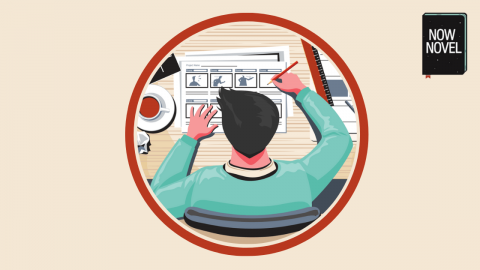
Novel outlining: Pros, Cons, and Pitfalls
Outlining novels: Pros and cons Should I outline a novel? ‘Pantsing’ pitfalls
Sample Novel Outline
Sample book outline, how to outline a novel while avoiding cons:.
1. Have a broad yet specific story idea 2. Have core ideas of characters to expand 3. Know crucial details of plot 4. Research or understand your novel’s setting 5. Have an idea of who will narrate 6. Keep asking interesting questions 7. Alternate planning with drafting
Outlining novels: Pros and cons
Before we examine a sample book outline and discuss it in detail, let’s examine what authors and editors say about the value of outlining. Some authors (Stephen King among them) profess to be ‘pantsers’ (referring to writing ‘by the seat of your pants’). In his writing manual On Writing , King compares writing to excavating around a fossil (the hard kernel of an idea) to discover more of its story.
I won’t try to convince you that I’ve never plotted any more than I’d try to convince you that I’ve never told a lie, but I do both as infrequently as possible. I distrust plot for two reasons: first, because our lives are largely plotless, even when you add in all our reasonable precautions and careful planning; and second, because I believe plotting and the spontaneity of real creation aren’t compatible. Stephen King, On Writing (2000), p. 163.
The idea that a story outline could be restrictive is plausible (though it’s unclear why – to King – planning is not an act of ‘real creation’).
Editor and publishing strategist Jane Friedman gives a less absolute view on whether or not to outline a novel before drafting:
My advice about planning your novel is this: do whatever will give you the confidence you need to get started. If diving right in works for you, that’s awesome. If you need an elaborate outline, write an elaborate outline. Jane Friedman, ‘To Outline or Not to Outline your Novel’.
Key points ‘for’ and ‘against’ outlining books:
Should I outline a novel?
Pros of outlining:
- Helps you get started
- Fosters confidence in your writing process and progress
- Guides expansive elaboration
Cons of creating an outline:
- May decrease spontaneity
- Involves plotting which isn’t how ‘real’ life unfolds (sometimes without linear direction or obvious meaning), according to Stephen King
- Potentially limits a process of discovery ( according to NY Book Editors )
It is wonderful when we have a rush of spontaneous ideas and write as though in a fever dream.
Creating this way doesn’t work for everyone, though, the same way a fixed approach to outlining doesn’t work for everyone. This is why we made our story outlining tools more flexible, to suit the many different starting points of writing a novel .
‘Pantsing’ pitfalls
Spontaneous creativity, what King calls ‘real creation’, may lead to its own issues, such as:
- Lack of cohesion (fragments created in flashes of inspiration failing to weave together in a coherent story)
- Writer’s block: What happens when the muse doesn’t come when bidden, spontaneity evaporates or ideas for what comes next dry up?
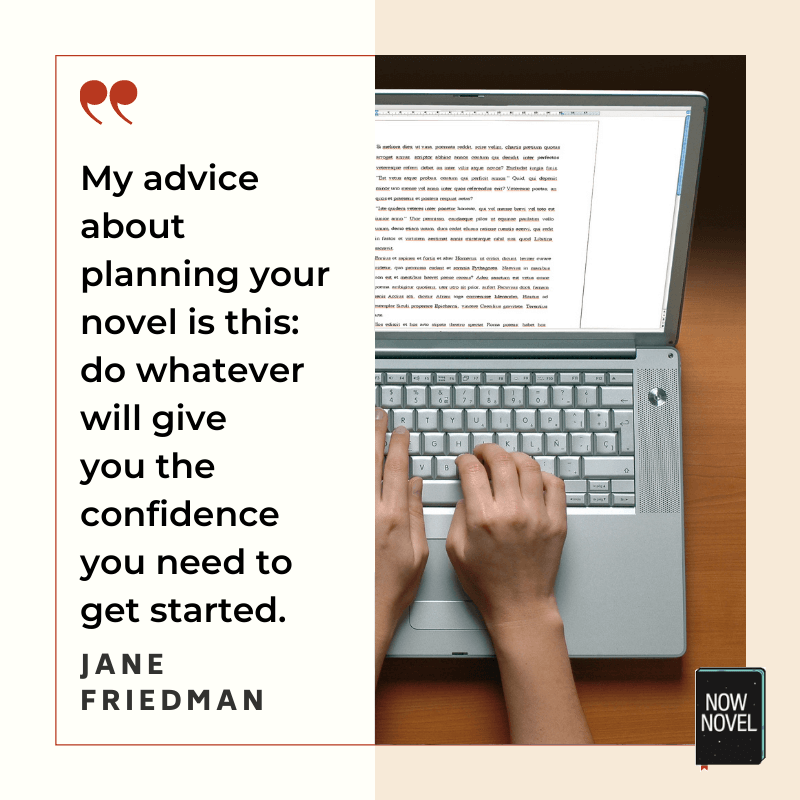
To Contents
How to outline a novel (and avoid King’s cons)
See this novel outline template, then read 7 checks for how to outline without losing spontaneity or creativity:
In deciding how to outline a novel, there are many categories of information you could include, in varying degrees of detail. To begin, your central idea or story premise, which you can see in the sample book outline page below, along with simple ideas for character details:
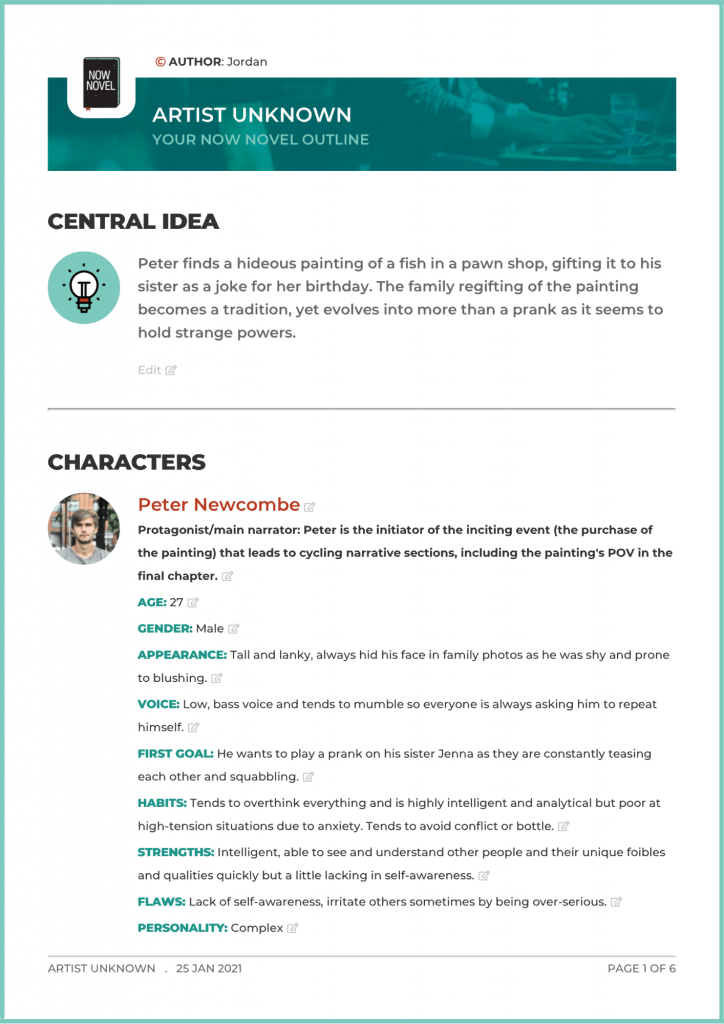
Here’s how to outline a novel with confidence. To become a better book writer , check that you:
1. Have a broad yet specific story idea
Find a story premise or idea you’re excited to explore further. It could be:
- An idea combining three topics you find interesting (for the above sample book outline, the topics were ‘art’, ‘tradition’ and ‘family relationships’)
- An anecdote someone once told you about an interesting event or act that you transform into your own fiction
- A ‘high concept’ (for example, ‘what if a new planet were discovered where there were abundant resources and there was a global race to claim/colonize it?’)
Look again at the sample story idea in the novel outline above:
Peter finds a hideous painting of a fish in a pawn shop, gifting it to his sister as a joke for her birthday. The family regifting of the painting becomes a tradition, yet evolves into more than a prank as it seems to hold strange powers.
- Specific: Particular people, events, actions and/or settings are implied
- Broad or expansive: It leaves room to explore and imagine the different family members, the way the gift of the painting transforms and changes (what role the painting plays, what the ‘strange powers’ hinted at are)
- Full of implied change: Change is the lifeblood of stories . The impact of a small act changes (the painting becoming more central to the family’s lives and traditions). The original intent of Peter’s gesture (a prank) could spin out in all kinds of directions
Find your central idea
Brainstorm a central idea, build character profiles and more using easy writing tools.

2. Have core ideas of characters to expand
By Stephen King’s definition, ‘plotting’ (making choices about what will happen in a story before writing the scene itself) stifles spontaneity. When you brainstorm characters, however, there is spontaneity in this process itself . You pull phrases out of thin air, as you do when writing a scene. Writing novel ideas for characters gets creativity flowing.
In learning how to outline a novel , it’s important to remember that all these decisions are also provisional, open to change.
You can add in character ideas or take them out. Casually add in new scene outlines and chapter summaries, too (remember to update your outline afterwards, to keep the ‘bird’s eye view’ of your growing story up-to-date).
The character overview summary of Peter Newcombe (the protagonist for the sample book outline above) and his sister, Jenna:
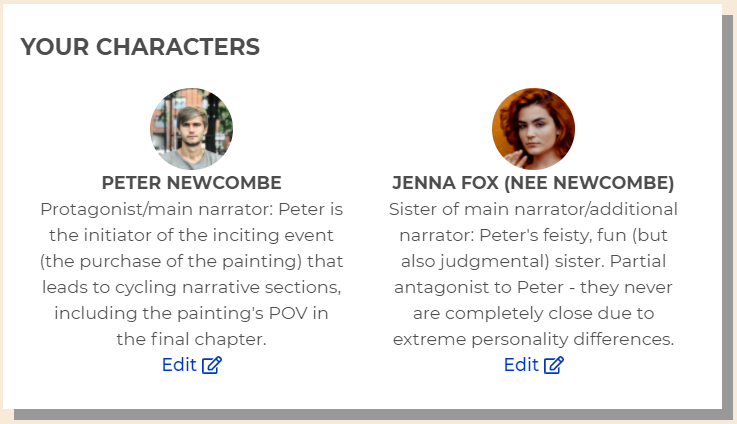
Because our central idea was broad yet specific (mentioning a male protagonist and his sister), these are two characters we have plenty of room to expand upon. This makes it easier to have spontaneous fun creating, finding conflicts, happier scenes and other moments within the parameters we’ve set.
3. Know crucial details of plot
Stephen King and many others may balk at plotting a novel outline in advance. An outline is not every bend in the road, every footprint captured in poured, set concrete. The drafting process is often like the ducks that walk over said concrete. Chaotic. Surprising. Often, infuriating.
Learning how to outline a novel so that this process is less chaotic does not necessarily stop the good kind of surprise. Within broad yet specific parameters, there are still many ways things could go. Ways the story could begin (or end). Find key details of plot (plot points) that are already decided to expand upon.
For the sample book outline above, we know:
- A brother plays a prank on his sister
- Their family incorporates said prank (the gifting of an ugly painting for a birthday) into their traditions
Within these two ideas or plot points, there are many questions to ask; scenes to imagine. You might make a list of possible scene ideas like this:
- Peter finds a painting in local pawn shop ‘Tat for Tits’
- He haggles with the shopkeeper who tries to pretend the painting is by Renoir (it definitely isn’t)
- He tries to disguise the painting when he wraps it so his sister will have no idea what it is
4. Research or understand your novel’s setting
In discussions about how to outline a novel, there’s often an extreme focus on plot. The truth is every element of a story – plot, character, place, structure – is something you may explore a little before you’ve written the first line of your story. They’re all intertwined, too. Knowing your story’s setting, its ‘where’ and ‘when’ , is helpful. If Peter and Jenna in our sample book outline are living in 1940s Boston, Massachussets, for example, this will yield a very different field of plot (or story) constraints and possibilities than if they’re living in 1980s Durban, South Africa.
If you were setting your story in 1940s Boston, for example, there would be local events to add to your outline.
For example, you might note that the Cocoanut Grove Fire (the deadliest nightclub fire, claiming 492 lives) happened in 1942.
Understanding key historical moments (whether your story is set in our ‘real’ world or an invented one) will help you think further about the external forces that shape people’s experiences and perceptions.
5. Have an idea of who will narrate
When you outline a novel, think about who is going to tell the story.
As you can see in the character overview summaries from the Now Novel dashboard above, there are notes on the story having at least three planned narrators:
- The story’s protagonist, Peter
- His spicier sister, Jenna
- An unusual narrator – the painting that is the object underlying the inciting incident, which, in this outline example will share it’s own strange perspective as a sort of closing or epilogue to the story
Write down who you’d like to make the main narrator of your story.
List reasons why they’d make a good narrator. For the painting, for example, you could say:
- It’s an unexpected narrator, which will add an element of surprise/mystery
- Hanging in the different family members’ homes will give it private insights the main narrators don’t necessarily have about each others’ lives and secrets
6. Keep asking interesting questions
As you continue to outline your novel, keep asking interesting questions. Note your ideas.
For example, in the process of writing this, the haggling pawn shop owner who argues his rubbish paintings are actually Renoir originals came to mind. Why?
Because the question came up: ‘What happens in the scene where Peter finds the painting?’ Or, ‘How does Peter find and acquire the painting?’
Once you’ve learned how to outline a novel, it’s easier to know what questions to ask to find fun new characters and situations quickly.
This is easier than grasping at patchy ideas when you’re in the middle of a ‘spontaneous’ scene.
7. Alternate planning with drafting
Returning to Stephen King and NY Editors’ objections to outlining, how do you avoid stifling spontaneity and avoid what NY Editors call a book ‘dead on arrival’?
The answer is simple: Adapt outlining to your needs and the degree of detail and structure you need to get going.
A central idea and a character profile or two may be enough. Or you may want to draft a scene or two, then dive back into profiling a new character so that you can picture them clearly during their first introduction.
Learn how to outline a novel in easy, prompted steps and discover why Now Novel is frequently reviewed as a five-star novel planning website .

Related Posts:
- Using a novel outline template: 5 tips for story prep
- How do you write an outline for a novel? 7 easy steps
- How to write a plot outline: 7 plotting techniques
- Tags outlining a novel
Jordan is a writer, editor, community manager and product developer. He received his BA Honours in English Literature and his undergraduate in English Literature and Music from the University of Cape Town.
Leave a Reply Cancel reply
Your email address will not be published. Required fields are marked *
Pin It on Pinterest

A plot outline is like your story’s skeleton. It’s the bones on which you hang the flesh, blood, sweat and tears of your story.
It sketches out the underlying structure of your novel: its key stages, including critical developments and pivotal moments.
It doesn’t list all of the chapters, or everything that happens in them. Its sticks to the heart of the story – which is usually the personal journey of the protagonist, from who they are at the beginning to who they are at the end.
For some people an outline may simply be a few ideas floating around their head , for others it may be a 50,000 word document.
For our purposes, we’ll assume a plot outline is a written document of a few pages, covering key stages and turning points.
The most basic plot structures
The simplest plot outline could be based on the three act structure :

For example:
- Beginning – Harry is a bullied orphan living with his aunt and uncle, who mistreat him
- Middle – He joins a magical school and learns of great friends, enemies and challenges
- End – He manages to stop an evil wizard from stealing an important artefact, and returns home confident and able to stand up for himself
But that’s simplistic to the point of being of limited use. So you may want to expand it into something like this:
- Rising Action
- Falling action
- Final Outcome
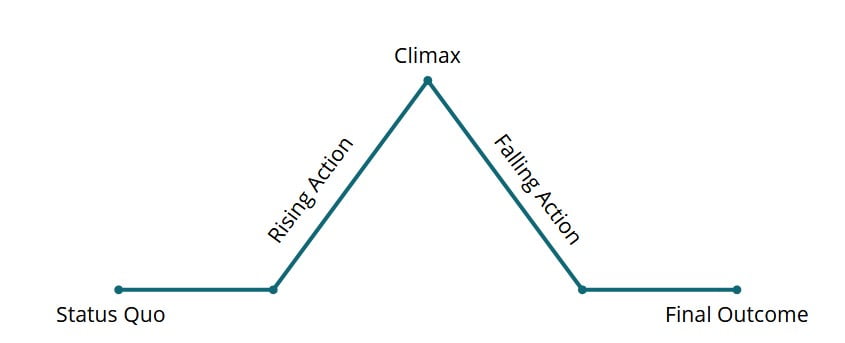
For many people, this is enough of a structure on which to hang the main points of their story. Using these stages will help ensure the story feels satisfying to a reader.
Imagine how a reader might feel if you wrote a story with the stages in this order:
- Final outcome
- Falling Action
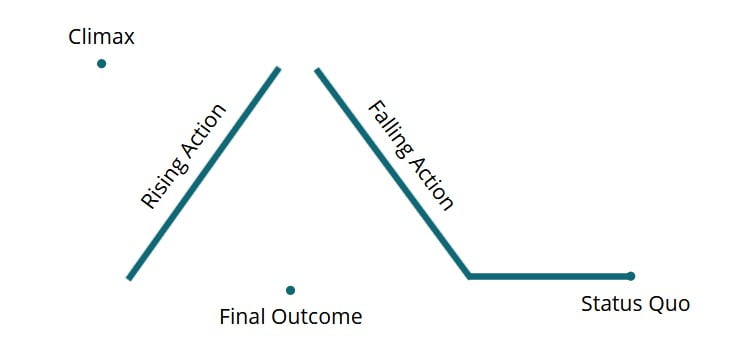
It hurts just to look at it. Imagine what it would be like to read.
Applying this distortion to the simplest of plot outline makes it clear why getting the stages out of order can be confusing, unsettling and even nonsensical.
This is an important lesson, because while the diagram above is almost laughable, it might not be so obvious when stages are out of order when using a more advanced structure. However, there’s a high chance that readers will still feel less engaged and emotionally involved.
The most popular and widely used plot structure is probably the Hero’s Journey, which goes something like this:
- Ordinary World
- Call to adventure
Refusal of the Call
- Meeting the Mentor
Crossing the Threshold
- Tests, allies, enemies
- Approach the innermost cave
- Resurrection
- Return with Elixir
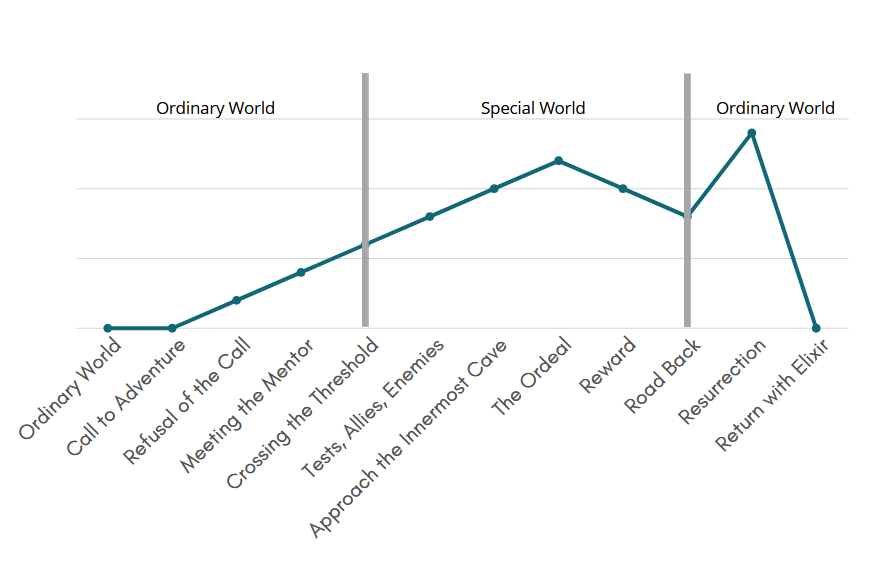
In this diagram, the higher the line, the higher the tension and stakes. The dip towards the end additionally represents a loss of hope.
Traditional diagrams depict the Hero’s Journey as a circle, but I find that doesn’t sit right with me, as it means the end point appears to be exactly the same as the start point.
For me the linear diagram better represents the concept the the hero returns ‘home’ (back to the baseline), but they are further forward than they were at the start.
Here’s a very brief explanation for each of these stages:
You can read about the stages of the Hero’s Journey in more detail here .
Before we go any further, let’s address some questions that writers sometimes raise with regards to the Hero’s Journey and other plot outlines.

It’s important to realise that each of these stages can be interpreted in an infinite number of ways, leading to an infinite variety of stories.
At first, it’s easy to be misled (especially by the wording) that this template will force your story into a particular style.
For example, at the most fundamental level, the word ‘Hero’ may give the impression you have to present a sword wielding, brawny young man who longs for adventure - but this couldn’t be further from the truth.

The ‘Hero’ just means the protagonist, and they don’t have to display any traditionally ‘heroic’ qualities at all. We are all the protagonist of our own experience, however flawed and morally questionable.
Similarly, the Call to Adventure doesn’t have to have anything to do with sirens, evil Kings or swordfights. It can be anything that unsettles and ordinary life.
So, while the hero could be a young man longing for exciting quests, and his call to adventure could be an old wizard telling him of a dragon who’s kidnapped a princess, it could equally be:
- A high school airhead who’s just been dumped and decides to go to law school to try to win her boyfriend back.
- A little girl who follows a rabbit down and hole, then has to find her way home.
- Or even a widowed fish who needs to find his missing son.
Click here for more examples of the Hero’s Journey in a range of stories.
If you start looking out for it as you watch movies and read books, you will start to see how varied the interpretations are, and how the same concepts that be found in all genres and mediums.
In fact, because of your own personal experience of life and the world, you couldn’t write a book that was the same as someone else by following these stages, even if you tried.
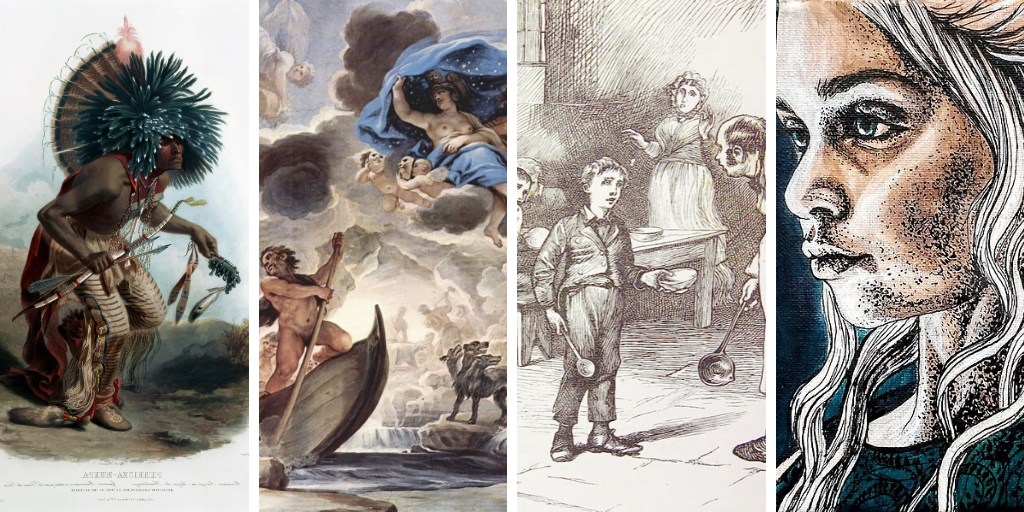
One of the most important things to remember when following the Hero’s Journey and its variations, is that nobody invented them.
An academic called Joseph Campbell is credited with analysing thousands of stories spanning the globe, from those told around tribal campfires to modern books and movies.
In doing so, Campbell identified similarities that emerged beyond all the borders and ages, and attempted to distil these common patterns into one fundamental ‘monomyth’. The Hero’s Journey is a modernised interpretation of that monomyth.
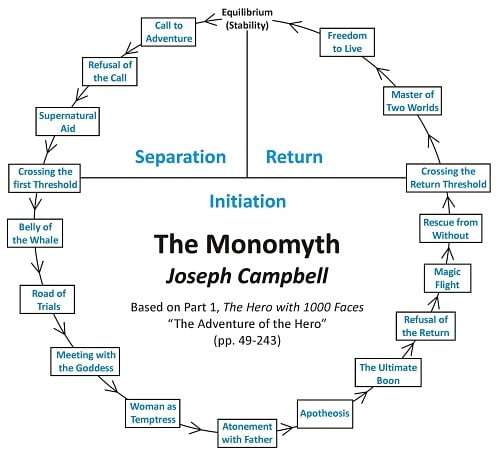
So, they are not a set of rules made up and laid out by some authority. They are a fundamental structure that emerged from the collective consciousness of our human psyche.
The success of the vast majority of bestsellers and box office huts is testament to the power of the Hero’s Journey to resonate with large numbers of people.
Cautions of the monomyth

Having said that… all interpretations we make of the world are shaped by our own experience, and the original monomyth laid out by Campbell certainly contains problematic terminology and elements.
Glaringly, there are those which focus on the traditionally male perspective and experience, but there are also issues with bias towards the western experience and attitudes of the time regarding dominance and individuality.
Campbell can’t be blamed for that, none of us can see the limitations of our own perspective because they are beyond our peripheral vision. However, it also means that we don’t need to treat his analysis as ‘sacred’.
And of course, the Hero’s Journey is already an interpretation of the original work, so it has already begun.
Despite these qualifications, disregarding the monomyth and Hero’s Journey would be throwing away some of a writer’s most useful tools.
And we can continue that work by evolving it to fit our changing experiences and attitudes to the world and our way of existing in it.
Of course, you could choose to throw it all out and start from scratch, creating your own stages, pacing and progression. But there is a much stronger chance you won’t tap into the collective unconscious; in which case you’ll need to work much harder to engage the audience.

Many have already begun this work, and created interpretations and variations which make it clearer that the emphasis is on a personal journey, rather than anything to do with men slaying dragons.
An excellent one is the Character Driven Hero’s Journey, as developed by Allen Palmer:
Genre specific novel outline templates
And of course, people who write in specific genres are able to identify stages and elements which tend to crop up consistently within their own genres, and have a positive effect on the popularity of their stories.
We’ve created a bunch of genre specific plot outline templates, including:
- Detective Noir
- Character Driven Hero’s Journey
- Mystery / Crime Thriller
- Short Story
You can access all of these below.
Stronger first draft
If you outline your plot before you start writing, you can be confident your first draft will have a solid structure from the outset, rather than hoping for it to emerge organically, or having to retroactively go and apply it
This will save time and effort when it comes to redrafting and editing towards your final manuscript.
Direction and Completion
Knowing where you’re going helps you get there.
Writing a novel is a mammoth task which can feel overwhelming. Having a plot outline helps break it down into manageable chunks, with clear goals.
It can keep you motivated and on track.
Frees up creativity
Contrary to stifling creativity, having a plot outline frees you up to let the words flow, because you don’t have to be preoccupied with the worry that you’re going to write 50,000 words then find yourself in a dead end.
Could take away the thrill of discovery
Many writers don’t want to know too much about their story before they start, as the knowing sucks out the excitement of discovering the story as they write.
And some successful writers report that they never plan before they start.
But when you analyse their work, you will usually discover that the stages are in fact. So what gives?
It’s not that they’re being dishonest, it’s that they have absorbed these patterns from their experiences of books, movies and life and are applying them sub-consciously.
If you don’t feel writing out a plot outline works for you, then it’s even more important to internalise the universal structures, so you can rely on your subconscious to take care of it.
Procrastination
Writers can sometimes be procrastinators to professional levels, so make sure you’re not doing your plot outline to death just to avoid starting your first draft.
But the fact is that there are certain things that tap into our human psyche. Skilled writers will subvert and break traditional structural conventions to great effect – but it’s unlikely they’ll do so by accident.
You have to know the rules before you can consistently break them effectively, so know about plot outlines and what they do is a great tool to have in your writer’s toolbox, whether you decide to use them in the end or not.
Find a plot outline that suits you
Read through a range of plot outline templates and see which resonates with you the most.
Write a few sentences for each of the stages
For each of the stages write a few sentences, or a paragraph which describe how that stage manifests in your novel.
Read through the entire thing and make sure it flows and makes sense. Make adjustments for consistency.
Ongoing improvement
As you’re writing your first draft and subsequent drafts, treat your plot outline like a working document, not a set of commandments carved into stone.
If it needs tweaking and updating, that’s fine. You may decide to reorder the stages, add new ones, or remove some.
Don’t be too rigid
As with all rules of thumb, you can break the conventions to great effect – the important thing is that you know what you’re doing and why, rather than just fumbling because you don’t have the right tools in the first place.
Following the stages fairly closely is the easiest way to take advantage of the patterns of the collective unconscious. Deviating from them is to be encouraged, but you have to be aware of the impact it will have, and realise you may have to work harder and use other techniques to engage the audience and keep them emotionally hooked.
Good luck with your plot outlines! Please share your plot outlines and other plot outline resources in the comments!
8 Plot Outline Templates - Free Downloadable PDFs
The plot structures below are available as free downloadable PDFs, but there is a better way to use them.
They are all fully integrated into the Novel Factory novel writing software.
There, you can select a template from the dropdown menu and begin writing within the software.
You are given the option to add and delete your own stages, sort them into acts, and drag and drop them into the order you prefer.
It takes using these novel outline templates to a new level of efficiency.
Get a free trial of the Novel Factory to see it in action.
If you like these, you may also like our free book writing worksheets.
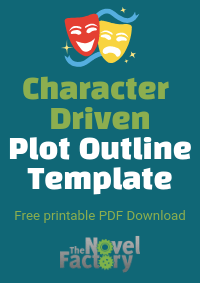
Character Driven Plot Outline
This story outline is driven by the development of a compelling character arc .
The protagonist begins with something missing from their existence, even though they may not be aware of it.
Through the story, they learn why they feel incomplete and must face their demons and deepest fears in order to evolve as a person and become whole.
Incomplete - establish the hero's 'want' and their 'need'
The protagonist is unfulfilled in their normal life. There will be two things missing – one thing that they think they want (like money, fame, a Porsche – you get the idea) and another thing which they haven’t thought of, but is the real thing that will give them fulfillment. (compassion, self-confidence, etc).
Unsettled - an outside force appears (e.g. invitation or threat)
The protagonist’s world becomes unsettled by an outside force. An invitation, threat, or attack, perhaps.
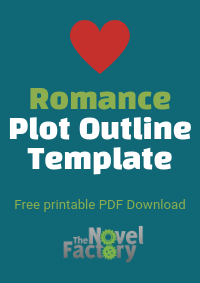
Romance Novel Story Outline
The classic romance story structure, including all the major story beats and complications.
Based on characters having personal character arcs and motivations that conflict with the romance aspect.
Introduce the protagonist (who feels incomplete)
Introduce the main character’s world. They may be successful in many areas of life, but clearly, there’s a gap when it comes to a loving relationship. Foreshadow the conflict that will create challenges for the romance to come. Establish the hero’s non-romance based goal.
The protagonist meets love interest but there is conflict
When the two main characters first meet it is extremely likely that they will hate each other on sight. Show how they are from different worlds, with strongly contrasting views on life.
Characters are forced to spend time together
Due to external factors, the characters are forced to spend time together, and even to cooperate to achieve a goal. They are still at odds, but the sparks are kindling some fire… A friend may even comment on it, but the couple-to-be both hotly deny there is an attraction.
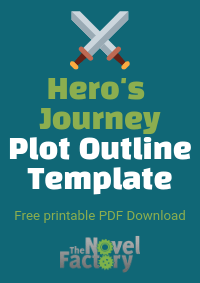
Hero's Journey Novel Plot Outline
The Hero's Journey, as proposed by Joseph Campbell, trimmed to the bone and applicable across all genres - not just sword-wielding fantasies.
The Ordinary World
To begin with, you set the scene and introduce the main character. This is the place to establish what’s missing from the main character’s life, and give hints about the story to come.
Call to Adventure
An external force challenges the main character. This is usually an invitation or a threat.
The protagonist often expresses reluctance to answer the Call to Action. They may be afraid or feel poorly equipped for such a challenge. Sometimes the reluctance is expressed by a supporting character, not the hero.
Meeting with the Mentor
The mentor is a character of authority to the protagonist. They provide advice and useful gifts, such as weapons or talismans. The mentor often reflects the tone of the story - a tragedy will have a one who is toxic or destructive (or one who is already dead), a children's fairytale will have a benevolent all-knowing one, a dystopia may have an unreliable one. The mentor is usually a recurring character.
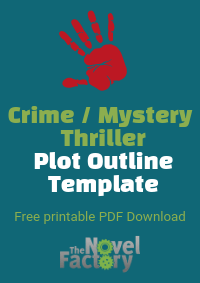
Mystery / Crime Thriller Plot Outline
A fairly detailed structure that explains how to develop the sleuth's inner character journey alongside solving the crime and uncovering deeper conspiracies.
Present the crime
Mysteries and crime thrillers often begin with a prologue in which the inciting crime takes place. The first crime is very likely to be a murder or kidnapping. This is from a POV that is not the main protagonist, it may be from the point of view of the victim, the killer, or an omniscient narrator.
Introduce the sleuth
Next, we meet the sleuth, who is the protagonist. This person is often a professional detective, but not always. Sometimes they are a normal person thrust into a situation that gives them no choice but to take action – usually because someone they love is missing or threatened.
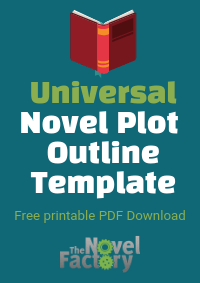
Universal Novel Plot Outline
Based on the hero's journey, but rejigged to make the terminology more generic and easy to apply across genres.
The Status Quo
Introduce the main character’s world and establish their want and their need. The character clearly has things missing from their lives and they are unsatisfied with their current existence.
The Complication
Something happens to shake the character’s world and offers them an opportunity, or creates a threat.
In pursuit of the goal, the character crosses some kind of barrier (could be physical but doesn’t have to be), which means it is not possible to return to their old life.
A New World
The character is now in a new and unfamiliar world, trying to navigate unknown rules and challenges.
External Obstacles
The character must face a series of conflicts, each of increasing difficulty and stakes. Some they will win, some they will lose.
Internal Obstacles (temptation)
The most compelling stories will pit main characters against their inner demons, forcing them to overcome them in order to become a better person.
Dark Moment
In order for the high of the climax to have the greatest effect, you should precede it by taking your character as low as they can go. Despite all the progress they’ve made against external and internal obstacles, something should happen at the end of the second act which makes everything fall apart and makes them certain that all is lost.
The Final Conflict
This is the final battle where they throw everything they’ve learned and everything they’ve become, against the great enemy - and in the vast majority of cases, they will be victorious.
The Return Home
Bring your readers back down to earth after the climax, show the hero's new normal and tie up any loose ends.
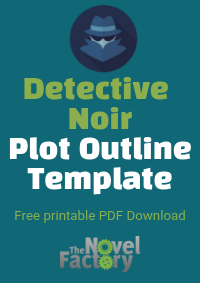
Detective Noir Novel Plot Outline
Drawn from the detective noir / hard-boiled genres, a dark mystery structure with dark undertones and plenty of betrayal.
The protagonist of a detective noir is often an anti-hero. An outcast, often someone who held a heroic position in the past, such as a police officer or soldier, but who has fallen from grace. A sense of alienation should be established and maintained throughout the story.
The siren walks in
A client will appear, seeking help with a case – usually a murder or missing person. They may appear vulnerable or wanting to help, but they will have a deep, dark secret that is bound to get the protagonist into hot water.
Although the femme fatale trope is common, there is no requirement for the siren to be female, or sexy, and in fact, mixing it up may make your story more refreshing.
Initial investigation
The protagonist begins their investigations, searching for clues. This will often be done at night, and in the shadows. Throughout the investigation, there should be a healthy amount of red herrings.
Note - click here to read about the difference between hard-boiled and noir.
And you can read more about the elements of detective noir here.
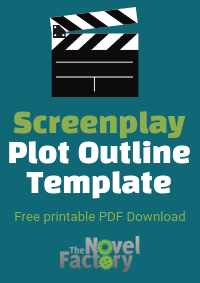
Screenplay Plot Outline
Based on Hollywood Blockbusters.
Stage I: The Setup
Create the world and transport readers there. Introduce your hero in their everyday life and create empathy with them. Hint at the hero’s inner conflict (their ‘need’).
Turning Point #1: The Opportunity (10%)
10% into the story something new and different must happen to the hero. The Opportunity begins the journey and presents outer motivation.
Stage II: The new situation
They find themselves in a new situation. The newness of the situation may be internal (a new emotional state or attitude) or external (change in circumstances / location). The hero tries to navigate this new, unknown territory and begins to formulate a plan for achieving their outer motivation.
Turning Point #2: The Change of Plans (25%)
The outer motivation transforms into a specific, visible goal with a clearly defined endpoint.
Stage III: Progress
The hero makes progress towards their outer motivation. They may receive training and / or mentoring. There are conflicts and setbacks, but overall they seem to getting closer to achieving their goal.
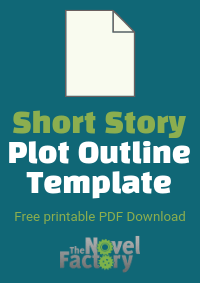
Short Story Plot Outline
A seven-point system for writing a short story.
A character
In a short story you can often get away with characters being larger than life, or having distinctive qualities that are more exuberant, because the reader won’t be experiencing the character for so long that these characteristics begin to become tiresome or irritating.
Is in a situation
Very quickly you need to introduce the character’s world and their place in it. What is interesting about this character and their life? Make sure the reader feels excited and intrigued.
With a problem
At the heart of all good fiction is conflict. What problem does your character have to solve? Try to get to the problem as quickly as possible (within the first few paragraphs) so the reader is hooked and needs to know how the problem is going to be resolved.
They try to solve the problem
The character should begin to make efforts to solve their problem.
But fail, making it worse
But these efforts have the opposite effect, and the originally small problem begins to grow into something really serious.

How To Write A Short Story Outline—Get It Done In 4 Easy Steps
- June 24, 2022
If you’ve got a short story idea but don’t know how to put it together in one literary piece, this article can help you get started.
Below we’ll offer some essential tips on how to write a short story outline.
We’ll also examine why an outline is so helpful for crafting stories that engage and hook readers.
First, let’s develop a better understanding of a good short story outline and later on discuss the outlining process.
What is a story outline?
The best short stories begin with an outline.
An excellent short story outline is a roadmap for the author to track character arcs and critical plot points . It can be a piece of paper, a word document, or an entire PowerPoint presentation. That’s up to you, and where you write the outline depends only on your preferences.
Authors can regularly check in with their story’s development with an outline. Without it, one risks following too many trajectories, ultimately rambling and failing to move the plot along effectively.
The outline is a map or bird’s eye view of the story’s main events, plot points, and structure .
For example, a typical story involves five main elements:
- Beginning ( exposition )
- Rising action (introduction of an obstacle to the main character’s goals)
- Climax (character faces that obstacle)
- Falling action (the events of the story that happen post-climax)
- Resolution, or denouement.
You must write a sentence or two from each part of that general structure in a basic outline .
Do I need an outline?
Some people write stories with no plan or outline. Others have all the details planned out.
This technique is known as writing ‘by the seat of one’s pants,’ an approach used by some writers who prefer to create as they go and already have plenty of writing experience.
However, if you’re not yet a master writer and are looking for more support in your writing process, an outline is a wise choice.
The benefits of writing an outline
Outlining a story offers many benefits.
Writing with flow and coherence isn’t always easy. Often writers experience difficulty with the flow, known as writer’s block, and a bad case of writer’s block can set you back.
It may take days or even weeks for it to pass naturally. Outlines are a powerful tool that helps you overcome that dreaded writer’s block.
When you have a structure in place, you can always refer back to that structure when you lose your way.
Some of the main benefits of a story outline include:
- Checkpoints for the story
- Flesh out the characters to make them richer, more three-dimensional
- Track character arcs and character development
- Develop plot points to heighten or enrich the story’s main conflict
- Explore the setting and changes in setting
- Gain an overview of how different elements (plot, characters, setting, theme) interact and move the story
New writers sometimes believe that a story must be written chronologically. They over-focus on the linear progression of the narrative and may feel like their process is unstructured if it doesn’t take place chronologically.
However, more experienced writers understand that the linear progression of the narrative is what one can work on throughout several drafts.
The outline is the prep work for the first draft.
It is important to envision a basic linear progression of events within the outline – the introduction (exposition), rising action, conflict, falling action, and resolution.
Still, feel free to spend one day or one week on the characters, another session on the setting, another on themes and how they play out, and another on plot development.
How to write a short story outline
So, how do we get started with an outline?
There is no universal step; your first step will depend on you as a writer, the parts of your story that excite you the most, and your preferences as to which areas of your story you want to flesh out first.
Instead of offering a step-by-step chronological guide for outlining a short story, let’s explore the different elements of your outline. It’s up to you which you’d like to deal with first.
The four main elements of your outline we’ll explore are:
- Plot points
1. Identify the premise
The premise is the overall idea of your story. It’s the ‘why’ behind your writing.
What story do you want to tell, and how do you want to tell it?
To begin with, write statements about your story. What happens in it? Why is it interesting?
After you’ve got some ideas on paper, try condensing your story’s premise into a single sentence. Can you sum up the entire story in one sentence?
Consider the following one-line premises for well-known stories.
- Wizard of Oz – A young girl enters a magical world through a tornado and must find the wizard to help her get back home.
- To Kill a Mockingbird – A young girl sees her father defend a black man against false accusations, racism, and prejudice in a court of law, with dangerous consequences for the family.
- The Hunger Games – A teenage girl volunteers to enter the Hunger Games – a fight for survival with only one winner – to help her district.
Your premise is something you can return to time and time again when you lose track of your thoughts. Returning to the premise helps you carry the story from beginning to end.

2. Know the setting
The setting is the world in which your story takes place.
Most stories have multiple settings that complement or contrast each other to vivify the reading experience.
Know where your story takes place.
Do your characters live in apartment buildings or houses in the countryside? Does the story take place mainly outdoors or indoors? How and when do the settings change, and why?
Writing the setting of a story is known as ‘worldbuilding.’ As a writer, it’s your job to create the world in which the characters live.
A well-built world makes it easy for the reader to immerse themselves in the story and follow the narrative engagingly and excitedly.
3. Thresh out plot points
As mentioned earlier, the five main elements of short story writing are:
In the exposition, you introduce your main character(s).
You can flesh out the characters in later drafts and throughout the story but to begin with, introduce the characters and their goals.
It would be best if you decided on your protagonist’s main goal for your outline. What do they want? What motivates them to achieve their goals?
Rising action
The rising action introduces a problem or obstacle that stands in the way of the main character achieving their goal. Again this is to be fleshed out later in your drafts, but in your outline, you only need to identify the problem.
How does your main character deal with the obstacles they face? What is the solution to their problem?
The solution is rarely easy – the challenge is what makes the story intriguing.
Knowing how your character will deal with the problem helps you craft a narrative about how they do so.
Falling action
What happens after the central conflict? How does the character’s attempt at overcoming their obstacle influence the rest of the story?
The resolution is the ending of the story. You don’t need to tie up all the loose ends, but it should be a somewhat satisfying ending.
Once again, the outline is not the time to flesh out the details. Have a general idea about how your story will end so you can focus the narrative on getting to that point.
Write a few lines or sub-premises for each structural element. These five elements help you frame the story so that you can break up each section.
As you write, you can return to your outline to help you stay focused. Whether you’re writing long or short fiction, involve these five essential elements.
4. Work on character development
Outline some basic details about your main characters. During character development , the finer details are to be explored as you write and details may change slightly or significantly as you get to your second and third drafts and the story starts to come together.
Main character
Your protagonist’s persona is often the one that hooks the reader’s attention.
Who is your main character, and what kind of life do they live? What are their beliefs and background? How do they see the world?
Character arcs
Some short stories follow one character, while others feature an entire cast of characters.
In your outline, map out those characters’ arcs .
How do they develop throughout the story? How do the events and changes within the story affect those characters? Take one character – do they begin as a hero or villain? Does their role change throughout the story? What causes that change?
A general idea of a character and character arc helps you stay focused.
As a writer, it’s crucial to demonstrate consistency within the world of your story. A reader immersing themselves in your story may feel considered or disappointed if your character is inconsistent.
Understandably, events and plot points in the story may change the character’s feelings and worldview, but those changes should be relevant to the story.
Protagonist vs. Antagonist
If there is both a protagonist and an antagonist in your story, use your outline to identify the premise of their relationship.
Why are they enemies? How do one’s goals interfere with those of the other?
Understanding and outlining the relationship dynamic between your pro- and antagonist helps you follow that relationship arc throughout the writing process.
A ready-made outline helps you stay on track and keeps the protagonist/antagonist relationship fresh and exciting.
How long is a short story?
Short stories vary in length but generally fall somewhere between 1,000 and 10,000 words.
A story with fewer than 1,000 words is flash fiction , while stories over 10,000 are typically known as novellas or novelettes.
10,000 words can seem like a lot, but when you’ve got a good short story, 10,000 words can feel like not enough.
Short story writers face challenges in keeping the entire story short while offering the reader an immersive experience.
Seasoned short story writers understand that condensing a story into fewer than 10,000 words means leaving out some of the finer details of a character or the setting.
Your job as a writer is to identify the most important details and plot points and leave the rest to the reader’s imagination.
Tips for writing a great short story
Writing an outline is just one tip for writing a great short story. There are many other tips to consider.
For example, before you even begin your outline, how do you know what to write about in the first place?
All great stories, from short stories to novels, begin with an inspiring idea. So, how do we get inspired?

Read as much as possible
William Faulkner suggests that we:
“Read, read, read. Read everything — trash, classics, good and bad, and see how they do it. Just like a carpenter who works as an apprentice and studies the master. Read! You’ll absorb it. Then write. If it’s good, you’ll find out. If it’s not, throw it out of the window.”
Reading classic short stories, novels, newspaper articles, magazines, or blogs is a great way to find inspiration for your next short story.
Perhaps you imagine a scenario in which the characters of an existing story behave differently or live under different circumstances.
Maybe you like an author’s tone of voice or use of humor and feel inspired to write in a similar style.
Be inspired by what you’ve read to stir your passion for writing a good story and come with fresh short story ideas.
Get feedback
If you’ve got an outline, a first draft, or even just an idea in your head, share it with others and get some constructive feedback.
Speak to writers and non-writers alike and ask them how they feel about your story? Do they find it exciting?
Does it make sense to them? Do they find it relevant? Do they have any helpful ideas?
Constructive feedback is vital to any creative person. It helps us see our work from different perspectives and lets us know if we’re on the right track.
Keep writing
Every writer faces a creative block at some point.
Experiencing this block does not mean you’re a terrible writer; it just means you need more creative inspiration.
One of the most effective ways to overcome writer’s block is simply writing from your consciousness stream.
If you’re writing an outline and stuck somewhere, such as how your main character changes from an emotional state to another, start writing whatever comes to mind.
Ninety percent of what comes out may be irrelevant, but that relevant ten percent can get you over the line.
Your outline is far from your final draft.
Throughout the writing process, you’re entirely free to chop and change bits of the story as you see fit.
Perhaps a character’s arc takes a different turn, or a feature of the setting is changed. Change is something you should embrace as a creative.
Alice Munro, the 2013 Nobel Prize for Literature winner, explains that ‘any story that’s going to be any good is usually going to change.’
As a writer, you may have several short story ideas floating around your mind at once. That’s great – it’s a sign that your creative juices are flowing.
Still, it’s essential to cultivate a focus on a single story.
Outlining your story is important because it helps you stay focused on that short story idea, rather than allowing thoughts, plot points, and character ideas from other potential stories to get in the way.
Without an outline, you may call on whatever inspiration you find at the moment to help you overcome writer’s block and get your story finished.
It’s essential to seek inspiration, but you don’t want to dilute your story with content and ideas from another.
Use the outline to help you stay on track and give the one story idea the focus and attention it deserves.
Leave a Comment Cancel Reply
Your email address will not be published. Required fields are marked *
Save my name, email, and website in this browser for the next time I comment.
Sign up to our newsletter!
Related articles

120 Motivational Quotes About Writing To Inspire A New Writer Like You

How To Register A Kindle On Amazon To Enjoy Your Ebooks In 4 Easy Ways

How To Market A Self-Published Book And Be Profitable In 9 Easy Ways
Story Outline Examples
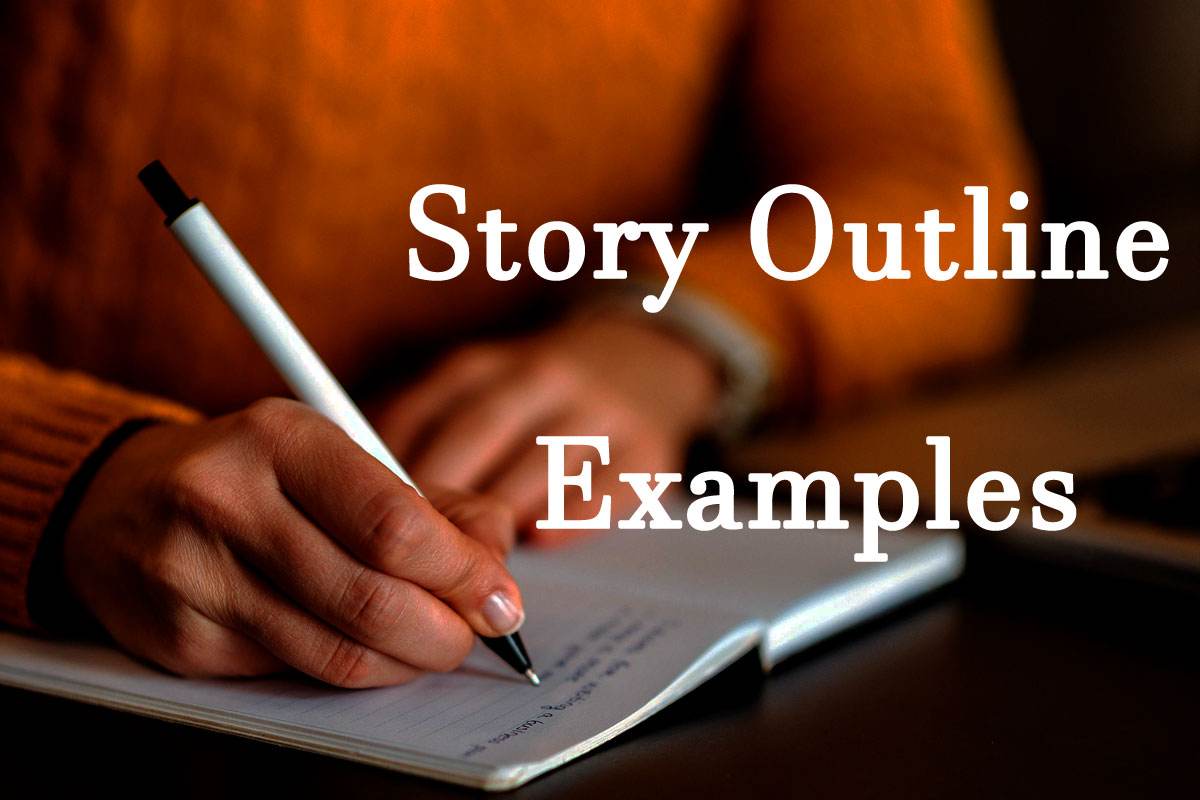
It might be difficult to plot out your entire story. You've had some time to start establishing your universe, plot, and characters, as well as your moral grey area and primary issues, and now you're faced with the difficult challenge of piecing it all together into a cohesive story—and keeping a reader's attention. And this is where the story outline examples will help you by giving you an idea on how to properly concise your information into a cohesive story.
Time spent on a story outline gives you foresight into your book. Consider yourself a boulder, peering up at a high cliff. Simply leap onto the ledge and watch what happens. You could get to the top this way by planning it properly.
What is a story outline?
A story outline is a file that includes crucial planning information on the structure, storyline, characters, events, situations, and other aspects of your novel. It's the framework of your story.
An outline can range from a one-page formal document to a multi-page visual mind map that employs diagrams to depict the relationship between data and concepts. If you have enough room, put your phrases on index cards and tape them to the wall to make it simpler to see and manage the components. Each incident should be described in a simple, concise sentence.
How to write a good story outline?
Although no two outlines are the same, there are a variety of ways to get the book outline process started. From a summary to a detailed outline, or using Randy Ingermanson's snowflake method or the bookend method to approach the craft, there's something for everyone.
Aside from detailing characters and plot elements for tale structure, your outline should provide you with a basic feel of your novel's direction, as well as the main conflicts and tensions that will keep readers interested. While drafting your outline, keep the following questions in mind:
- What is the story's major contract? By the end of the story, you must have fulfilled the commitments you have made to your audience.
- What kind of time constraints are you putting on your protagonists?
- What is at risk for the novel's main character? Is the primary protagonist's stress level increasing as the story progresses?
Example 1: Harry Potter
It is an adaptation of the book written by J.K. Rowling's blockbuster children's novels about Harry Potter, a young boy who discovers on his 11th birthday that he is the orphaned son of two great wizards and has his magical abilities. As an unwanted child, he is taken from his household to study at Hogwarts, an English wizarding boarding school. There, he meets a group of students who become his closest friends and help him figure out what happened to his parents.
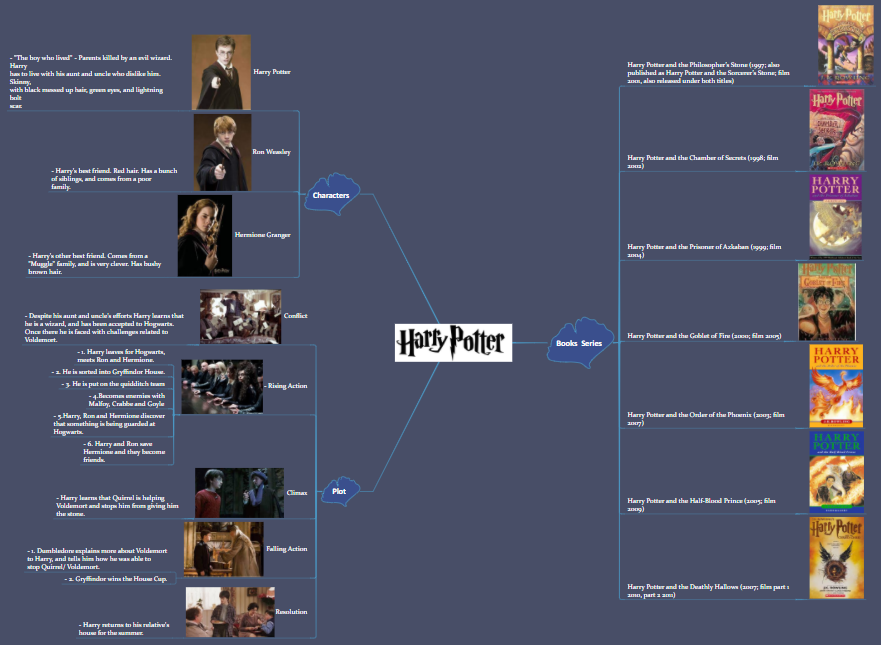
Example 2: Shawshank Redemption
- The entrance of a convict called Andy Dufresne, whose stint at Shawshank had an impact on everyone's life, is recounted by Red, the narrator. In 1947, Andy was sentenced to life in prison for the murders of his wife, Linda, and her boyfriend. Despite all the evidence pointing to his being at the crime site on the night of the killings, Andy has only ever defended his actions, which Red finally accepts.
- Andy has considerable problems adapting to prison life at first, especially because many of the other inmates regard him as snobbish. Despite the difficulties he experienced in prison, Andy never complained or lost faith in himself, and he continued to plot his escape.
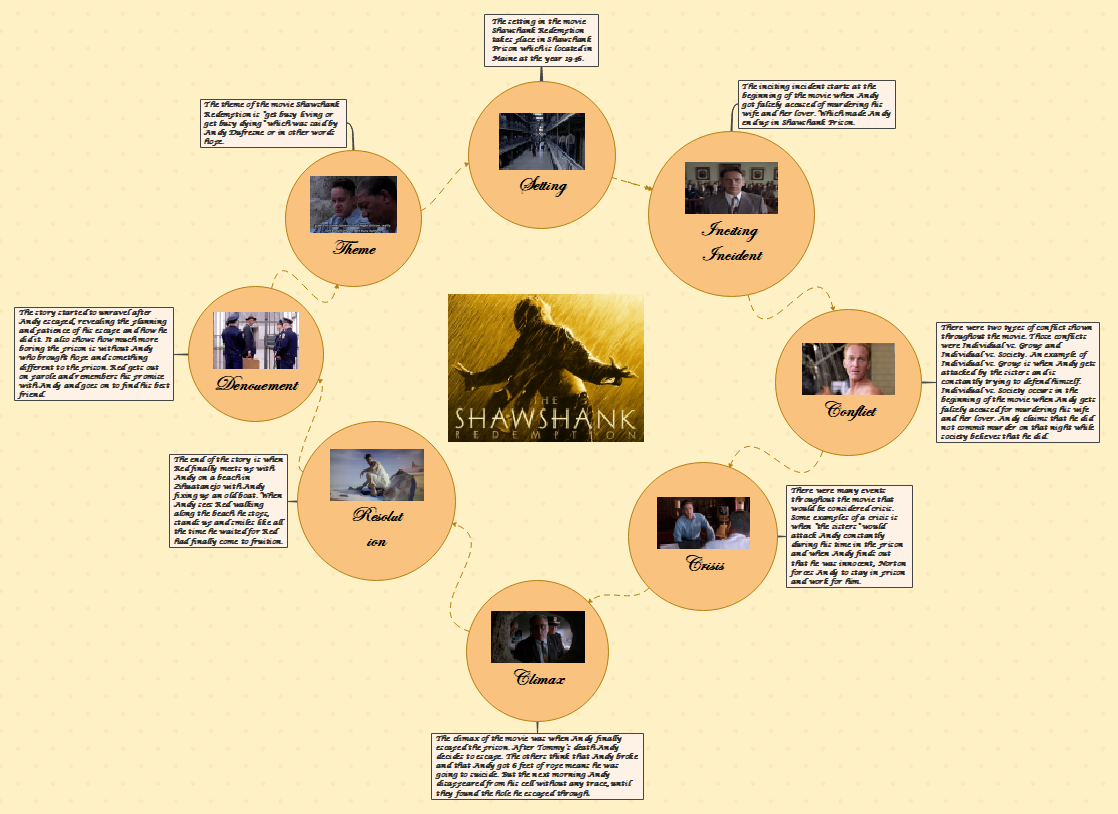
Example 3: White Chapel Vampire
- Dr. Watson and Sherlock Holmes investigate rumors that a vampire is on the loose in London. The killings are thought to be the act of a vampire who has recently returned from a job in Guyana. They have a continuing dispute over the supernatural while they examine the deaths, with Watson having faith in vampires and Holmes staying suspicious until he can establish the killings were committed by a real person rather than an undead entity.
- To truly understand the killer, Holmes disguises himself as a monk and explains that the vampire was Brother Abel, who was seeking vengeance on the monks. Mrs. Hudson offers Holmes his pipe on Baker Street that was brought up by the guy who saved Holmes from an accident, and the movie concludes at that scene. When Holmes asked Mrs. Hudson claimed that his name was Reginald Church.
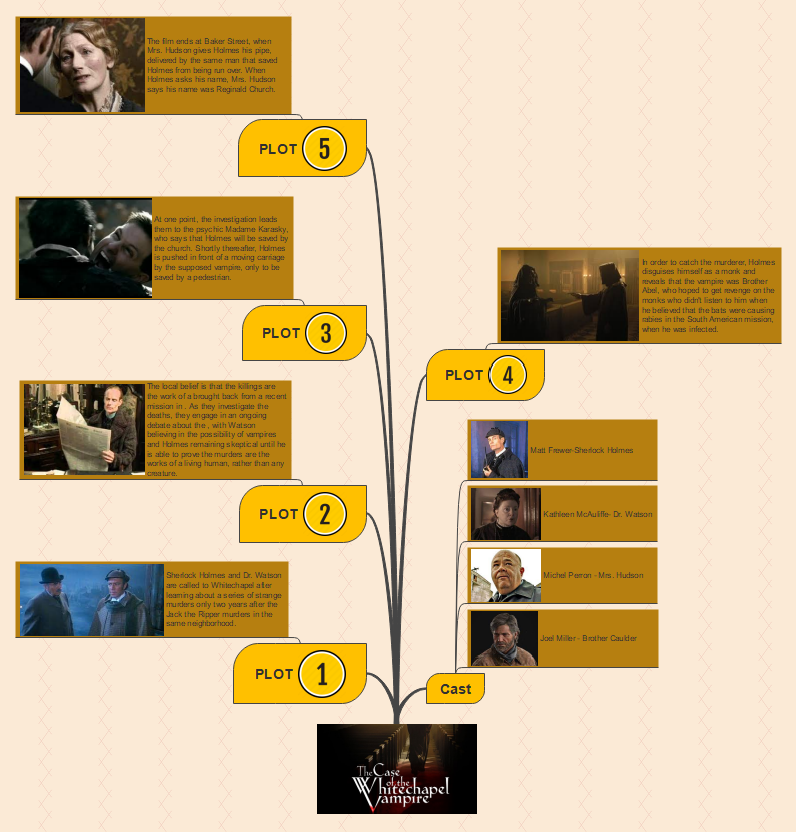
Example 4: Romeo & Juliet Act 2
Act 2 is primarily on the main character's emotional roller coaster. Because conflict is so important in this act, give your protagonists a variety of hurdles to conquer. Struggle does not always imply a physical conflict; it may also refer to a variety of hurdles that prevent the protagonist from accomplishing his or her objective or ambition.
In exchange for her love, Romeo admits himself and promises to give up his identity. Romeo seems nonchalant when Juliet warns him that if he is seen with her as a Montague, he will be slain. The two proclaim their love for one another and agree to marry after much contemplation. Romeo promises to send a messenger the next day to notify Juliet of his wedding arrangements. As the morning rises, the drama comes to a close, and Romeo exits to seek help from Friar Laurence.
Juliet makes a marriage proposal to Romeo. That afternoon, Friar Lawrence agrees to marry Romeo and Juliet. Tybalt writes Romeo a letter in which he expresses his desire for vengeance for the Montagues' collapse of the feast. Friar Lawrence wedded Romeo and Juliet in secrecy.
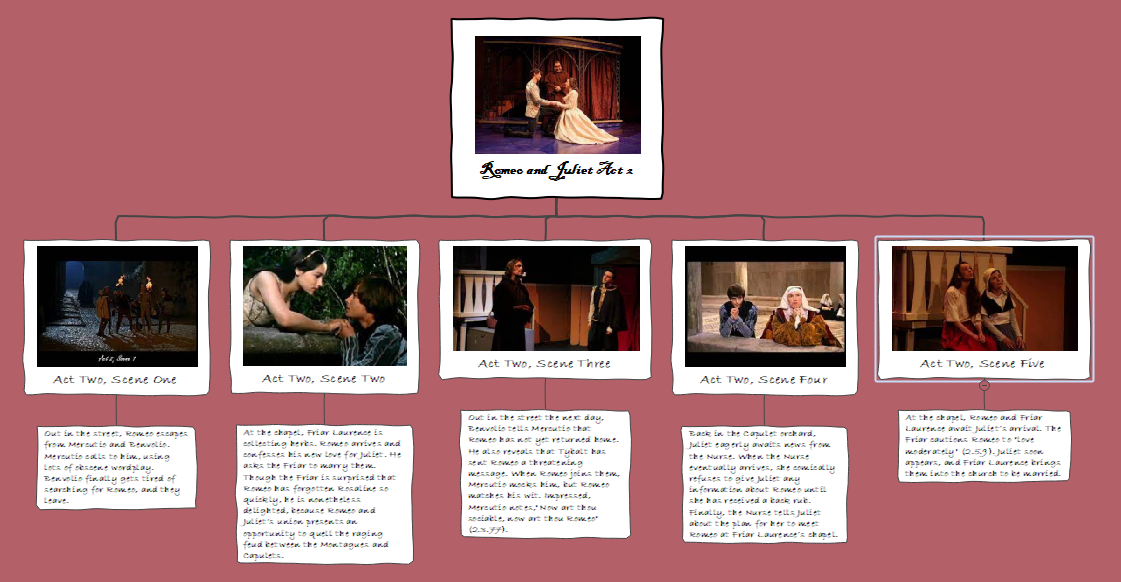
[Free] Best 10 BCG Matrix Examples for Students

To-Do List Mind Map Template

The 9 Popular Types of Mind Map

7 Types of Organizational Charts (With Examples)

Gastritis Mind Map

Nursing Concept Map Examples

- Development
- Scriptwriting
How to Write a Script Outline for Film and TV (Free Template and Examples)
he actual writing of your script is the fun part. But, just like any form of writing, you have to know where you’re going first. Organization is important. That’s where a script outline comes into play. Understanding your central character’s desire, and capturing the scenarios they attract for themselves, should guide that process.
There is no straightforward way to know how to outline a screenplay. But these tried-and-true guidelines will help you crack the structure for your character’s journey.
Watch: Anatomy of a Screenplay — Ultimate Guide
Subscribe for more filmmaking videos like this.
Create a Script Breakdown
1. character should inform how to outline a screenplay.
To learn how to outline a screenplay, you must start with a basic plot trajectory. And this can only come from understanding the desires of your protagonist .
Think about what your character wants, and what progression of increasingly-difficult obstacles (and people) he or she will organically attract.
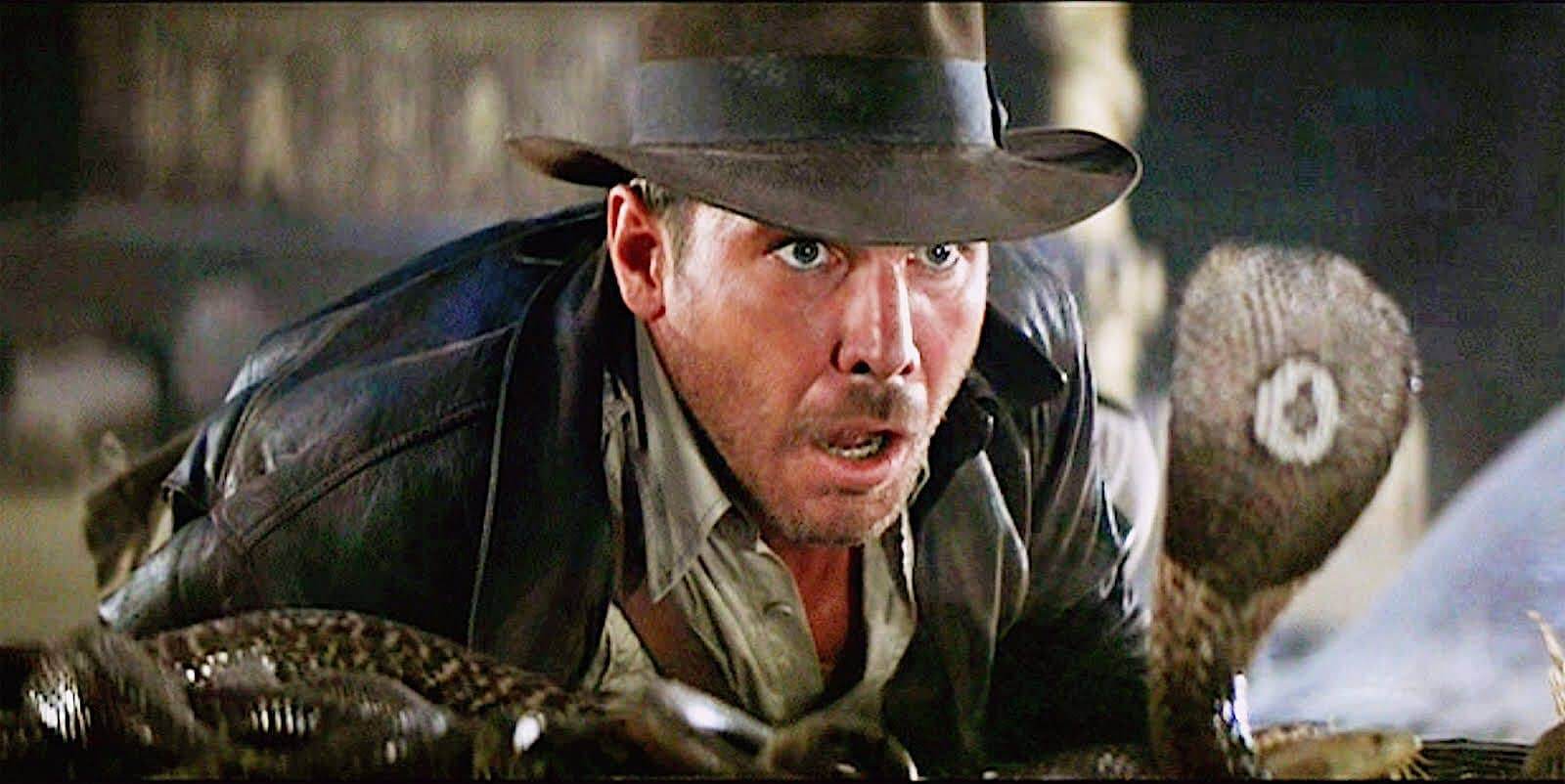
Upping the tension is crucial in a screenplay outline. Raiders of the Lost Ark (1981)
Freebie: script outline template bundle.
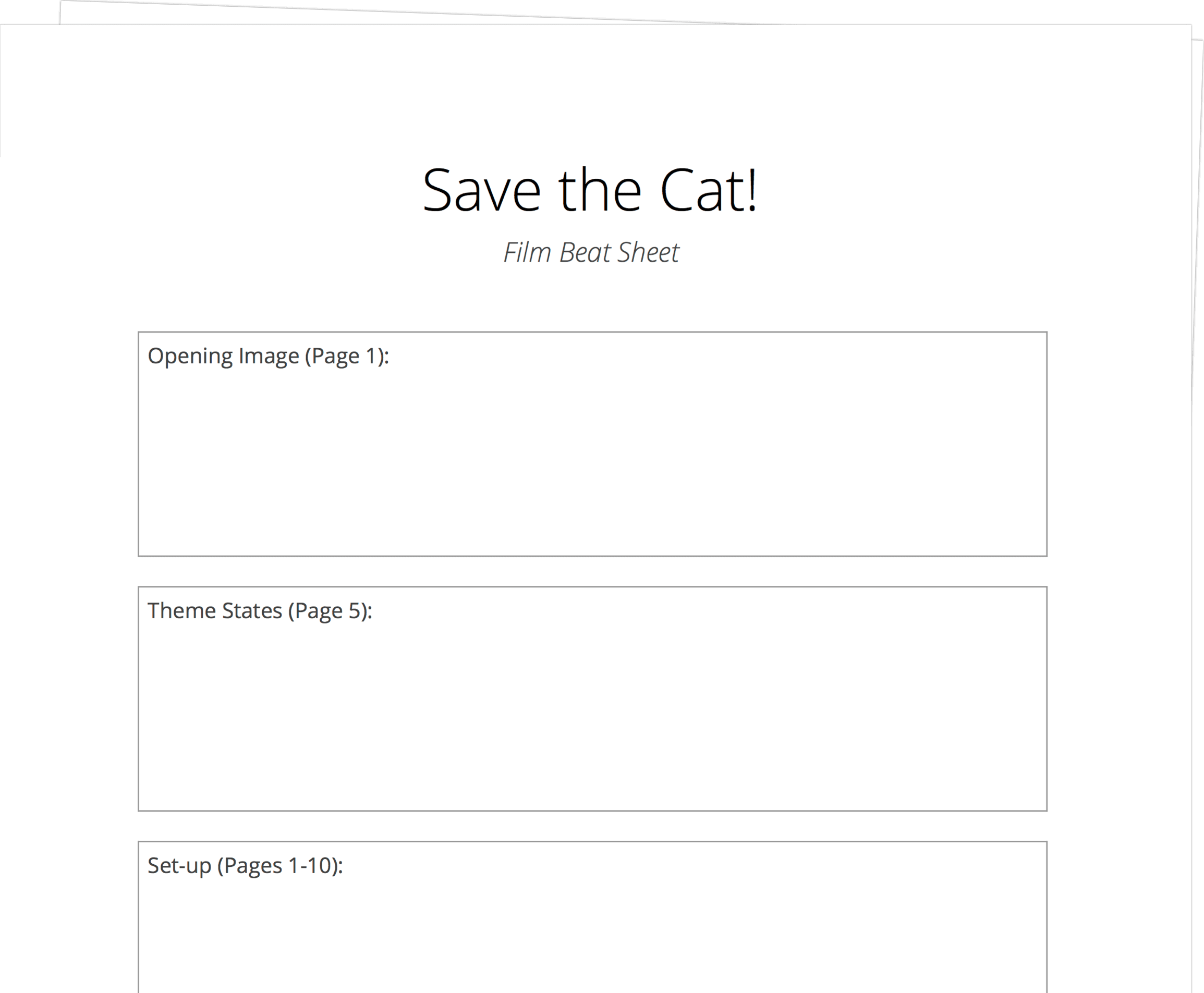
Download FREE outline bundle to get your story on the right track. We're including: Save the Cat Beat Sheet, The Story Speedometer, Simple Script Outline Template, and the Treatment template for TV shows.
Whether or not they get what they want, decide how your protagonist changes throughout their journey. This is their character arc .
The character arc is crucial to the script outline. You take the audience on a journey, therefore we need to track the character's emotions as we go.
All of these things must be determined in order for you to grapple with your act structure -- the foundation of your story.
Related Posts
Free worksheet: write stronger characters →, create a script breakdown, 2. use act structure to organize the parts of your script outline.
Thankfully, you don’t have to re-invent the wheel every time you need to lay down your structure. In fact, plot structure is as old as Aristotle.
Simply put, act structure means having a beginning, middle, and end. In Film and TV terms, this referred to as three-act structure .
One very popular resource for dramatic structure is Blake Snyder’s Save the Cat. Its very simple formula breaks your plot into eight distinct “beats.” Each beat has suggested page counts for when they need to happen. But you don’t have to be strict about it.
A beat sheet will help you nail the major plot turns that round out your character’s arc. You can then flesh these out in your script outline.
Remember, plot is character. They’re two sides of the same coin!
FREE TEMPLATE: THE BLAKE SNYDER BEAT SHEET→
3. extend your beats into scenes with a step script outline.
Your script outline, often referred to as a “step outline,” is where you extend your high-level beats into individual scenes.
Your beat sheet is high-level. So the number of scenes required to realize those beats are entirely up to you. There are resources out there to give you a rough estimate of how many scenes you need per act. But again, it’s about what your character’s arc requires -- there are no rules.
You can include acts, scene numbers, and scene headings to organize your script outline.
And try to connect the dots with as few scenes as possible. Be economical, and don’t bore the audience with too much exposition. Revisions will help with that.
Make sure there’s an inciting incident in act one, and plenty of conflict in each beat.
READ: HOW TO WRITE AN INCITING INCIDENT→
4. writing scenes for your script outline.
Every writer is different. Some writers like getting very specific with their script outline. Others need a map of generally where they’re going but worry about over-engineering their plot if they get too detailed.
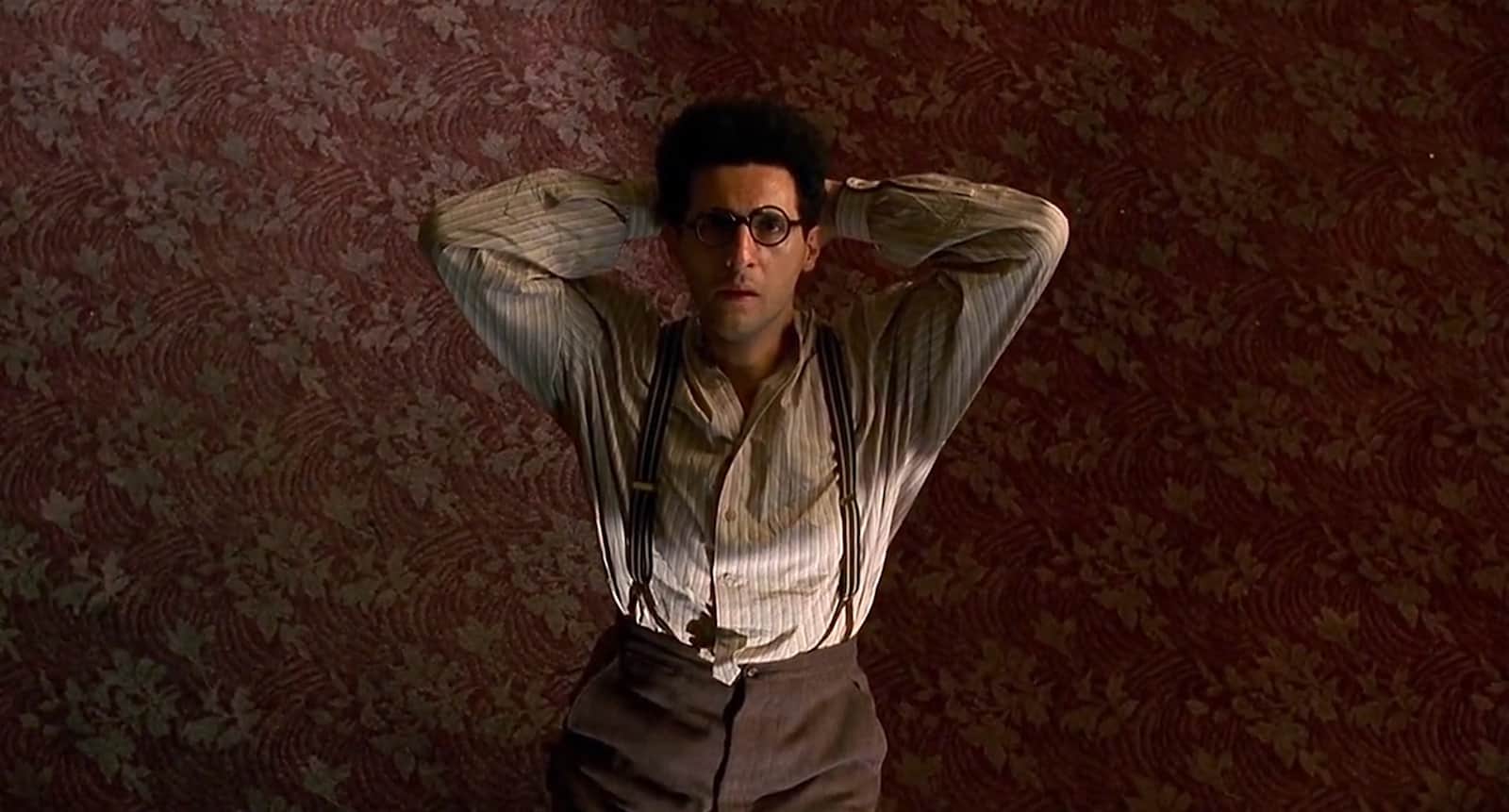
Having a script outline helps clarify the different parts of a script. Barton Fink (1991)
How detailed you want to get is entirely up to you. But it’s fair game to include detailed descriptions, characterizations, and even dialogue if you so choose.
I like to get pretty detailed. That way, when I sit down to write, I’m only worried about writing the scene in a compelling way. However, I have also experience getting to a scene I thought I carefully outlined, only to realize that it didn’t work. D’oh!
Point is, you can’t plan everything in a film outline. At some point you just need to get started. After all, writing is rewriting.
5. The golden rule is “never and then”
Script outlines can be boring to read. Make sure your scenes have a direct cause-and-effect relationship with one another.
Years ago, South Park creators Trey Parker and Matt Stone shared a very helpful nugget on how they mastered this technique.
Once you have all of your scenes together in your script outline, think about how you would explain them to someone.
You should never need the words “and then” in between any of your scenes. That would disrupt the flow of cause-and-effect crucial to any plot.

A film outline is less cumbersome when the cause-and-effect is clear. Raiders of the Lost Ark (1981).
If you were explaining the plot to someone, you’d follow this scene with something like: “... but soon the Nazis arrive, steal the ark from him, and seal him inside.”
If Indiana Jones, say, got lonely and struck up a conversation with one of those snakes then… yeah, I can hear you yawning.
The point is, the words “but,” “therefore,” and “so” denote cause-and-effect. “And then” does not. So this is a good litmus test for knowing if your plot is on track.
6. Find a script outline example that suits you
Looking at examples from professional writers can inform how to outline a screenplay your own way.
THE ONE-PAGE SCRIPT OUTLINE
If you’re just looking to write a pithy list of scenes to get you started, you’d be well-served by the one-page outline accomplished screenwriter John August used for his script Big Fish .
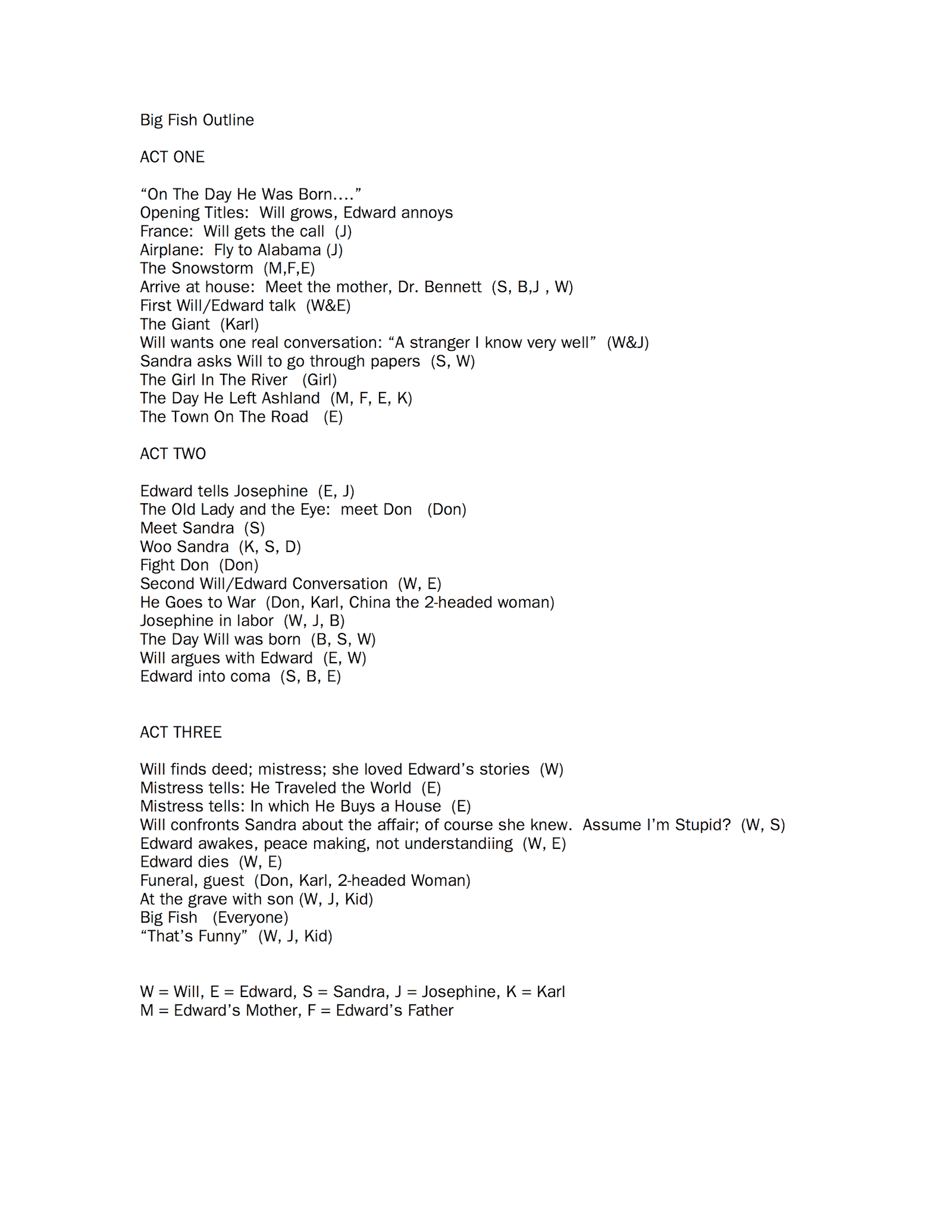
A one-page script outline example from John August
The sequence outline.
Writing on his website, August said he then made a longer sequence outline after writing his first draft. He used this to evaluate how well the script was balancing the time spent in the different worlds within his story.
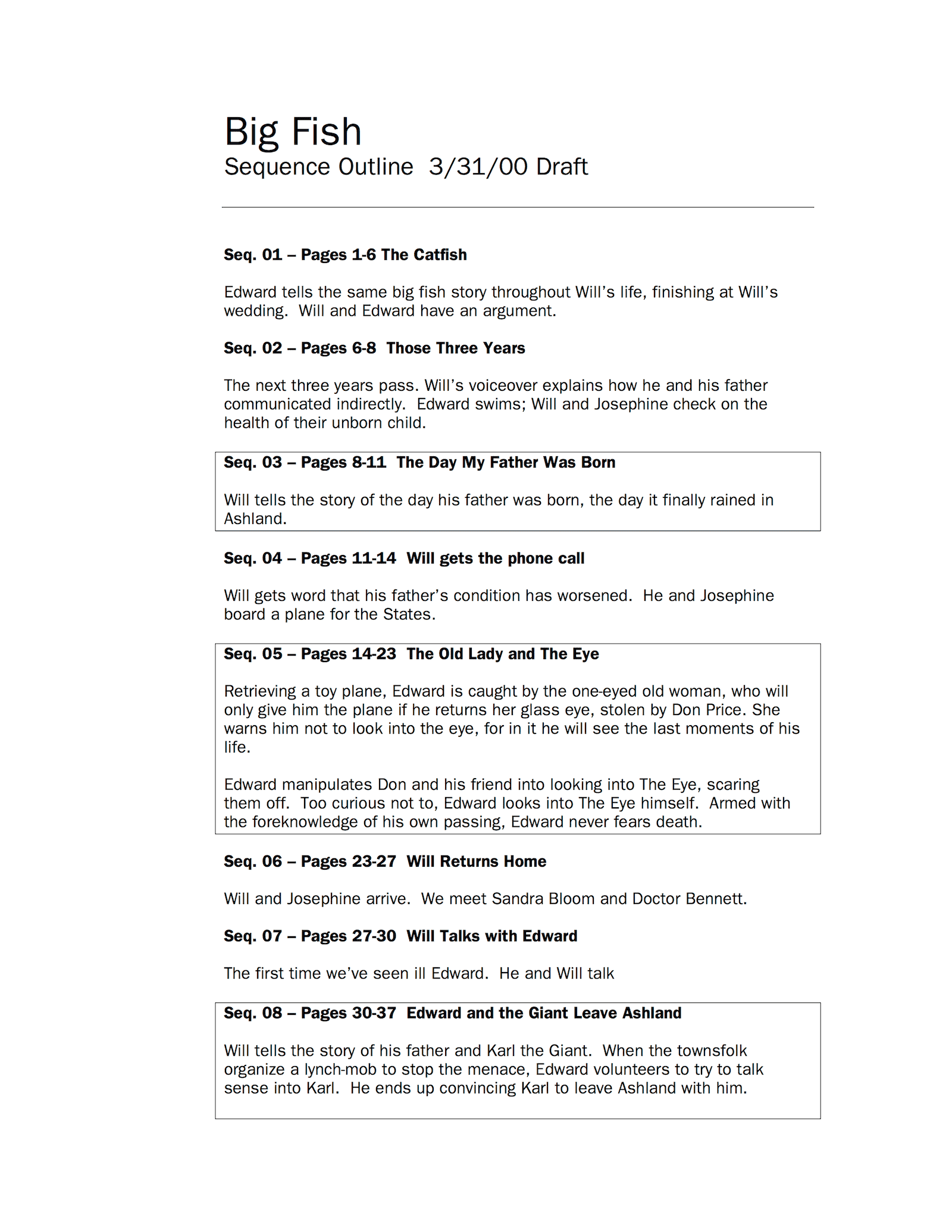
A sequence script outline example from John August
The basic screenplay outline.
Oscar-winner Tony Gilroy said 30-to-80 page outlines are necessary for his own process. There aren’t many publicly available examples of long outlines like this to share, however WikiHow hosts a script treatment example that is shows the gist (albeit at only 11 pages).
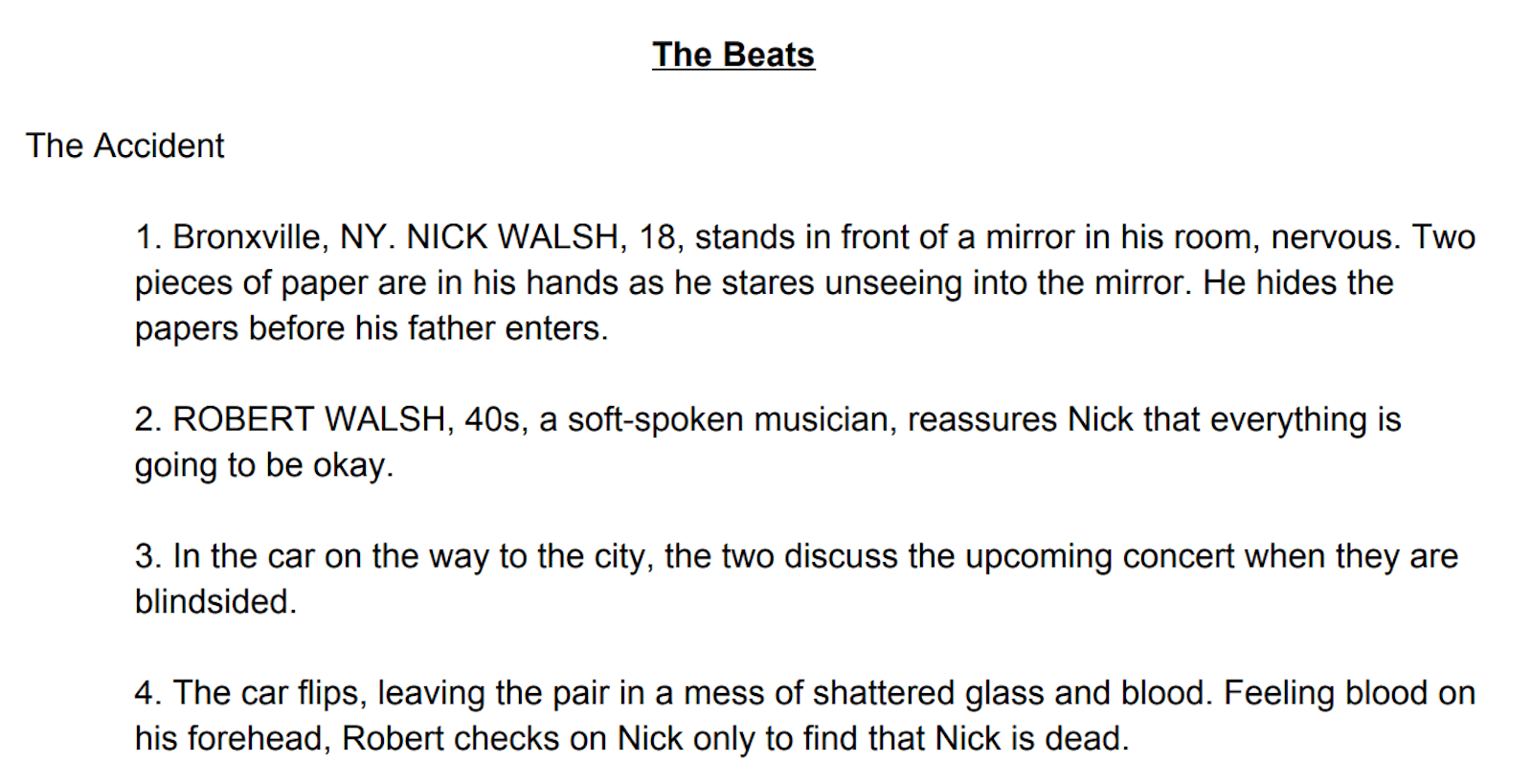
A very straightforward script outline template PDF, compliments of WikiHow
Launch your writing career.
As John August puts it, “The correct way to write your screenplay is whatever gets it written.” We hope learning how to create a script outline with our free template gets the job done for you.
Ready to become a professional writer? We have some proven tips that will help you get your career on track.
Comment below with your favorite story beats of all time or with some films you want to see us break down.
Up Next: Proven Ways to Launch Your Writing Career →
Easily create script breakdown sheets online..
Import scripts. Tag elements like props, wardrobe, and cast. Create breakdown summaries and DOOD reports in a snap.
Learn More ➜
- Pricing & Plans
- Product Updates
- Featured On
- StudioBinder Partners
- The Ultimate Guide to Call Sheets (with FREE Call Sheet Template)
- How to Break Down a Script (with FREE Script Breakdown Sheet)
- The Only Shot List Template You Need — with Free Download
- Managing Your Film Budget Cashflow & PO Log (Free Template)
- A Better Film Crew List Template Booking Sheet
- Best Storyboard Softwares (with free Storyboard Templates)
- Movie Magic Scheduling
- Gorilla Software
- Storyboard That
A visual medium requires visual methods. Master the art of visual storytelling with our FREE video series on directing and filmmaking techniques.
We’re in a golden age of TV writing and development. More and more people are flocking to the small screen to find daily entertainment. So how can you break put from the pack and get your idea onto the small screen? We’re here to help.
- Making It: From Pre-Production to Screen
- What is a Light Meter — Understanding the Photographer's Tool
- What is Metonymy — Definition, Examples & How to Use It
- What is a Short Story — The Art of Brevity in Literature
- What is an Action Hero — Best Examples & Defining Traits
- What is a Movie Spoiler — Types, Ethics & Rules Explained
- 358 Facebook
- 46 Pinterest
- 23 LinkedIn

- [email protected]
- Shapiro Library
- SNHU Library Frequently Asked Questions
FAQ: How do I write an outline?
- 7 Academic Integrity & Plagiarism
- 60 Academic Support, Writing Help, & Presentation Help
- 27 Access/Remote Access
- 7 Accessibility
- 9 Building/Facilities
- 7 Career/Job Information
- 26 Catalog/Print Books
- 26 Circulation
- 128 Citing Sources
- 14 Copyright
- 310 Databases
- 24 Directions/Location
- 18 Faculty Resources/Needs
- 7 Hours/Contacts
- 2 Innovation Lab & Makerspace/3D Printing
- 25 Interlibrary Loan
- 43 IT/Computer/Printing Support
- 3 Library Instruction
- 37 Library Technology Help
- 6 Multimedia
- 17 Online Programs
- 19 Periodicals
- 25 Policies
- 8 RefWorks/Citation Managers
- 4 Research Guides (LibGuides)
- 217 Research Help
- 23 University Services
Last Updated: Apr 01, 2024 Views: 2
What is an outline.
An outline is a brainstorming method that you can use to organize your writing. It helps you group your paper's main ideas with their supporting points, and put them all in a logical order. Many students find that creating an outline before they write their paper helps keep them on track and makes the writing process a little easier.
How do I Format an Outline?
Neither APA nor MLA have specific formats for outlines, so please check with your instructor for a preferred format if you are doing an outline for an assignment. There are a few different common kinds of outlines, but a common one is an alphanumeric outline using Roman numerals and letters - see below for an example!
Example Outline - Alphanumeric
Thesis: (Thesis Statement)
- Detail about that idea
- Detail about that second idea
More Information
- Writing Process This link opens in a new window - includes outline and prewriting information (SNHU Academic Support)
- Tips for Organizing Your Essay (Harvard University) This link opens in a new window
- Four Main Components for Effective Outlines (Purdue OWL) This link opens in a new window
Further Help
Campus students.
To access academic support, visit your Brightspace course and select “Tutoring and Mentoring” from the Academic Support pulldown menu.
Online Students
To access help with citation and more, visit Academic Support via modules in Brightspace:
- The Complete Guide to Using Academic Support via Brightspace This link opens in a new window
- Accessing Writing STEM Help This link opens in a new window
- Share on Facebook
Was this helpful? Yes 0 No 0
Frequently Asked Questions (FAQs) are a self-serve option for users to search and find answers to their questions.
Use the search box above to type your question to search for an answer or browse existing FAQs by group, topic, etc.
Tell Me More
Link to Question Form
More assistance.
Submit a Question
Related FAQs

IMAGES
VIDEO
COMMENTS
Consider details like the temperature, the color of the sky or the walls, the time of day, etc. Include unique descriptions and objects to make the reader fully present. The world of your story should be just as alive as your characters. Most importantly, tell us how the character feels in each scene.
Write your plot points on the sticky notes and stick 'em on your surface. You can color code the sticky notes for different subplots or character perspectives, and you can include as many sticky notes as you feel you need. This method is nice because it allows you to physically see plot holes or gaps in the story.
Give it a day or two, and then read back over your outline. Make sure every plot point and scene leads naturally up to the major plot elements and that the story flows. See if there are any gaps and fill them. Add in any other notes, scene ideas, and bits of dialogue that come up as you do this.
In this post, I'll share the key steps I've found most useful for outlining novels before writing the first draft. How to outline a novel: 1. Choose your main character. 2. Give your main character a big problem. 3.
Then expand it into a paragraph, adding the characters and the narrative arc. Proceed to create character summaries and gradually build the summaries into full character profiles. Create a list of the major scenes and organize them into a logical sequence. Then write a paragraph describing each scene.
Writing a good story requires thorough structure and careful attention to detail. Here are four writing tips to help you inject that structure and detail into your outline: 1. Condense Your Narrative Into a Single Sentence. Let that sentence serve as a rough outline template for every draft you create.
Drag a board out from the toolbar. Give it a name, then double click to open it. Add a Column for each key scene. Show me how. Close. Drag a column onto your board. Name it, then drag any relevant notes or images into your column. 2. Add high-level details.
Create a linking relationship between the characters, plot, setting, structure, themes, and conflicts. This will make the story cohesive and understandable. Here is an example of what a visual outline for your novel could look like: Here we see the inciting incident, some rising action, and major conflict.
story outline 3. Act one: set up. Every story has a protagonist. The first step, or sequence, is about establishing the protagonist and their world.. When you wrote your log line, you had to come up with who your protagonist was.It's also smart to have a strong log line before you start filling out a plot outline template.. Typically your protagonist should want something, and that desire ...
Step 1: Write a one-sentence story summary. Encapsulate what your novel is about in a single sentence. You might also call this 'the hook': a line that you can use in almost any situation to get anybody interested in your book. A revenge-obsessed whaler embarks on a deadly voyage to hunt the beast that took his leg. Or.
1. Start Simplistic. To give your short story outline a good structure, you have to start from the bones. You can utilize a technique called the Snowflake Method. Using this method of writing, a wordsmith begins with a simplistic deep theme and gradually adds meat to the story, making it more complex over time.
4. Make a spreadsheet of scenes. Once you have written character synopses for each of your main characters and have your one paragraph summary, you should try to expand your summary into scenes using your characters. The list of scenes will help you get a better sense of the overall plot of the story.
The Now Novel dashboard walks you through planning stories from your Central Idea into writing a one line, then one paragraph, then one page synopsis. The expanding of your idea unlocks further ideas and questions to answer. 2. Summarize scenes and sequels to outline connected chapters.
Here's how to outline a novel with confidence. To become a better book writer, check that you:. 1. Have a broad yet specific story idea. Find a story premise or idea you're excited to explore further. It could be: An idea combining three topics you find interesting (for the above sample book outline, the topics were 'art', 'tradition' and 'family relationships')
Short Story Plot Outline. A seven-point system for writing a short story. Sample: A character. In a short story you can often get away with characters being larger than life, or having distinctive qualities that are more exuberant, because the reader won't be experiencing the character for so long that these characteristics begin to become ...
Step 2. Define your character's theme and importance to your story. Next, put your story's summary aside and write down your main character's name, or a temporary name if you haven't decided on one yet. You can even just write "main character." From there, write down your character's theme and what they represent.
4. Work on character development. Outline some basic details about your main characters. During character development, the finer details are to be explored as you write and details may change slightly or significantly as you get to your second and third drafts and the story starts to come together.
Find as much information, both written and visual, about boarding schools in that time. Picture your settings in your mind, and write down as much detail as you can: everything from how something looks and sounds to how it might smell, taste, or feel. 3. Get to know your characters. Write character profiles.
Example 2: Shawshank Redemption. The entrance of a convict called Andy Dufresne, whose stint at Shawshank had an impact on everyone's life, is recounted by Red, the narrator. In 1947, Andy was sentenced to life in prison for the murders of his wife, Linda, and her boyfriend. Despite all the evidence pointing to his being at the crime site on ...
Step 1: Write a Premise. The premise of your story is a short summary - 1 to 3 sentences long - explaining what will happen in the story. It should identify the location, characters, and conflict. Additionally, it should mention what makes your story worth reading.
CREATE A SCRIPT BREAKDOWN. 2. Use act structure to organize the parts of your script outline. Thankfully, you don't have to re-invent the wheel every time you need to lay down your structure. In fact, plot structure is as old as Aristotle. Simply put, act structure means having a beginning, middle, and end.
An outline is a brainstorming method that you can use to organize your writing. It helps you group your paper's main ideas with their supporting points, and put them all in a logical order. Many students find that creating an outline before they write their paper helps keep them on track and makes the writing process a little easier.
Write down basic story beats on the cards, then arrange them in chronological order. This helps you visualize the story as you create it. 3. Start writing a document, scene-by-scene. With your beat sheet and index cards as guideposts, you are now ready to actually outline a screenplay in your word processing software.
These elements will help you write an effective bio that details your music and your background in a concise and inviting way. 1. An engaging introduction. The toughest part about writing your musician bio is getting started. Make a few notes on a piece of paper to begin. Jot down your name, and where you're from.